

The Ultimate Guide to Lisbon: A Capital of Warm Welcomes
LOOKING FOR THE ULTIMATE LISBON TRAVEL GUIDE?
With its historical architecture, exceptional cuisine, gorgeous views, and friendly hospitality, it’s no wonder that Lisbon is one of the top vacation spots in Europe. When planning your Lisbon itinerary, you want to make sure you include some of the best restaurants, sites, and things to do. Behold my ultimate travel guide to Lisbon Portugal.
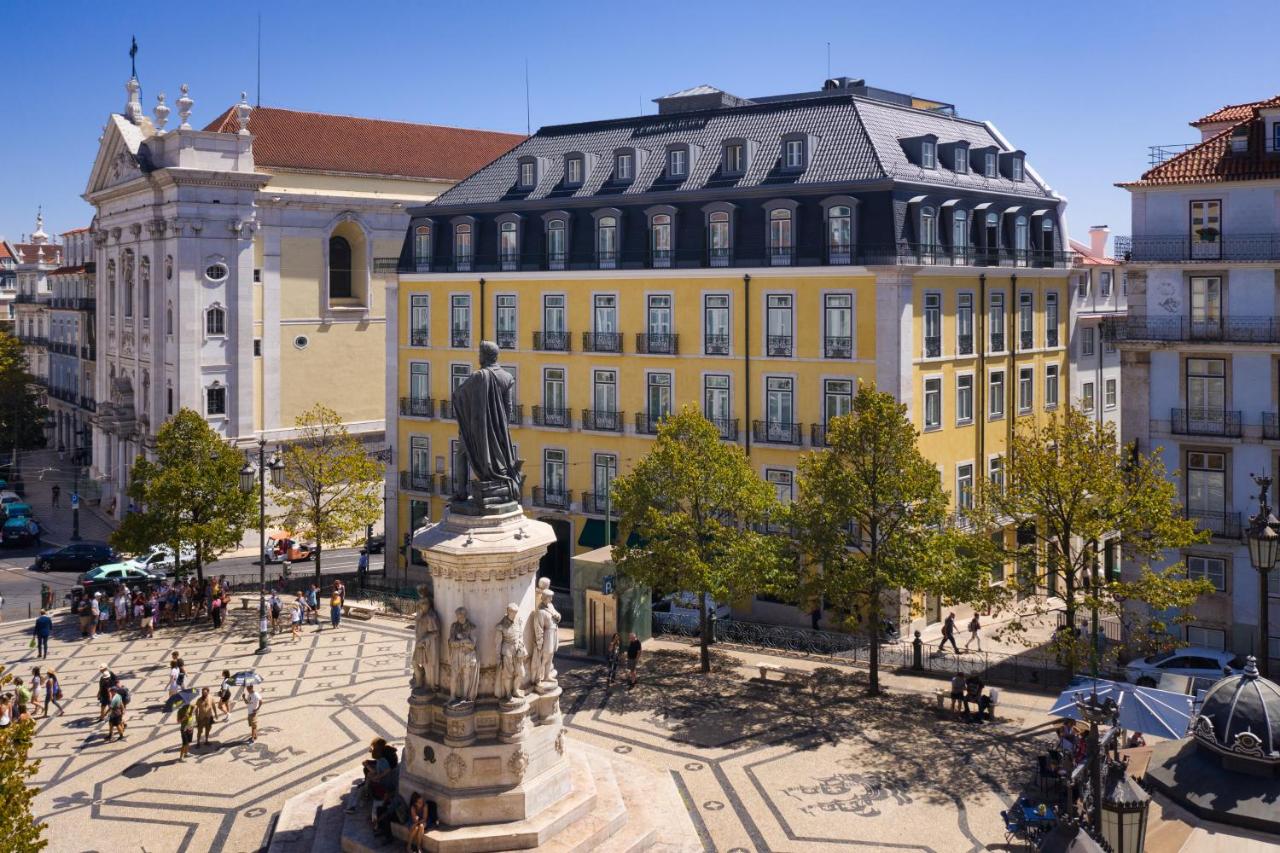
Don’t want to explore Lisbon by yourself? Take a private or group tour of this beautiful city.
We recommend this 5⭐️ Half Day Sightseeing Tour on a Private Electric Tuk Tuk or this budget-friendly Lisbon: History, Stories and Lifestyle Walking Tour .
First things first, my best piece of advice before coming to the sunny capital of Portugal: wear, take, buy, but whatever you do, you MUST have non-slip shoes. This is almost as vital as bringing underwear. Also, bring your appetite for the freshest seafood of your life.
Ready for the ultimate guide on what to do in Lisbon, chock full of travel tips like a guide to Lisbon neighborhoods and info about where to stay in Lisbon? Let’s dive in.
First things first, a little historical background knowledge is in order:
- Lisbon is older than Rome and was founded by the Phoenicians in 1200 BC. The city is known to have seven hills, but this was just to copy Rome. There are, in fact, nine hills.
- Lisbon locals are known as ‘Lisboetas’ and Alfacinhas.’ Not so interesting, but just a cute fact.
- One of the world’s most deadly earthquakes occurred on 1st of November, 1755. Unfortunately, because of this, there were fires and, consequently, a tsunami. Some of the city recovered, and some of it did not.
- From 1932-1974, Portugal was overrun by a dictator, António de Oliveira Salazar. Times were really hard for most big businesses, and people had a ‘secret language’ where they’d speak in code when in public. The dictatorship ended on the 25th of April, 1974, known as the ‘Carnation Revolution’, and each year there is a parade in remembrance.
- The Vasco da Gama bridge is the longest bridge in Europe and has striking views of the city.
- Lisbon boasts two UNESCO World Heritage sites— Mosteiro dos Jerónimos , a maritime-inspired Gothic monastery, and Torre de Belém, a 16th-century landmark tower on the Tagus River.

Guide to Lisbon
Where is lisbon.
So where is Lisbon Portugal located? If you’re planning a trip and traveling Lisbon-bound, it’s good to know a bit about its geography. Nestled in the western part of Portugal , this dazzling capital sits right by the edge of Europe, overlooking the expansive Atlantic.
And guess what? It’s not just the ocean that gives Lisbon its iconic views. And as you can see from the Lisbon map, the Tagus River snakes its way through the city, providing some seriously picturesque scenes. FYI, I highly recommend booking a Lisbon boat trip .
Plus, its prime positioning makes it perfect for travelers itching to explore more: with enchanting day trips like Sintra just a stone’s throw away and transport connections for anyone that wants to head North to Porto or South on the Algarve to Lisbon train.
🤔 Still a little bit on the fence on whether you should visit Lisbon Portugal? Read ► Why Visit Portugal Lisbon? 7 Reasons To Visit The Portuguese Capital
Best time to Visit Lisbon
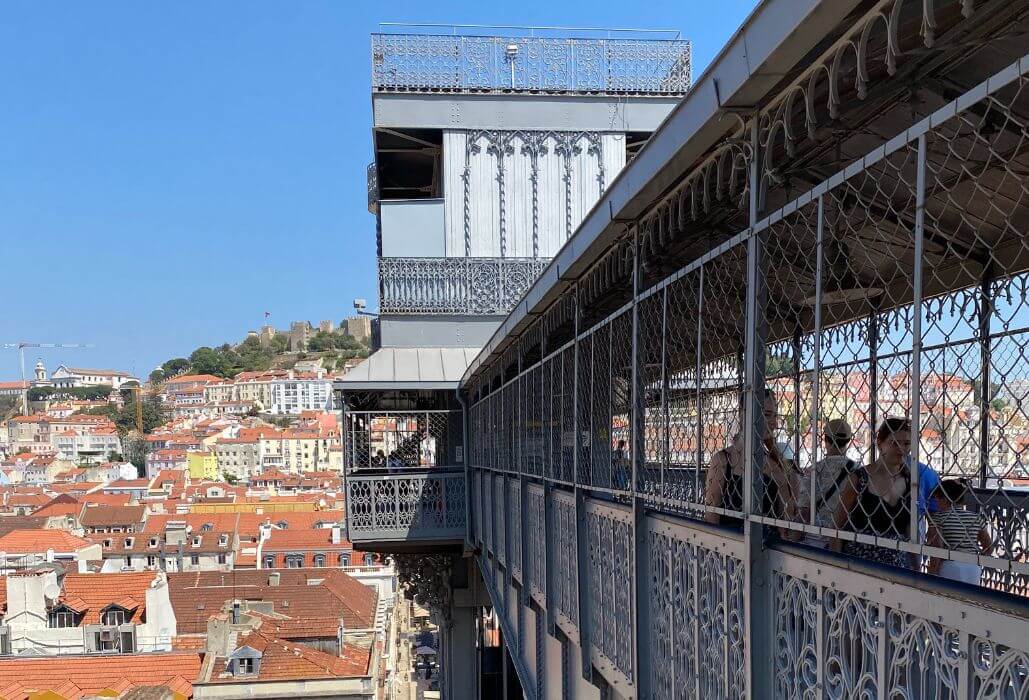
May – June; September – October; Christmas (obviously, you can visit during other seasons )
February could also be an option if you’re keen on Carnaval festivities, but the BEST month is June (13 June specifically) because of Santos Populares, which is when the whole country celebrates the saint from their town by decorating the streets with banners and eating the most delicious grilled sardines and drinking ginjinha. It’s basically a month-long Festa but can be more subtle, depending on the area.
🍒 Ginjinha : Also known as ginja, is a sweet liqueur made from Morello (sour) cherries soaked in a distilled spirit called aguardiente. The mixture is flavored with sugar and spices like cinnamon. It is deceptively sweet, small, and packs a punch.
What to Wear
A travel guide to Lisbon isn’t complete without a guide on what to pack. Did you remember your non-slip shoes? Well, that’s a must, other than that, what you pack really depends on when you will be visiting Lisbon . Here is our travel guide to what to pack for your Lisbon trip:
Spring // Fall
The weather in Lisbon is never too cold, and it starts getting warm around April. In fact, you’ll probably see people already swimming in the ocean as early as March.
Temperatures are warm Apr-Sep, the peak travel time. The warmest (without being too hot) times to travel to Lisbon Portugal are between May-June and Sept-Oct. The weather isn’t too hot and not too cold; it’s just about right. Fun fact, Portugal is one of the best European countries to visit in the fall . So what should you pack?
The months of Jul–Aug are hot, sunny, and dry . So make sure that you pack:
The weather gets much colder from November until March. If you do plan on heading to the city of Lisbon during this period of time, you should pack the following:
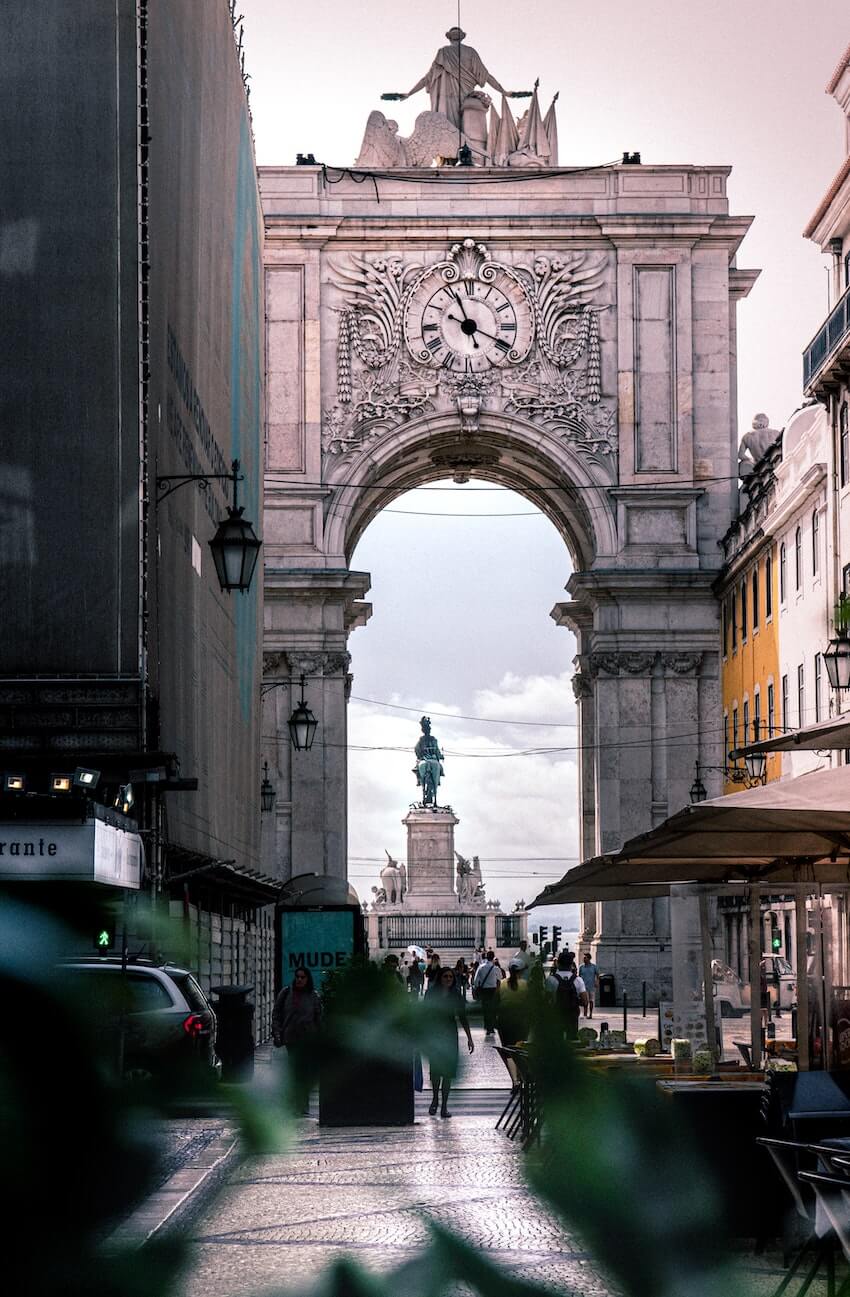
Public Transportation
Public transport in Lisbon is not the absolute best in all of Europe, but better than others . You should have no problem navigating the metro and buses. Plus, the airport is super central. Uber works really well here and is super cheap.
You have probably heard about the famous 28 Tram Lisbon. If you’re on a budget, then try to catch it at the end of the line: Campo de Ourique (Prazeres) instead of at Martim Moniz.
🎫 If you are in Lisbon, consider getting a 24, 48, or 72-hour Lisbon Pass . With this pass, you can enjoy unlimited travel on city transport and free admission to 39 museums, historic buildings, and more. Or you can opt for a Hop-on-Hop Off bus and tram tour with a river cruise .
OTHER LISBON PORTUGAL TRAVEL TIPS: If you want to schedule a walking tour in Lisbon or a tours by locals Lisbon experience, there are a number of great options in the city, like this Lisbon: Food and Wine Walking Tour , Lisbon Tram No. 28 Ride & Walking Tour , or this Lisbon: Full-Day City Private Tour .
If you want a go on a day trip to Sintra , there are a number of great tour options available , including a private tour guide Lisbon. There are plenty of tours in Lisbon, so you’ll be able to book the perfect one for you and your needs.
If you didn’t already know, the official language of Portugal is Portuguese. Do you know how to say Lisbon Portuguese? It’s Lisboa. Here are some more words and phrases that can come in handy during your trip to Portugal:
- Hello (Olá) similar pronunciation in Spanish but a bit more nasally
- Please (por favor)
- Thank you (Obrigado , if you identify as a man & Obrigada, if you identify as a woman)
- Goodbye (Tchau, pronounced like “ciao” if you’re speaking informally & ”Adeus”, if it’s to someone formally, ‘ah dey oush’)
- Quanto custa? (how much does that cost?)
- Você fala inglês? (do you speak English? formally)
So, would you say that Portuguese people mostly speak English and you can get around in the city even if you don’t know a lick of Portuguese? Definitely. Lisbonne Portugal is a touristic city, which means that the majority of people that you will meet while wandering through the cobblestone streets will be able to talk to you in English.
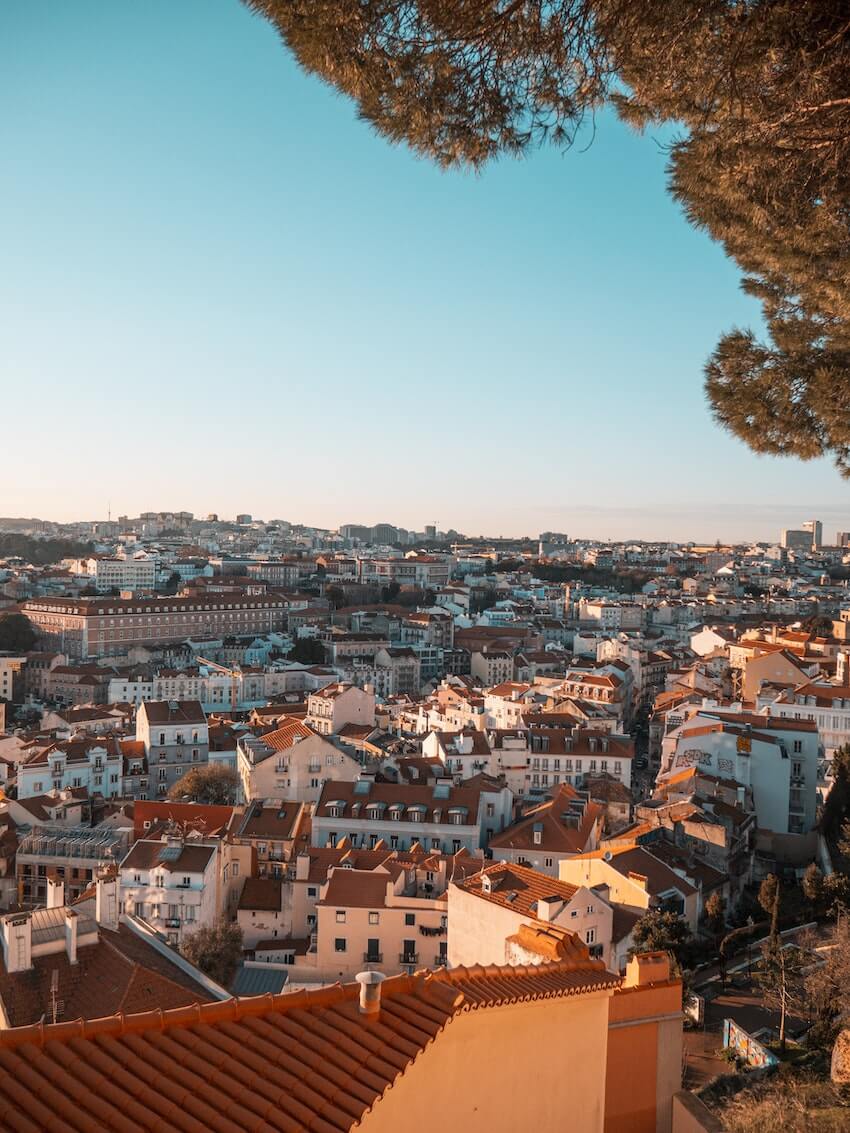
Lisbon Neighbourhoods Guide
There are several different areas of Lisbon you could stay in. There are 24 officially delineated Lisbon areas and many more designated by the Lisbon inhabitants.
Picking the right neighborhood can make all the difference. If you’re on the hunt for trendy spots and stylish hangouts, Príncipe Real is your best bet. For those coming with family, Belém offers a mix of history and spacious parks, making it ideal for both kids and adults.
Dive deep into Lisbon’s essence with a leisurely walk through the charming lanes of Alfama . If it’s your first time in the city, Baixa-Chiado offers a blend of Lisbon’s classic and contemporary sides, placing you right at the city’s core.
For the night owls, Bairro Alto ofers an energetic nightlife scene and in contrast, Campo de Ourique feels like a cozy, little town tucked inside the city. And for travelers who like being at the heart of action, Avenidas Novas is strategically positioned (in central Lisbon), giving you easy access to almost everything Lisbon has to offer.
Where to Stay in Lisbon
📍 Some of the best areas to stay in are: Alfama/Graca, Rossio, Avenida, São Bento, Principe Real, and Santos. Here is a list of my favourite hotels in Lisbon:
- The Vintage Lisbon (📍 Rato ) | A 5* boutique hotel where one-off art & design can be found in every corner.
- The Independente (📍 Bairro Alto ) | A stunning, opulent building originally built as an ambassador’s residence
- The Postcard Lisbon (📍 Rato ) | Understated B&B in a historic house
- Torel Palace Lisbon (📍 Alfama ) | Set on a hillside in downtown Lisbon, this upscale hotel occupies 2 Pombaline-style buildings
- Casa dell’Arte Club House (📍 Alfama ) | An upscale guesthouse in an elegant 19th-century building with a colorful, tiled facade.
- Casa Balthazar (📍 Baixa ) | Quaint adults-only B&B with modern artwork and a gorgeous view over Lisbon
🏨 Looking for some more options? Read our article: The 23 Best Boutique Hotels In Lisbon.
Food & Drinks
From savory seafood dishes and iconic pastries like pastéis de nata to the warming sip of ginjinha and vibrant local wines, Lisbon has several restaurants, brewpubs, and pastry shops ready to treat your taste buds. Let’s explore some of the best:
Best Restaurants in Lisbon
Breakfast (pequeno almoço) – typically, portuguese eat a light breakfast consisting of a croissant/small pastry, an espresso, and an orange juice, but here are some other options for breakfast or brunch:.
- Java (Praca Dom Luis I 30, go through the elevator) → best rooftop view of the city
- Curva (Rua Damasceno Monteiro 108D) → art mixed with food
- Manifest.Lisbon (Rua da Sociedade Farmaceutica 31)
- Tease (found all throughout the city)
- COMOBA → great vegan options
- Café Janis → all-day café
- Fauna & Flora (there are two)
- Hello Kristof / The Mill → specialty coffee, brunch, pastries & magazine store.
- Dear Breakfast (two locations) → All-day brunch
- Amelia (Rua Ferreira Borges 101) → delicious pancakes
- Zenith (Rua do Telhal) → brunch and cocktails
- Clube Caffeine → mostly just coffee and also has some nice cocktails)
// Hipster guide to Lisbon option: if the weather is nice, would be to have a stroll in LX Factory on a Sunday afternoon and have lunch there.
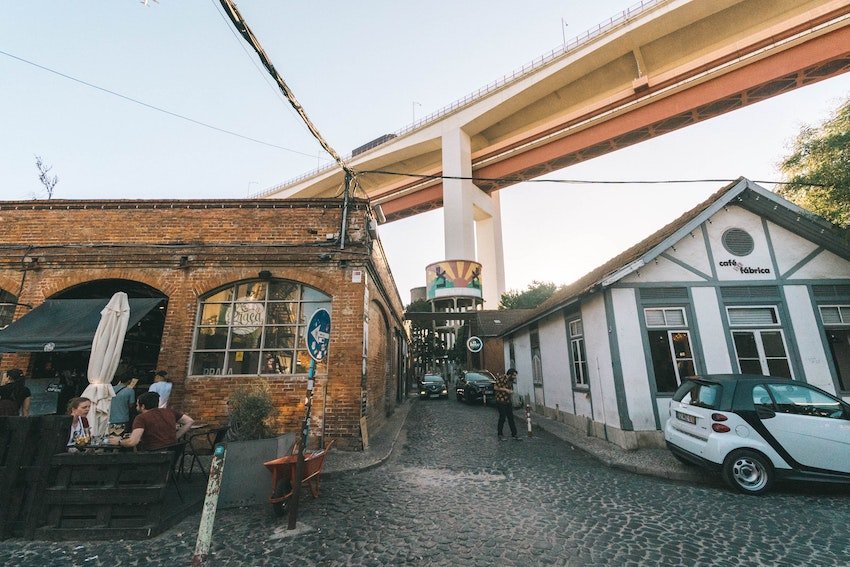
lunch (almoço) + dinner (jantar) — typically, Portuguese eat lunch around 13.00-14 and dinner at 20h/21h, but obviously, you can eat whenever you’d like. Try to eat bacalhau (codfish) because it’s famous around the country! Polvo (octopus) is also fresh everywhere.
- Ramiro → famous place and always has a line outside, so during lunch, it’s usually better, but it’s the best seafood you’ll have in your life
- O Velho Eurico → traditional Portuguese cuisine
- Taberna do Calhau → traditional Portuguese cuisine with a modern twist
- Senhor Uva → only local products with a modern twist
- SEM Restaurant → restaurant & wine bar which cooks with regenerative food and without a bin
- Ultimo Porto → opens only for lunch and has wonderful seafood
- Raizes → traditional Portuguese cuisine with a modern twist
- Time Out Market → a largely closed space food court with a huge variety of different food options
- Casa do Alentejo → traditional Portuguese cuisine from the region of Alentejo
- O Tachadas → authentic, no-fuss Portuguese cuisine in Madragoa (do order the steak)
- Tasquinha Ilha do Madeira → typical food from Madeira, and you must get a poncha drink
- Taberna Portuguesa → traditional Portuguese cuisine from the region of Alentejo
- Cantinho d’Ourique → authentic, no fuss Portuguese cuisine in Campo de Ourique
- Lisboa Tu & Eu → cute lunch spot with small plates
- Taberna Sal Grosso → a modern take on Portuguese dishes
- Adega do Kais → expensive, but you basically eat inside of an obnoxious castle but seriously incredible food
- Sala de Corte → If you’re wanting to have a high dining experience because the chef is famous and has many restaurants in Lisbon
- The Food Temple or O Gambuzino → both restaurants are vegan-friendly
// If you have time to kill one afternoon or for sunset, we highly suggest hopping on the ferry from Cais do Sodré Fluvial Terminal to Cacilhas and then walking to the restaurant Ponto Final in Almada to eat! You should definitely make a reservation as tables fill up quick!

If Portuguese cuisine isn’t your groove, here’s a list of the best international restaurants:
- Mezze → middle eastern tapas style restaurant run by Syrian refugees
- Tantura → middle eastern restaurant
- Aura Dim Sum Lab → handmade dim sum
- Farès → Lebanese food
- El Taco Chingo n → Mexican food
- Las Gringas → Mexican food (takeaway and delivery only)
- Retrogusto84 → best pizzeria in Lisbon
- Boa-Bao → Chinese/Thai fusion and is very aesthetically pleasing inside
- “Illegal” Chinese Clandestine → these are located around the area of Martim Moniz. Rua Guia 9, go to the second floor. Oriental Dongfong Dumpling is also tasty
- A Cevicheria → (famous spot so I would try to go early if you can)
- Paco Bigotes → best tacos along the river Tejo
dessert (sobremesa) —we have a rather large sweet tooth, but honestly, Portuguese sweets don’t excite us so much because typically they’re a bit too dry or too sweet, but they can do a wonderful chocolate mousse. I would suggest gelato if the weather is nice, either from Nannarella or Gelato Davvero (Italian-owned.)
It would be breaking the law, practically, if this article didn’t mention the staple of Portuguese sweets: the pastel de nata .
Only three people on earth know the secret recipe of the original pastéis from Belém, which are obviously the tastiest ones (no further comments) so make sure to visit the shop while in Lisbon.
Other incredible pastelarias include:
- Manteigaria
- Pastelaria Cristal
- Pastelaria Santo António

BrewPubs for Beer (Cerveja)
There are two main beers in Portugal called Super Bock and Sagres, which you can find everywhere, but if you’re keen on trying some breweries:
- Sputnik Craft Beer
- Delirium Lisbon
- Dois Corvos
- Duque Brewpub
- Quimera Brewpub
wine Bars (vinho)
Wine in Portugal is absolutely phenomenal and SO CHEAP here! Opt for red wine from Alentejo, Douro, or the region Dão . White wine is good from Setúbal, Alentejo or Monção e Melgaço. Moscatel from Setúbal is delicious but is a bit sweeter.
Vinho Verde (green wine, but not really green) is from its own region in the north and is best during the summer because there is little carbonation and less alcohol content. Vinho do Porto is typically drunk after a meal and is a must-try while in Portugal.
- BlackSheep → Portuguese wine bar run by Americans actually and is super cozy
- Tati → also a tapas place and is AMAZING
- Senhor Manuel → just recently opened . The owners also own Senhor Uva.
- Bythewine → an excellent choice for drinking wine by the producer Jose Maria da Fonseca, from Setúbal
- Jobim → our go-to wine bar owned by Brazilians with some tapas and fun vibes
- The Wine Cellar
Here are some places where to purchase wine: BlackSheep, Terra Wine Shop, Ladidadi Wines, and Garrafeira Estado D’Alma
Bars & Cocktails
- Café Janis → happy hour literally from 19-20h on Fridays. I come here quite frequently so you might find me here on a Friday, aha
- Onda Cocktail Room
- Java → beautiful rooftop bar
- Lumi Rooftop
- Tasca do Chic o → go at 9 pm for Fado music or go earlier to eat and stay
- Tasca Mastai → the only place I go in Lisbon for an Aperol Spritz if you’re feeling Italian
- Casa Independente → probably my favorite place for drinks in Lisbon , but also for the dancing on the weekends
- Park Ba r → rooftop
- Topo Martim Moniz → rooftop
- Rio Maravilha → rooftop
- Zazah Good View → rooftop
- Madame Petisca → rooftop
- Ferroviário → rooftop
- No13 Lisboa
- Café de Garagem → roof and inside seating
- anywhere in Bairro Alto~
- any kiosk around Lisbon!
- Incognito
- Plateau (80s jams)
- Lux CLUB (great for dancing! Arrive around 2 AM)
For some great clubs and bars, make sure to head on over to Pink street
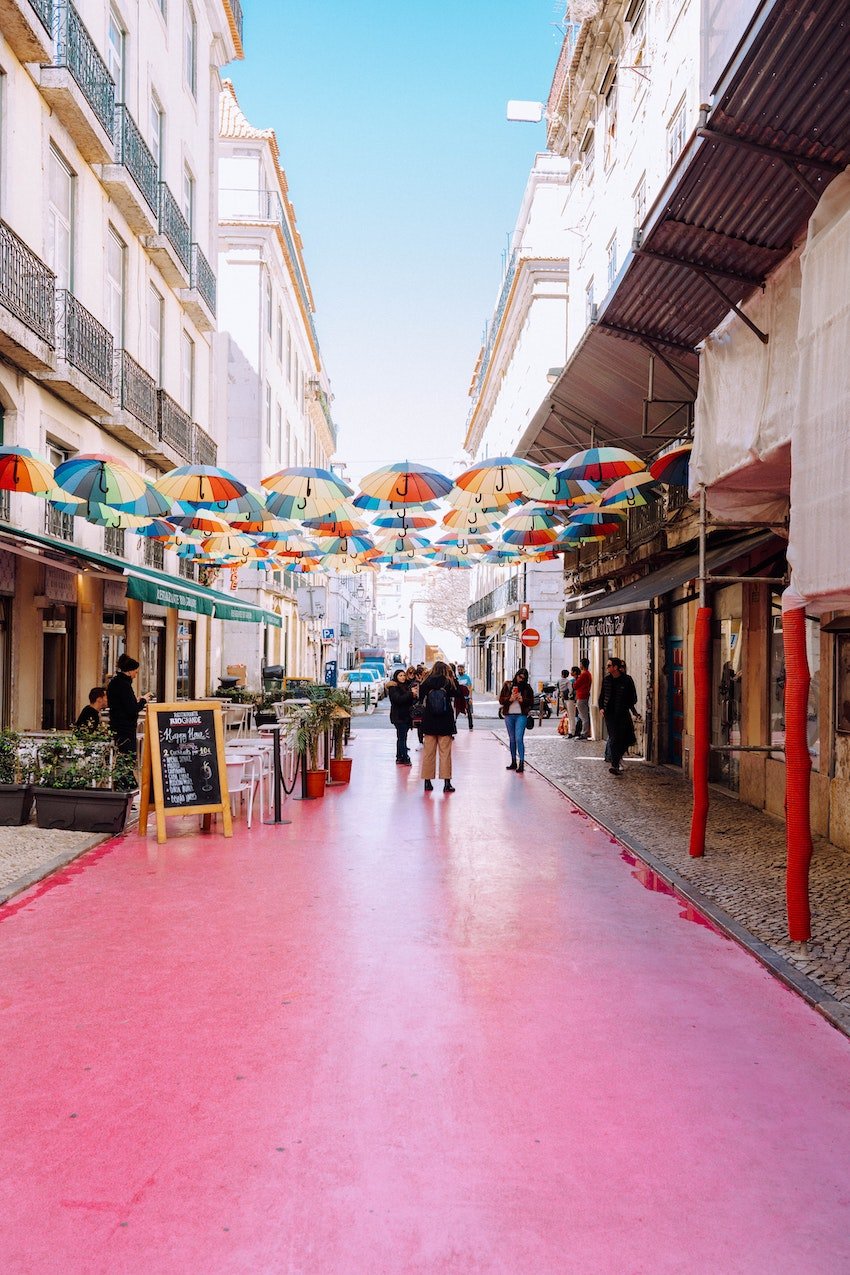
Things to See
Planning a Lisbon visit? Once you’ve finished eating and drinking, take a walk and see some of these amazing sights in and around Lisbon, Portugal. Here are some attractions of Lisbon for the perfect visit in Lisbon:
- Comércio Square
- Alfama district ➡ head to a Fado show.
- A Visit to Belem ➡ Some Belem Lisbon highlights include the iconic Belem Tower, Jerónimos Monastery, Monument to the Discoveries, and the famous Pastéis de Belém bakery.
- Museu Nacional do Azulejo
- National Pantheon
- Palácio dos Marqueses de Fronteira (a bit out of the city, but you could always take an Uber as it is stunning)
- Santa Justa lift
- São Jorge Castle
- Convento do Carmo
- Aqueduct Lisbon ➡
- Oceanário de Lisboa (Aquarium Lisbon) ➡ an aquarium in Lisbon
- National Museum of Contemporary Art ➡ MNAC is a must-see for those wanting to learn about and enjoy Portuguese romantic, naturalist, modern, and contemporary art .
Most weekends, there are little markets all over the city! Looking for a city guide to Lisbon’s off-the-beaten-path gems? Basically, a small guide to Lisbon? Check out our article about Lisbon’s 10 hidden gems .
best Spots For A Sunset
- Miradouro da Santa Catarina
- Miradouro de Santa Luzia… walk a little further for Portas do Sol
- Miradouro de São Pedro de Alcântara (newly reopened)
- Jardim do Torel (bit of a walk but nice views)
- Miradouro da Senhora do Monte (highest point in Lisboa and has best view of the city but also is quite a hike up)

Escaping the City
Our city guide to Lisbon wouldn’t be complete if we didn’t mention some weekend getaway destinations .
⭐️ Some of the best day trips from Lisbon include Sintra, Cascais, Azenhas do Mar, Obidos, Costa da Caparica, and Sesimbra. But that’s just the tip of the iceberg. If you want to learn more about what to do around Lisbon, you’ll love this article 👉 20 Best Day Trips From Lisbon.
If you are looking to escape the city for the day, then here are some day trips that you can go to:
- Take the train to Sintra, take the bus to Pena Palace, or take an organized tour .
- Monserrate Palace is beautiful!
- Castle of the Moors
- Eat at Cafe Saudade
- Cabo da Roca (the most western point of Europe)
- Piriquita – famous pastry shop
For more information about a day trip to Sintra from Lisbon, make sure to read our article: A Sintra Day Trip: Your Complete Guide . If you are looking to do a day trip to Cascais from Lisbon, many of the Sintra tours from Lisbon offer a stop in Cascais.
Along the Cascais line , the best beaches are São João and São Pedro do Estoril.
Along the Sintra line, the best is Praia do Guincho, Praia da Ursa, Praia da Adraga, and Praia das Maçãs . If you have time, check out Azhenhas do Mar.
If you have a car, drive across the April 25th bridge to Costa da Caparica or Fonte da Telha . However, the best beaches are in a national park called Arrabida : Ribeira do Cavalo and Praia de Galapinhos. These can also be done as a day trip from Lisbon.
⭐️ If you plan on taking a road trip to Porto, there are a number of beautiful stops along the way. Here are ten amazing places that you can visit if you are driving from Lisbon to Porto. Also, here are a couple of day trips you can take from Lisbon.
Guide to Lisbon: Frequently Asked Questions
How many days do i need in lisbon.
Three days in Lisbon gives you a solid introduction to the city. In that time, you can hit up the major attractions and enjoy the local food.
If you want to explore outside the city, like the fairytale town of Sintra or the beach areas of Cascais , add a few more days.
And if you’re thinking about visiting Porto or the Algarve, you might want to extend your stay. The Algarve is known for its picturesque coastline, which stretches approximately 200 kilometers (about 125 miles). So you’ll need at least 3-4 days to explore.
Are 3 days in Lisbon too long?
Not at all. With its rich history, beautiful architecture, and vibrant neighborhoods, there’s plenty to do in Lisbon. Three days will allow you to explore without feeling rushed, and you’ll still have some downtime to just relax and soak in the atmosphere.
Is Lisbon friendly to American tourists?
Absolutely. Lisbon is a popular destination for many, including Americans. The locals are known for their friendliness and hospitality. So, expect a warm welcome.
Do they speak English in Lisbon?
YES — especially in the main tourist areas of Lisbon, Porto, and the Algarve . Many of the restaurants, shops, and attractions will have English-speaking staff. But, as you venture into less touristy areas, it might be less common, so knowing a few basic Portuguese phrases could be helpful.
What is better Porto or Lisbon?
It’s hard to choose! Lisbon is the bustling capital, renowned for its historic districts, tram rides, and ocean views. Porto, on the other hand, offers a unique blend of riverfront vistas, iconic blue-tiled buildings, and of course, the world-famous port wine. Both cities have a distinct charm, and your preference might depend on your interests.
Is Lisbon a walkable city?
YES — walking is one of the best ways to explore Lisbon. But a heads up: the city is known for its seven hills, meaning there will be some uphill and downhill walking. Good, comfortable shoes are a must.
If you don’t want to walk around Lisbon Europe by yourself, there are plenty of walking tours that you can go on, including the Free Walking Tour Lisbon. For a list of the best walking tours Lisbon Portugal has to offer ► 12 Best Lisbon Walking Tours: From Cobblestones To Castles .
What is the best time to visit Lisbon?
The months of May, June, September, and October, also known as the shoulder seasons are usually the best times. The weather is mild, not too hot or cold, and you avoid the summer tourist rush, which means fewer crowds at popular spots.
Is Lisbon cheap or expensive?
Relative to some other European cities, Lisbon can be more budget-friendly. Dining and accommodations often come at a better price. However, how much you spend also depends on your plans and choices. Planning and budgeting ahead can help you get the most out of your trip.
How Do Your Pronounce Lisbon?
Lisbon is pronounced as “lihz-buhn” in English. However, in Portuguese, it’s “Lisboa” and pronounced approximately like “leesh-BOH-uh”. If you’re traveling to Portugal, you’ll likely hear the Portuguese version more often.
In some languages, the name for Lisbon does sound more like “Lissabon.” For instance:
- In German: Lissabon
- In Dutch: Lissabon
- In Swedish: Lissabon
In these languages, the pronunciation would be closer to “LISS-ah-bon” or “LISS-uh-bon.”
So while “Lissabon” is not the English pronunciation, it is correct in other languages. If you heard “Lissabon,” it could be from someone speaking one of these languages or a similar one.
More Lisbon Travel Guides & Articles

Hopefully, this ULTIMATE tourist guide to Lisbon gave you a good foundation to jump off. Remember that Portugal is not just Portugal Lisbon city and Porto, so make sure to go and explore a little bit.
If you’re looking for more info on traveling to Lisbon, Portugal, check out these additional Lisbon travel blogs, Lisbon guides, and related articles:
- 20 Best Day Trips From Lisbon: Incredible Places To Visit
- The 12 Best Walking Tours Lisbon Portugal
- 15 Best Boat Tours In Lisbon: An Unforgettable Guide to Lisbon
- 40 Best Sights In Lisbon: A Rough Guide to Lisbon
- Wine Tours In Lisbon: 12 Amazing Sip And Savor Experiences
- 15 Food Tours In Lisbon: A Guide To The Best Eats In The City
- Visiting Lisbon? The Best Area To Stay In Lisbon
- 15 Best Guide Lisbon Tours for the Ultimate Sightseeing Experience
- The Best Fado In Lisbon: 11 Fado Houses To Explore
- Looking for An Adventure? The Best Outdoor Activities in Lisbon (and around Lisbon)
// So, hopefully, this little city guide to Lisbon helps you on your way to exploring Lisboa! But don’t worry if you fall in love with the city (or the incredibly kind people) after the first day! And remember your non-slip shoes and travel insurance (just in case)
boa viagem!
Yvonne Ivanescu is the founder of Now in Portugal and Now in Rio Swim, an ethical and sustainable swimwear company. She is a writer, editor and marketer with over 10 years of experience.
Storytelling is her second nature and she wants to share the magic of Portugal with the rest of the world.
Similar Posts
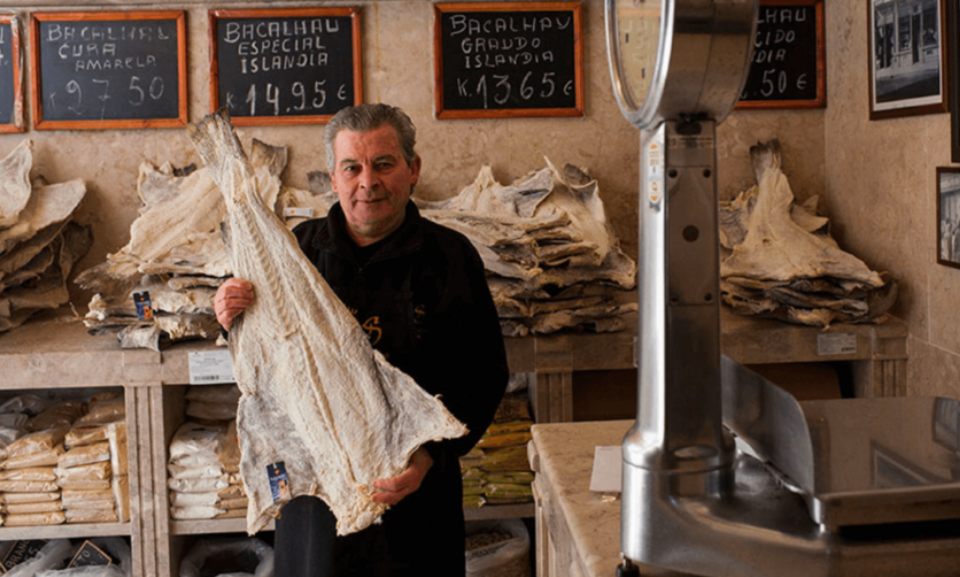
15 Food Tours in Lisbon: A Guide to the Best Eats in the City
Looking for the best food tour in Lisbon, Portugal? You’ve come to the right place because this guide will highlight the 10 best Lisbon Portugal tours to experience all this unique (and delicious) cuisine has to offer.
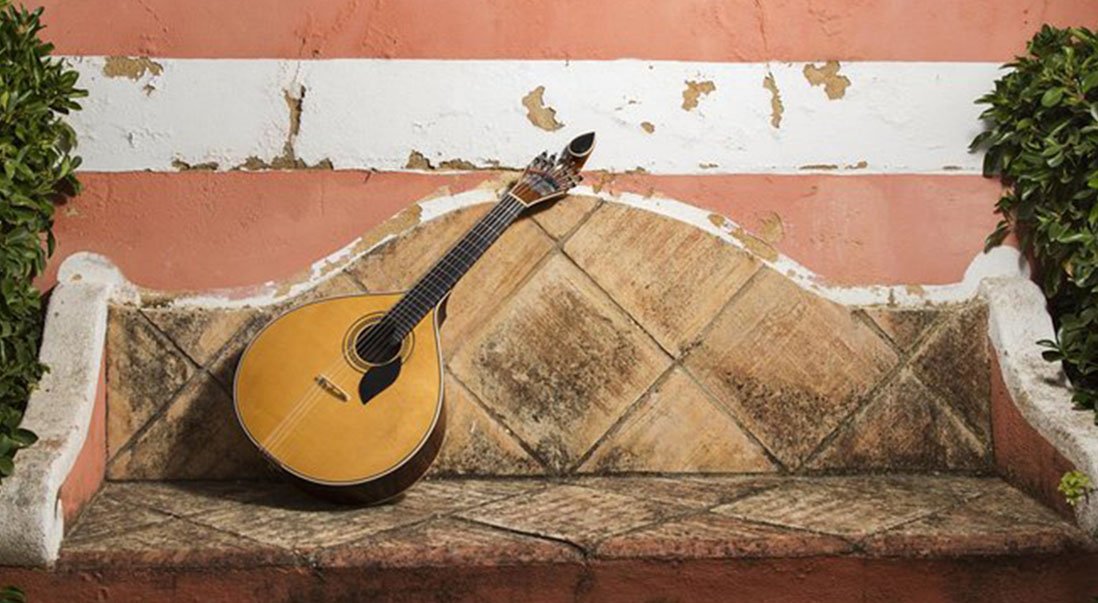
The Best Fado in Lisbon: 11 Fado Houses to Explore
Fado is more than a music genre; it is a feeling. You should listen to or watch a live performance to understand its magic. Keep reading this article to learn more about fado and also to learn about where you can experience the best fado in Lisbon.
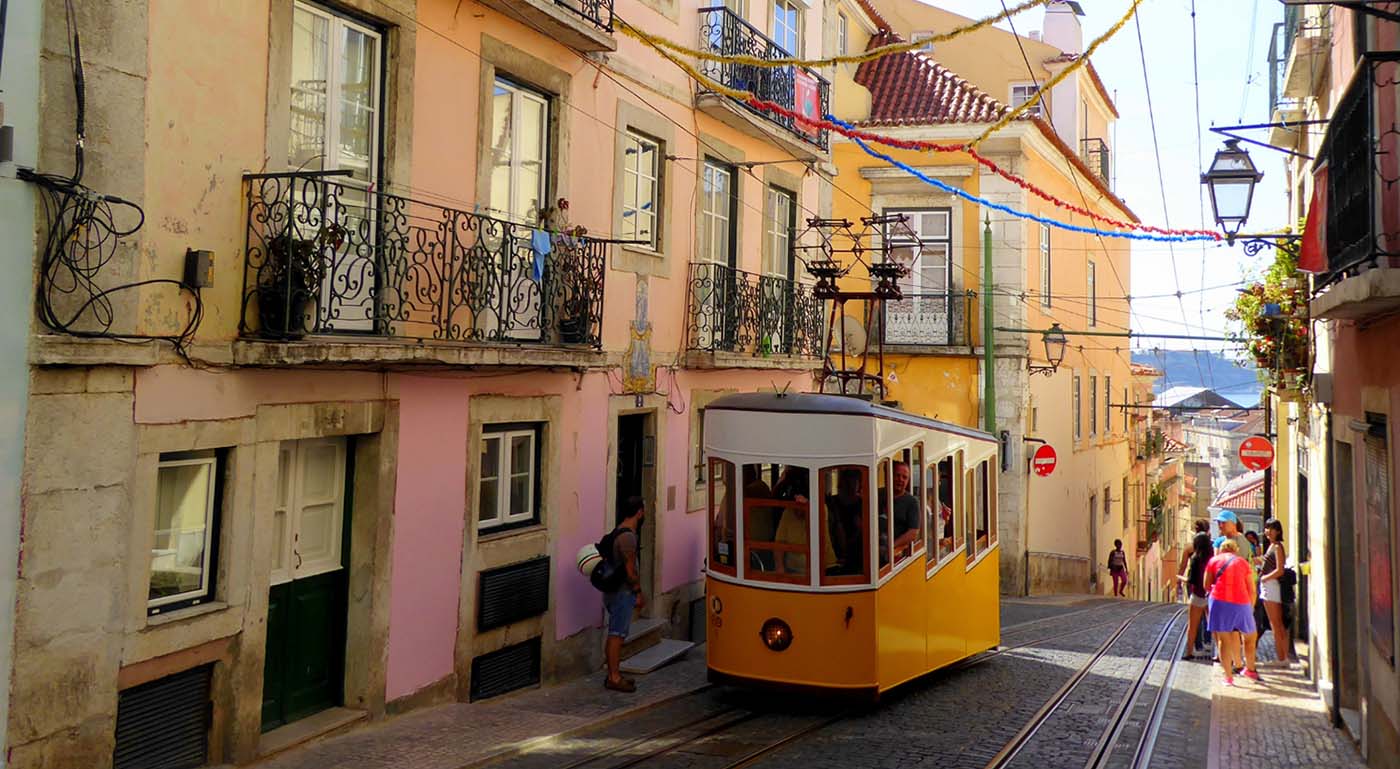
The 23 Best Boutique Hotels in Lisbon
And if you are looking to book a stay in Lisbon, the options are endless and quite unique. Fancy staying in an 18th-century palace? Or how about booking a room in the former Brazilian consulate? This article is full of the best boutique hotels in Lisbon, perfect for any stay in the city.
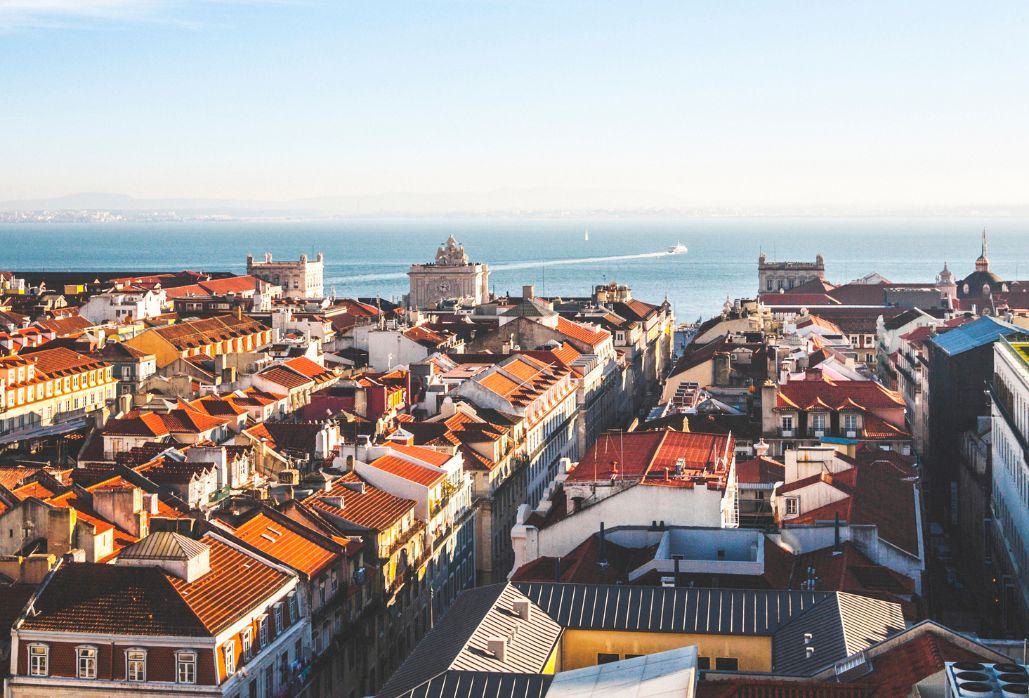
12 Best Lisbon Walking Tours: From Cobblestones to Castles
There is no better way to explore Lisbon than by foot. Discover the 12 top Lisbon walking tours in this ultimate guide.

Lisbon Off the Beaten Path: 10 Hidden Gems
If you have crowd fatigue or if you want to delve a little deeper into the bones of this city, here is a guide to the top Lisbon off the beaten path spots. .
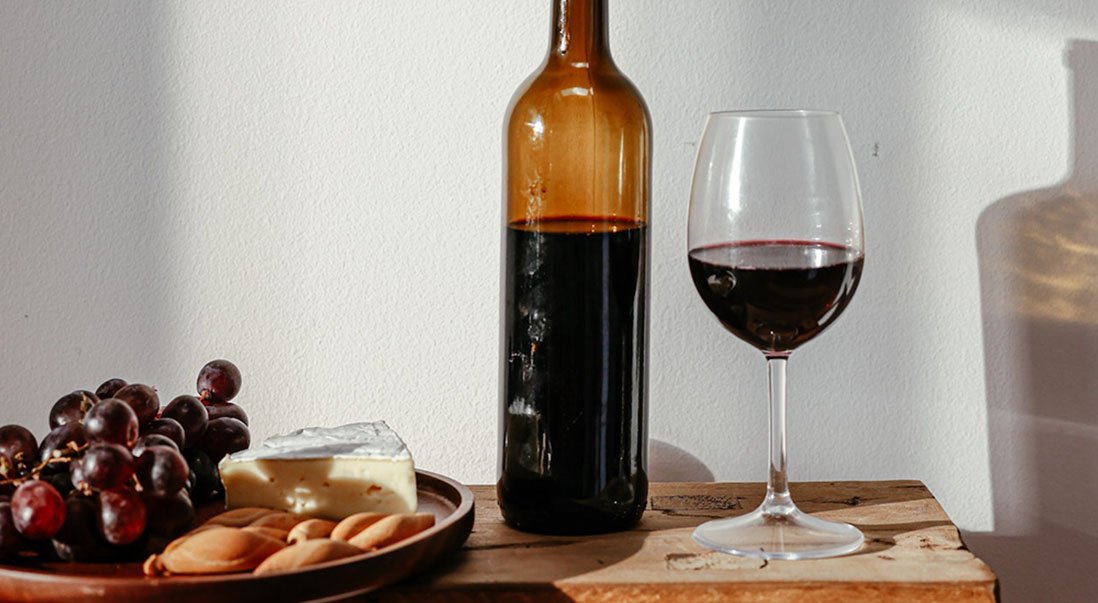
The 7 Best Wine Shops in Lisbon
Perhaps you’ve never been formally introduced to the fascinating world that is Portuguese wines. And that is perfectly justifiable but you should give it a go rather sooner than later, as you will thank me later. Here are our top 5 best wine shops in Lisbon where you can purchase wine by the best shop owners and producers:
I’m moving to lisbon this year. Great article
So happy that it helped you!
Thanks a lot for your great article, it is helping me a lot to plan my travel in end of may / early June 🙂
I’m very excited about planning my trip to Lisbon, and your guide has been incredibly helpful. The history you’ve included makes the city even more intriguing. I love the idea of celebrating Santos Populares in June with the local traditions and food, particularly the ginjinha!
Your advice on footwear is duly noted, it makes perfect sense considering the city’s hilly terrain. Also, your seasonal packing guide will definitely come in handy.
Finally, I really appreciate your recommendations for tour options, especially the Food and Wine Walking Tour, which is right up my alley! I’m looking forward to my trip. Thanks for the comprehensive guide and cant wait to visit Lisboa.
I am so happy it helped you!
Leave a Reply Cancel reply
Your email address will not be published. Required fields are marked *
If You Love the Website, I’d Love the Support ❤️
There’s no paywall here. Consider Donating To My Coffee Fund and help me keep delivering amazing Portuguese-related content to you.
About Portugal
Lisbon Porto The Algarve Central Portugal Moving to Portugal Living in Portugal Ultimate Guides
About Us Contact Us Travel Planning (Coming Soon)
© 2023 Now in Portugal | Privacy Policy | Disclosure Policy | Terms & Conditions
Best Time to Visit
Neighborhoods to Know
Public Transportation Guide
48-Hour Itinerary
Day Trips From Lisbon
Top Things to Do
Free Things to Do
Beaches Near Lisbon
Lisbon's Coolest Architecture
Where to Drink Port Wine
Top Restaurants
Nightlife Guide
Your Trip to Lisbon: The Complete Guide
:max_bytes(150000):strip_icc():format(webp)/d0598453a36aa6f71cb57cc8be377f9de9d6b98d-582c8418c5d24bcbb4ccdfcbf6293fce.jpg)
Lisbon, Portugal’s capital, is one of the oldest cities in the world. It offers stunning contrasts between historical sites, modern architecture, lively neighborhoods, parks, and world-class festivals.
Planning Your Trip
- Best time to visit: Lisbon boasts 290 days of sunshine , but the best times to visit are spring and fall. The weather is warm and stable, lines at attractions are shorter, and accommodation prices are at their lowest.
- Language: The official language is Portuguese . English is widely spoken, and Spanish is often understood.
- Currency: Currency is the euro. Major credit cards are widely accepted, but always have some ready cash for coffees, snacks, and taxis.
- Getting around: The most spectacular and popular way of getting around is by the two tram lines . But there can be long lines and they are quite expensive. Buses are faster and cheaper, and the metro is also a popular method of transport. Taxis are not too expensive but taxi drivers are prone to "flash strikes." For more freedom and spontaneity, you can also hire bicycles or rent a car if you plan to go outside city lines or to the beaches.
Things to Do
Riding the historical tram no. 28, visiting the 16th-century Torre de Belem at the river Tagus and the Monastery of St Jeronimos, and exploring historical neighborhoods like Alfama are just a few of the many things to do . For breaks between attractions, stop for some " pastel de Belem " to recharge your batteries after your long walks.
Ride tram 28: The yellow, historical tram takes you on a journey through the most popular districts of Lisbon, rattling through impossibly steep and narrow streets, making it a unique sightseeing tour not to be missed.
Torre de Belém: The 16th-century tower of Belém on the north shore of the river forms part of a defense system and is one of the most famous landmarks of Lisbon. A UNESCO World Heritage site , the tower offers you a look at the architecture from that time and also insight into the country’s relationship with other societies from around the world, notably South America.
25th April Tagus bridge: Walk across another Lisbon landmark, the red suspension bridge over the Tagus River , for a panoramic view of the city. Often compared to San Francisco’s Golden Gate Bridge because of its color, it was actually built by an American company and was the site of a car chase in the 1969 James Bond movie "On Her Majesty’s Secret Service."
Explore more Lisbon attractions with our articles on the best things to do and also the best budget-friendly things to do .
What to Eat & Drink
Lisbon is a cosmopolitan city which means you can find just about any food you fancy, even the most exotic. But your trip to Lisbon should focus on the dishes and drinks that are typical to the city.
Lisbon loves stews, prepared with the freshest local ingredients like fish and seafood, pork, vegetables, cilantro, and ham. Try the sandwich called Bifana, the ever popular soup Caldo Verde, and a delicious seafood stew known as Cataplana de Marisco. For a sweet tooth, indulge in pastel de nata .
No meal in Lisbon is complete without wine and a liqueur for digestion afterwards. The best table wines are Porto and Vinho do Douro as well as Madeira. Liqueurs you should try are Beirao and Ginja, made from cherry-like berries fermented in Brandy. If you prefer beer, the most popular brand is Sagres.
For a night on the tiles with all the food, music, and drink, you want start in Bairro Alto and move on from there until 3 or 4 a.m. if you have the stamina.
Explore our articles about Portuguese food and drink .
Where to Stay
Where to stay depends on your budget, the length of your stay, what you want to do and see, and whether you travel as a couple or with kids. Luckily, Lisbon offers a solution for all options.
If you have only one or two days and want to see as much as possible without spending time on public transport, the neighborhoods of Baixa, Chiado, or Rossio are right for you. Rossio is one of the few flat areas in Lisbon. All the major sites are within walking distance, and if you want to reach Bairro Alto (for the nightlife for instance), there is an elevator. Baixa is the main shopping area, Chiado is lively with cafes, restaurants, and book stores, and both are also close to all landmarks.
If you have more time or want to experience the old Lisbon, Alfama should be your choice. It’s the oldest neighborhood in Lisbon , which survived the earthquake of 1755. Great for pubs and atmosphere but it's on top of a hill, so be prepared for a lot of climbing and use of elevators.
From Cais do Sodre, you can reach the other side of the river and are well connected to public transport including trains to other parts of the country. (You aren’t in walking distance of major sites, though.)
Explore the the best neighborhoods to stay in Lisbon.
Getting There
Lisbon’s international airport is Humberto Delgado (previously known as Portela Airport). The airport has two terminals: T1 is the major hub, and T2 caters exclusively to low-cost airlines. Connections to the city can be made by metro (the stop lies at the southern end of T1), bus and Aerobus for passengers with bulky luggage, or taxi. Metro and bus passengers must purchase a 7 Colinas/Viva Viagem Card which can be topped up and used on all Metro and Bus lines.
Lisbon is also a popular destination for cruise ships, so you may be arriving on a cruise and heading for a land excursion. The terminal stretches along the river Tagus, and there are five docks, the most important being Santa Apolonia and Praia da Rocha. Santa Apolonia is closest to the city center, but there are good connections from all of them.
Culture and Customs
Portugal does not have a tipping culture like the U.S. does, but it's always appreciated. The safest bet is to round up the bill to the next whole number or so. If, for instance it comes to 7.75 euros, leave 8. Be aware that sometimes a 10 percent service charge is already added, in which case you shouldn't tip at all.
Money Saving Tips
Free walking tours: If you wish to explore Lisbon in the company of others and a knowledgeable guide, go on a free walking tour. https://www.discoverwalks.com/tour/city/lisbon-walking-tours/
Free admission to museums: Some museums are free on Sundays, others on Friday, but always free of charge are: Berardo Collection Museum (modern art), and the Archaeological Museum.
Free concerts: Lisbon is a city of culture and music with art and music festivals year around.
Public transport and admission fees: If you plan to stay longer than a day, get the Lisboa Card . You can purchase it for 24 hours, 48 hours, or 72 hours, and it also includes free admission to more than 30 Lisbon attractions. Buy online and collect at the airport.
Turismo de Lisboa Visitors & Convention Bureau . "Why Lisbon?"
Turismo de Lisboa Visitors & Convention Bureau . "Useful Information."
UNESCO World Heritage Centre . "Monastery of the Hieronymites and Tower of Belém in Lisbon."
Turismo de Lisboa Visitors & Convention Bureau . "Alfama, Castelo."
15 Top Things to Do in Lisbon, Portugal
Your Trip to Budapest: The Complete Guide
Getting Around Lisbon: Guide to Public Transportation
Your Trip to Boston: The Complete Guide
Lisbon Travel Guide
Washington, D.C. Guide: Planning Your Trip
San Antonio Guide: Planning Your Trip
Where to Stay in Lisbon: The City's 5 Best Neighborhoods
Cairo Guide: Planning Your Trip
Your Trip to Denver: The Complete Guide
The Top 8 Attractions in Bairro Alto, Lisbon
Your Trip to San Francisco: The Complete Guide
Your Trip to Alaska: The Complete Guide
Your Trip to Shanghai: The Complete Guide
Your Trip to Rome: The Complete Guide
Dublin Guide: Planning Your Trip
Nomadic Matt's Travel Site
Travel Better, Cheaper, Longer
Lisbon Travel Guide
Last Updated: September 1, 2023
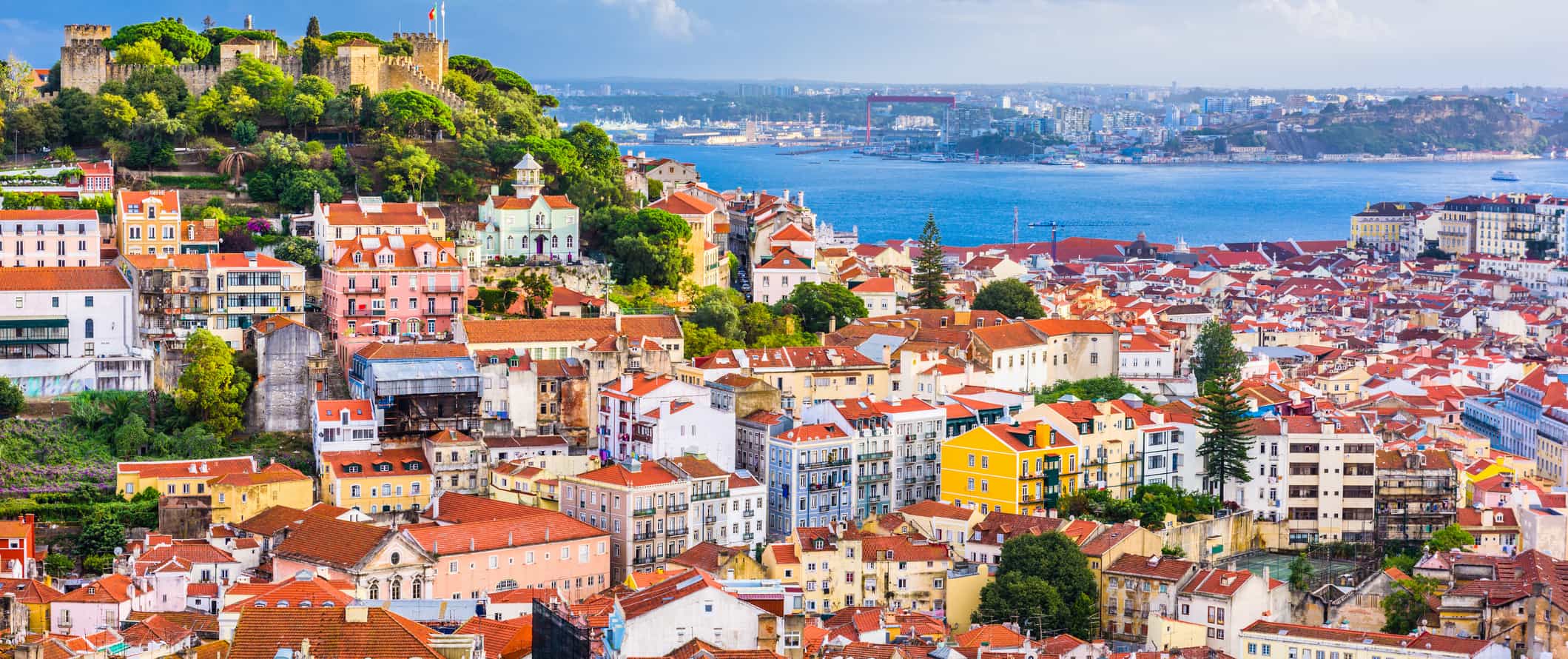
Situated along the south of the country’s west coast, Lisbon ( Lisboa in Portuguese) boasts an incredible mix of museums, historic buildings, eclectic music, a wild nightlife, charming plazas, and laid-back cafés where you can watch the world go by.
In recent years, Lisbon has become a lot more popular thanks to its inexpensive cost of living and lovely year-round weather. While it’s not the hidden gem it used to be (there’s a growing expat and digital nomad community here now), I don’t think it’s lost its magic — especially if you visit during the shoulder season when the weather is still great and the crowds have thinned out.
This Lisbon travel guide will give you everything you need to plan your trip, save money, and make the most of your time in this underrated European capital!
Table of Contents
- Things to See and Do
- Typical Costs
- Suggested Budget
- Money-Saving Tips
- Where to Stay
- How to Get Around
- How to Stay Safe
- Best Places to Book Your Trip
- Related Blogs on Lisbon
Top 5 Things to See and Do in Lisbon
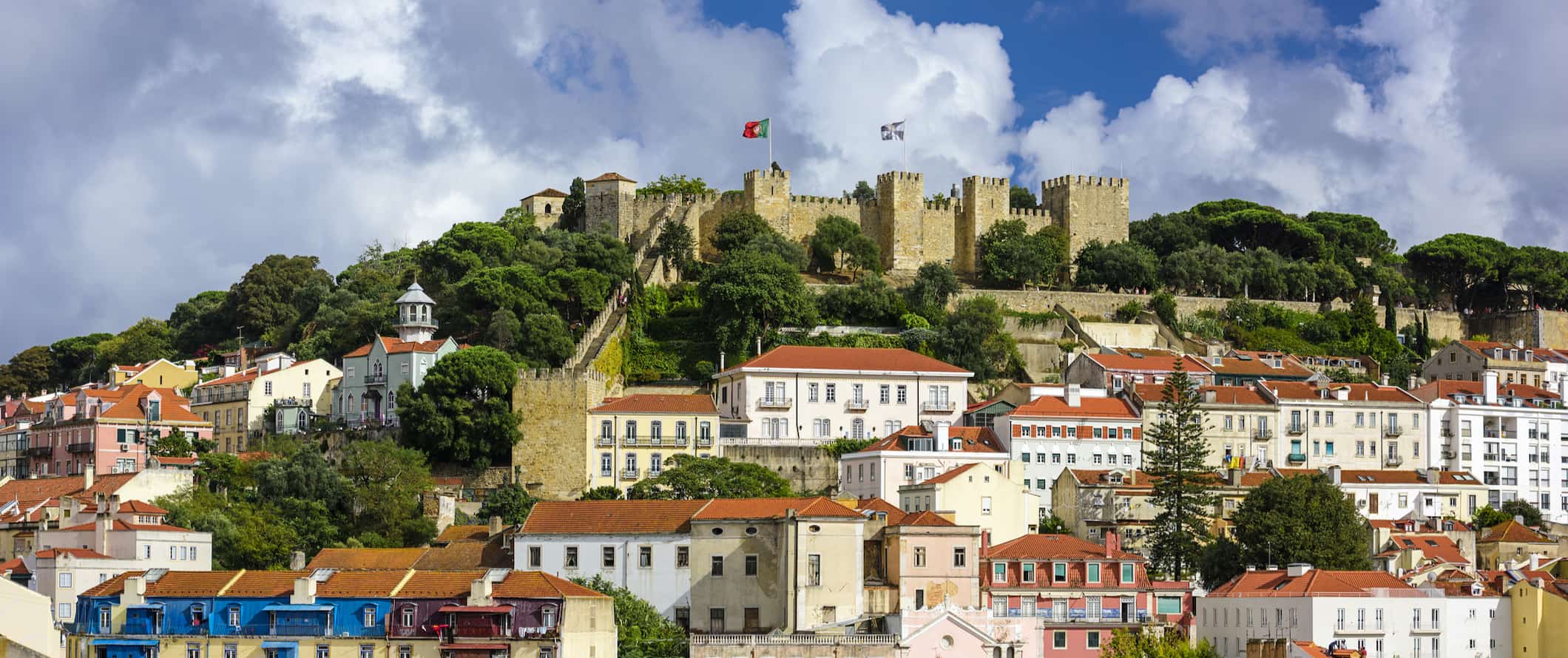
1. Walk around the Old Town
Alfama, the historic area of Lisbon, is filled with narrow, winding streets lined with shops, cafes, and restaurants. The name, meaning “hot springs,” comes from the Moors who conquered here in the 8th century. To learn more about this neighborhood, take a walking tour . Tours last 2.5 hours and are a great intro to the city and its iconic sights.
2. See the Belem Tower
Built in 1515, this tower was used as both a fortress and a lighthouse during the height of Portuguese power in the Age of Discovery. Situated on the northern bank of the Tagus River, the tower stands 30 meters (98 feet) and has 4 stories. It’s been a UNESCO World Heritage Site since 1983 and is open for self-guided tours where you can wander the halls, peek out the various portholes, and visit the pit where prisoners were kept. Admission is 9 EUR.
3. Walk through the Jardim Botanico
This massive 10-acre garden is a haven from the hustle and bustle of the city. Completed in 1873, it’s home to some 18,000 species of plants, including plants from New Zealand, China, Australia, Japan, South America, and more. It’s one of the best green spaces in Lisbon and perfect for relaxing. Admission is 2 EUR.
4. Hit the beaches
Lisbon has several beaches that are perfect for soaking in the city’s beautiful summer weather. Some of the best beaches are Guincho (best swimming area and good waves for surfing), Meco (peaceful atmosphere), Tamariz (easy to reach from the city center; good for kids), and Morena (has a fun vibe). Just be sure to get there early in the summer as the beaches get busy fast!
5. Explore St. George’s Castle
St. George (São Jorge) Castle is a massive medieval castle overlooking Lisbon. Fortifications on the hill date back as far as the 1st century BCE though the current castle dates to the Middle Ages. It was damaged during various earthquakes and more or less abandoned for centuries until the 1930s when it was finally restored and renovated. Today, you can tour the castle and the towers (they offer a beautiful view of the city) and visit the small archeological museum inside. There is also a small garden you can relax in as well as a restaurant. Admission is 10 EUR.
Other Things to See and Do in Lisbon
1. take a free walking tour.
The first thing I do in a new destination is to take a free walking tour. They’re the best way to see the main sights and connect with a local guide who can answer all your questions. New Europe is my go-to free walking tour company as their tours are detailed and their guides know their stuff. They’re the best way to see the city on a budget. Just be sure to tip at the end!
2. See the Berardo Collection Museum
The Berardo Museum of Modern and Contemporary Art has a wide selection of works by Warhol, Picasso, Dali, Duchamp, Bacon, Pollock, and many other masters. Its permanent and temporary exhibits have works representing dozens of modern movements from the past century. While I’m not a huge fan of modern or contemporary art, this is an excellent museum if you are. Admission is 5 EUR and free on Saturdays. Audio guides are 3.5 EUR.
3. Ride the “elevator”
For a sweeping view of Lisbon’s skyline, ride the Elevador de Santa Justa . It’s a century-old elevator located in the city that connects to a 45-meter-tall viewing platform. The elevator was originally steam-powered and offers a gorgeous view of the city. It has a small restaurant at the top where you can eat too. A ride costs 5.15 EUR but you can access the viewpoint (without a ride) for 1.50 EUR.
4. Visit the Praça do Comércio
Commerce Square is Lisbon’s biggest and most popular square. Located along the riverfront, it’s the former location of the royal palace (which was destroyed in a massive earthquake in 1755). Two marble columns from the palace are still standing and the square is now home to lots of small shops. The people-watching here — when accompanied with a book or some refreshing gelato — is excellent.
5. Check out Sé de Lisboa Cathedral
Constructed on the grounds of a former mosque, this Roman Catholic cathedral was built to celebrate the defeat of the Moors in the mid-1100s (a conflict that came about after a failed Crusade to the Holy Land). It’s been partially rebuilt over the years due to earthquakes and is now an amalgamation of Romanesque, Gothic, and Baroque architectural styles. While I’m not a huge fan of 12th-century Romanesque construction, the cathedral was very peaceful and beautiful. Be sure to dress appropriately as it is a place of worship. It’s free to enter.
6. Ride the trams
To get a sense of what life in Lisbon was like in the 20th century, hop on one of the yellow “Remodelado” trams. These old-fashioned trams are a fun way to explore the city and see the historic Old Town. While the city also has modern trams, enjoying the charm of the old-fashioned trams is a cheap and easy way to add some character to your visit.
7. See a Fado show
Fado is a local type of music that originated in Lisbon. It’s a rather haunting, mournful style often focused on the hardships of the poor or life at sea. The music first appeared in the 19th century and was popular with the working class (especially sailors). The word “fado” likely stems from the Latin word for fate, which is why many of the songs focus on the inevitability of misfortune and suffering. While melancholic, the music is also beautiful and poetic. To enjoy some traditional fado music, head to Clube de Fado, Tasca do Chico, Parreirinha de Alfama, or Senhor Vinho.
8. Visit the Mosteiro dos Jerónimos
This UNESCO World Heritage Site is a must-see when visiting Portugal’s capital. The monastery took over 100 years to build and was designed in the Manueline style (also known as Late Portuguese Gothic). The monks were primarily involved with helping sailors and mariners who anchored offshore, which is why there are many maritime designs and influences in the architecture. While it is no longer an active monastery, you can still tour the massive buildings and grounds. Admission is 10 EUR.
9. Check out the Discoveries Monument
The Monument to the Discoveries (Padrão dos Descobrimentos) was inaugurated in 1960 during celebrations of the 500-year anniversary of the death of Henry the Navigator (an important figure in the early Portuguese Empire). At 52 meters tall, it depicts Henry holding a small caravel alongside other heroes of Portuguese history. The monument is shaped like a ship’s bow and projects out above the water across the Tagus River. Within the monument is a museum with small historical and cultural exhibitions. On the seventh floor, you can look out to the Atlantic. Admission is 6 EUR.
10. Tour Batalha Monastery
Batalha is a town located just 90 minutes by car from Lisbon. The town is home to Batalha Monastery, officially known as the Monastery of Saint Mary of the Victory. Built in 1388, it’s one of Europe’s greatest Gothic masterpieces and makes for a popular day trip from Lisbon. The monastery took 131 years to build and is now a UNESCO World Heritage Site. Walking through the gigantic gothic doorway and seeing the towering interior (which is lined with 16th-century stained-glass windows) is absolutely breathtaking. Admission is 6 EUR, but you can also purchase a combo ticket to see The Convent of Christ in Tomar and The Abbey of Santa Maria for 15 EUR.
11. Enjoy a pastéis de nata
This delicious custard-filled pastry is a Portuguese staple. You can find them all over the city. They’re traditionally served warm and with cinnamon, paired with a coffee or hot drink. If you’re looking for an authentic experience, check out Pastelaria Versailles. They’ve been around since the 1920s and make some of the best in the city.
12. Take a day trip to Sintra
Lord Byron, writing in the 18th century, said that Sintra was “perhaps in every respect the most delightful [place] in Europe.” If you are visiting Lisbon, be sure to visit Sintra. It’s a wonderful town with cobblestone streets and traditional painted buildings filled with family-run cafes and unique shops. Wander the town on foot and check out the historic town hall, the bustling shopping street of Rua das Padarias, and the church of Igreja de Santa Maria (which dates to the 15th century and is a National Monument). Don’t miss the brightly colored Pena Palace and the Moors Castle. They offer wonderful views of the city. The train from Lisbon takes about 40 minutes and costs less than 5 EUR. If you’d rather take a tour, full-day tours with Tugatrips Tours cost around 65 EUR.
13. Visit MAAT
The Museum of Art, Architecture, and Technology is one of Lisbon’s newest museums. Its mission is to showcase contemporary artists, architects, and thought leaders via traditional exhibits and workshops while also revitalizing the waterfront neighborhood. They have rotating exhibits on music, philosophy, contemporary art, and much more. The building is a massive and futuristic-looking structure located beside an old industrial power plant (which you can also tour). Admission is 9 EUR and there is free admission on the first Sunday of the month.
14. Take a food tour
To learn more about the history and culture behind Lisbon’s cuisine, take a food tour. It’s the best way to eat your way around the city sampling the best eats Lisbon has to offer while learning what makes the cuisine unique. Devour Tours runs in-depth food tours led by expert local guides that will introduce you to the food culture and its history. If you’re a foodie like me who wants to learn more about the history and culture behind each dish, this tour is for you! Tours from 79 EUR.
For more information on other cities in Portugal, check out these guides:
- Lagos Travel Guide
- Porto Travel Guide
Lisbon Travel Costs
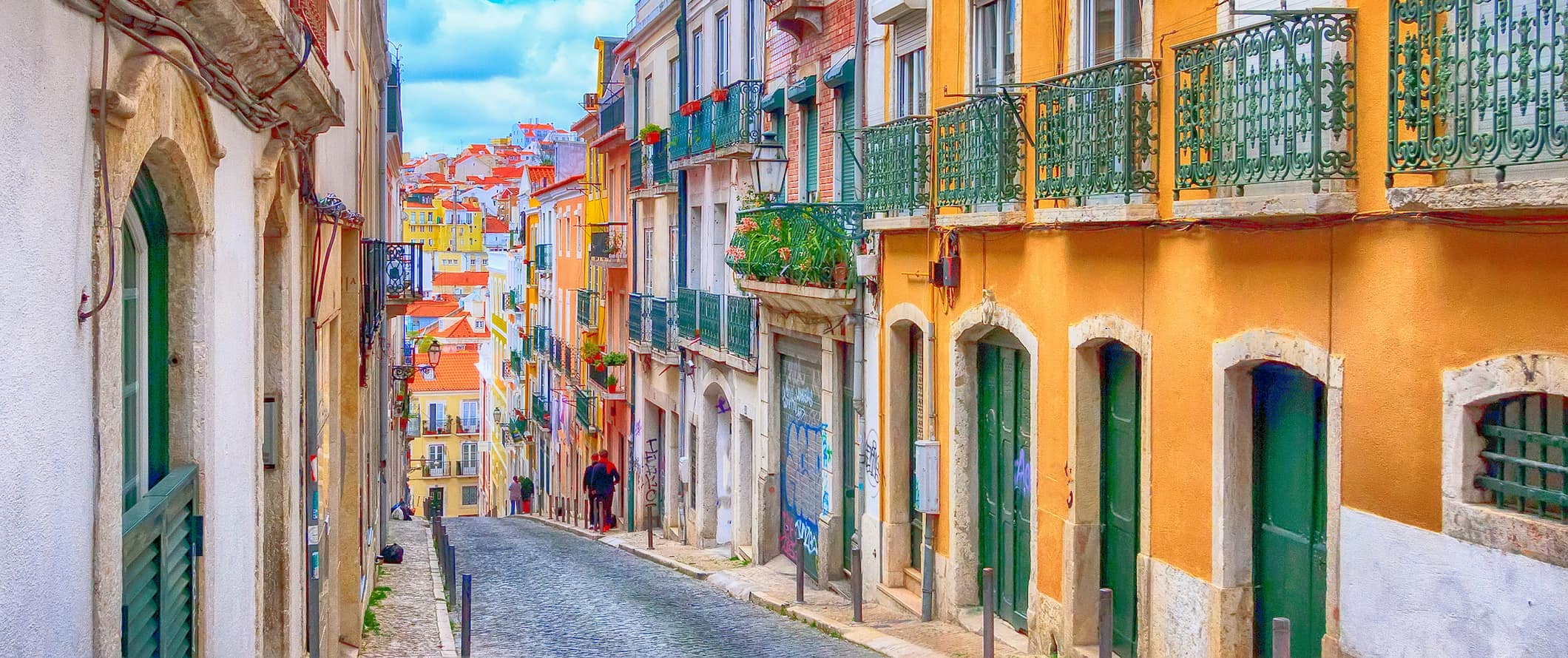
For those traveling with a tent, camping is available outside of the city. A basic plot for one person without electricity starts at 12 EUR in the off-season and 20 EUR in the summer.
Budget hotel prices – Two-star budget hotels start around 65-85 EUR per night. Expect basic amenities like free Wi-Fi, TV, and coffee/tea makers.
Airbnb is also available around Lisbon, with prices for an entire apartment starting at 70 EUR per night (but averaging more than double that). Private rooms start around 30 EUR but average closer to 70 EUR.
Food – Fish and seafood form the backbone of Portuguese cuisine (Portugal eats the most seafood per capita in Europe). Cod, sardinhas assadas (grilled sardines), sea bass, and shellfish are some of the most common staples. Other popular dishes include cozido à portuguesa (boiled stew), peixinhos da horta (breaded and fried vegetables), and cured ham. Be sure to also try the prego (beef sandwich) or the bifana (pork sandwich). You can find them at local cafes for just 5 EUR.
If you want a traditional meal with drinks at a casual restaurant, you’re looking at spending around 20-25 EUR (prices are higher in the touristy downtown area). Outside downtown, there are many local places where you can find meals for around 10-15 EUR.
A basic fast-food meal (think McDonald’s) costs around 7 EUR while a large pizza starts around 12 EUR. Chinese food costs 10-15 EUR for a main dish.
Beer is around 3 EUR while a latte/cappuccino costs around 2 EUR. Bottled water is less than 1 EUR.
For a week’s worth of groceries, expect to pay 35-45 EUR. That includes basic staples like pasta, vegetables, fruit, bread, cheese, and some meat or fish.
Backpacking Lisbon Suggested Budgets
On a backpacker budget, you can visit Lisbon for around 50 EUR per day. On this budget, you’ll be staying in a hostel dorm room, cooking all of your meals, limiting your drinking, using public transportation to get around, and sticking to free activities like free walking tours, enjoying the beaches, and exploring the Old Town. If you plan on drinking, add 5-15 EUR per day to your budget.
On a mid-range budget of 130 EUR per day, you can stay in a private Airbnb or private hostel room, eat at cheap local restaurants and cook some meals, use public transportation and take the occasional taxi, visit paid attractions like the botanic gardens and Belem Tower, and enjoy some drinks at the bar.
On a “luxury” budget of 240 EUR or more a day, you can stay in a hotel, eat out for every meal, drink what you want, rent a car to explore the region, and visit as many museums and attractions as you’d like. This is just the ground floor for luxury though — you can easily spend more if you really want to splash out!
You can use the chart below to get an idea of how much you need to budget daily. Keep in mind these are daily averages – some days you spend more, some days you spend less (you might spend less every day). We just want to give you a general idea of how to make your budget. Prices are in EUR.
Lisbon Travel Guide: Money-Saving Tips
Lisbon is the most expensive city in the country — but it’s still quite affordable compared to other European capitals. It’s hard to spend a ton here unless you are splashing out. If you find cheap accommodation, cook most of your meals, and stick to mostly free activities, you’re going to be able to keep your budget intact. Here are some quick tips to help you save money in Lisbon:
- Pick up a Lisbon Card – If you’re planning to visit lots of attractions, get the Lisbon Card. It offers free or discounted entry to several attractions as well as unlimited public transportation. Prices start at 21 EUR for a 24-hour card and there is also a 48-hour card for 35 EUR and a 72-hour card for 44 EUR.
- Get a bus pass – If you don’t get the Lisbon Card but still plan on using a lot of public transportation, buy a day pass. They are just 6.45 EUR and will save you a lot of money if you’re using public transportation often.
- Take a free walking tour – If you want to understand more about the history, architecture, and culture of Lisbon then take a free walking tour. They usually last a couple of hours and are a great introduction to the city. Just be sure to tip your tour guide at the end!
- Stay with a local – Couchsurfing is the best way to save on accommodation in Lisbon. By staying with a local you’ll not only save money but you’ll get to spend time with someone who can show you the city’s hidden gems and teach you more about the culture and history of Lisbon. Just be sure to send your requests early in the summer!
- Skip the taxis – Taxis are expensive, often adding fees for luggage and airport pickups. Simply use the metro or bus to get where you need to. You’ll save a ton.
- Say “no” to bread – When eating out, you’ll often be offered bread and olives. They will be brought to your table before your meal. These aren’t free, so politely decline the offer if you’re not interested in paying for them.
- Use BlaBlaCar – BlaBlaCar is a ridesharing app you can use to travel in between cities. It’s faster than the bus and usually just as cheap. You’ll have to find a ride, which can sometimes be hit or miss, but the profiles are verified and reviewed so it’s quite safe. Plus, it’s a great way to connect with other locals/travelers.
- Visit the Berardo Collection Museum on Saturdays – Tourists can get a glimpse of Portuguese businessman Jose Berardo’s personal collection of contemporary art, which makes up the permanent exhibits at the museum. Even if you aren’t a fan of contemporary art, the building itself is great to walk through. The museum is free on Saturdays.
- Bring a water bottle – The tap water here is safe to drink so bring a reusable water bottle to save money and reduce your plastic use. LifeStraw is my go-to brand as their bottles have built-in filters to ensure your water is always clean and safe.
Where to Stay in Lisbon
Lisbon has lots of hostels. In fact, it’s one of the best cities in the world for hostels. Here are my suggested places to stay in Lisbon:
- Lookout! Lisbon Hostel
- Lisboa Central Hostel
- Yes! Lisbon Hostel
- Home Lisbon Hostel
How to Get Around Lisbon
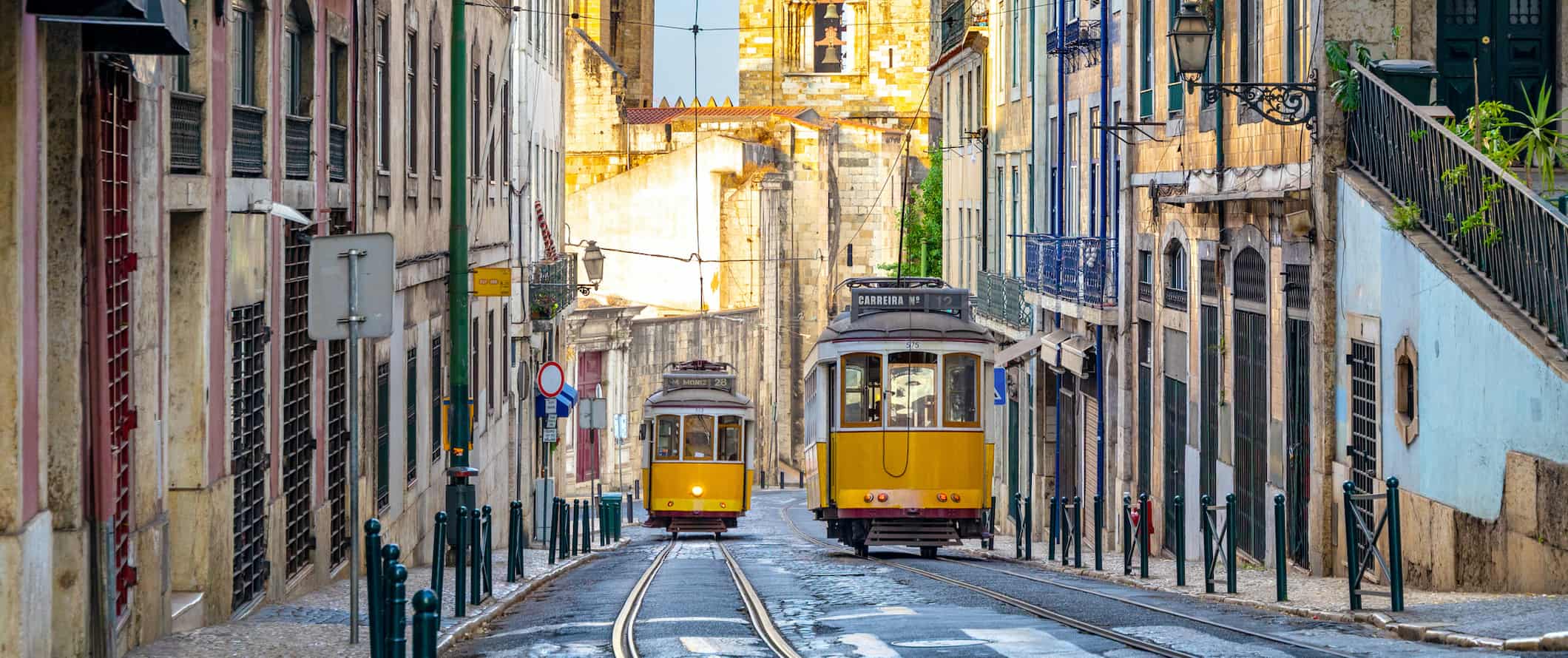
There are two tram lines in the city: the modern Siemens “Articulado” trams and the historic “Remodelado” trams. Trams cost 1.50 EUR.
The metro offers a fast way to get from one corner of the city to another. There are four lines and 56 stations. They are very accessible and the information and maps are provided in English so it’s easy to navigate. Prices are the same as the tram and bus.
Taxi – Taxis in Lisbon start at 3.50 EUR and increase 0.50 EUR for every kilometer traveled. Most drivers speak English but showing them the address on your smartphone will help. If you’re on a budget, skip the taxis. They get expensive fast!
Ridesharing – Uber is available in Lisbon but it’s not much cheaper than the taxis. Bolt and FreeNow are two other ridesharing apps that are usually cheaper than Uber, but I’d still skip ridesharing altogether if you’re on a budget.
Bike rental – If you’re an avid cyclist who likes a challenge, then biking in Lisbon can be fun. For the non-cyclist, it will likely be unpleasant. The city is filled with steep hills and cobblestone streets — hardly ideal for a leisurely ride. Bike rentals start at 10 EUR for a half-day and go up to 25 EUR for a full day. You can also try Gira, the city’s bike-sharing system (you can buy a 24-hour pass for just 2 EUR).
Car rental – You won’t need to rent a car to get around the city as public transportation is reliable and efficient. If you plan to go on a day trip, you can rent a car to have more flexibility. It will be more expensive than taking the bus or train but will give you more freedom. Expect to pay 30-40 EUR per day for a small rental car. Drivers need to be at least 21 years old.
When to Go to Lisbon
Peak season in Lisbon is during the summer months of June-August. Temperatures during that time soar to 25-30°C (77-86°F). This is also the busiest time to visit the city so expect crowds and slightly higher prices. The overall atmosphere during this time is lively and there are lots of places to swim or relax on the beach so it’s still worth visiting during peak season.
If you’re on a budget, the best time to visit Lisbon is during the shoulder season. April-May and September-October are still warm so you can enjoy the outdoors without as many crowds. Temperatures hover between 12-25°C (53-77°F) during these months. It may be a bit rainy, but you can still enjoy the city without much inconvenience.
Winter is from November to February. It gets cold, and tourist crowds thin out considerably. Temperatures vary but hover around 10°C (50°F). It’s still warmer than much of Europe, so if you’re on the continent and are looking to avoid the worst of the weather, head to Lisbon (or even further south to Faro).
How to Stay Safe in Lisbon
Lisbon is very safe for travelers — including solo female travelers. Violent attacks here are uncommon and petty crime is rare. Pickpocketing is the most common crime so just be aware of your surroundings when you’re in busy markets or when using public transportation and always keep your valuables secure and out of reach.
Young backpackers may be approached and offered drugs as Portugal has decriminalized drug use. However, selling drugs is not legal and there are still consequences so simply decline the offer politely but firmly and continue on.
You won’t find a lot of travel scams in the city but read this article on common travel scams to avoid if you’re worried about getting ripped off.
Solo female travelers should generally feel safe here, however, the standard precautions apply (always keep an eye on your drink when at the bar, never walk home alone intoxicated, etc.).
The emergency number in Lisbon is 112.
The most important piece of advice I can offer is to purchase good travel insurance. Travel insurance will protect you against illness, injury, theft, and cancellations. It’s comprehensive protection in case anything goes wrong. I never go on a trip without it as I’ve had to use it many times in the past. You can use the widget below to find the policy right for you:
Lisbon Travel Guide: The Best Booking Resources
These are my favorite companies to use when I travel. They consistently have the best deals, offer world-class customer service and great value, and overall, are better than their competitors. They are the companies I use the most and are always the starting point in my search for travel deals.
- Skyscanner – Skyscanner is my favorite flight search engine. They search small websites and budget airlines that larger search sites tend to miss. They are hands down the number one place to start.
- Hostelworld – This is the best hostel accommodation site out there with the largest inventory, best search interface, and widest availability.
- Booking.com – The best all around booking site that constantly provides the cheapest and lowest rates. They have the widest selection of budget accommodation. In all my tests, they’ve always had the cheapest rates out of all the booking websites.
- HostelPass – This new card gives you up to 20% off hostels throughout Europe. It’s a great way to save money. They’re constantly adding new hostels too. I’ve always wanted something like this and glad it finallt exists.
- Get Your Guide – Get Your Guide is a huge online marketplace for tours and excursions. They have tons of tour options available in cities all around the world, including everything from cooking classes, walking tours, street art lessons, and more!
- The Man in Seat 61 – This website is the ultimate guide to train travel anywhere in the world. They have the most comprehensive information on routes, times, prices, and train conditions. If you are planning a long train journey or some epic train trip, consult this site.
- Rome2Rio – This website allows you to see how to get from point A to point B the best and cheapest way possible. It will give you all the bus, train, plane, or boat routes that can get you there as well as how much they cost.
- FlixBus – Flixbus has routes between 20 European countries with prices starting as low 5 EUR! Their buses include WiFi, electrical outlets, a free checked bag.
- SafetyWing – Safety Wing offers convenient and affordable plans tailored to digital nomads and long-term travelers. They have cheap monthly plans, great customer service, and an easy-to-use claims process that makes it perfect for those on the road.
- LifeStraw – My go-to company for reusable water bottles with built-in filters so you can ensure your drinking water is always clean and safe.
- Unbound Merino – They make lightweight, durable, easy-to-clean travel clothing.
- Top Travel Credit Cards – Points are the best way to cut down travel expenses. Here’s my favorite point earning credit cards so you can get free travel!
- BlaBlaCar – BlaBlaCar is a ridesharing website that lets you share rides with vetted local drivers by pitching in for gas. You simply request a seat, they approve, and off you go! It’s a cheaper and more interesting way to travel than by bus or train!
Lisbon Travel Guide: Related Articles
Want more info? Check out all the articles I’ve written on backpacking/traveling Portugal and continue planning your trip:
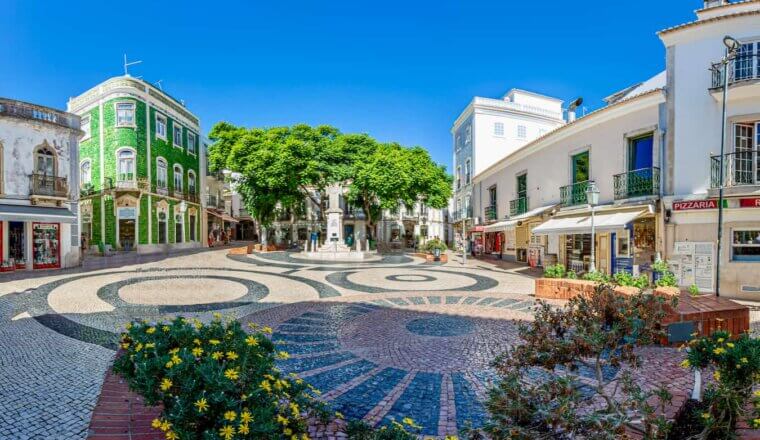
The 4 Best Hostels in Lagos, Portugal
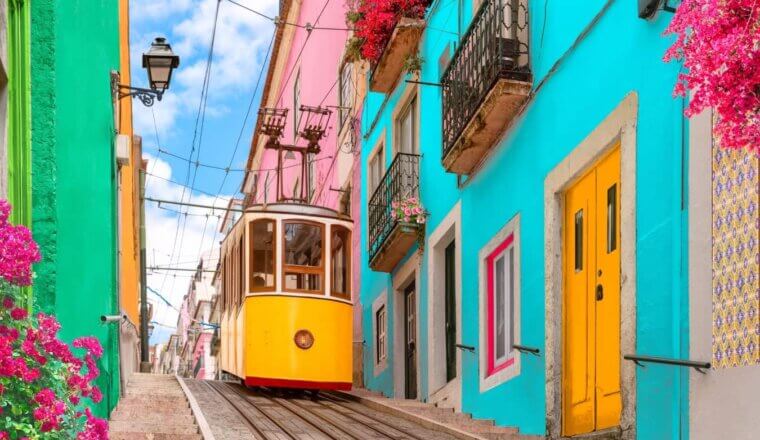
The Best Walking Tours in Lisbon
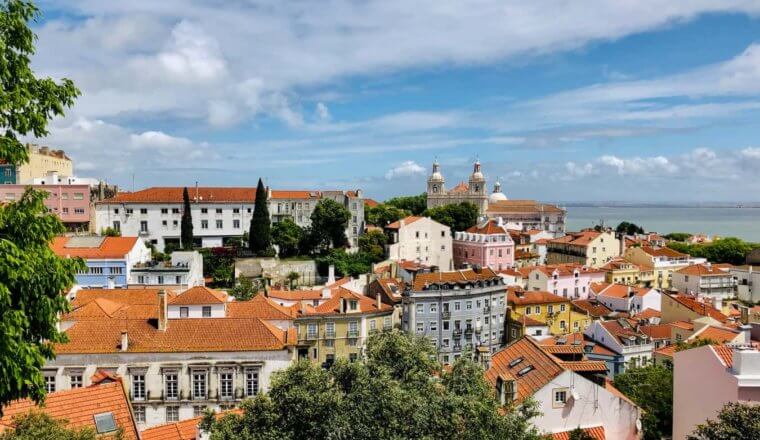
Where to Stay in Lisbon: The Best Neighborhoods for Your Visit
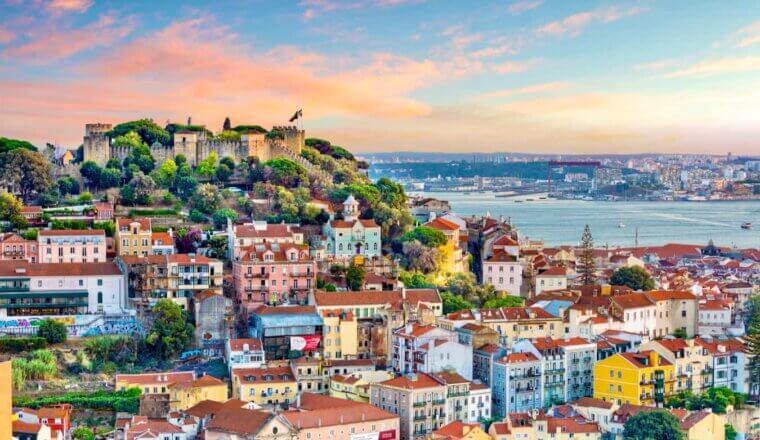
The 9 Best Hostels in Lisbon
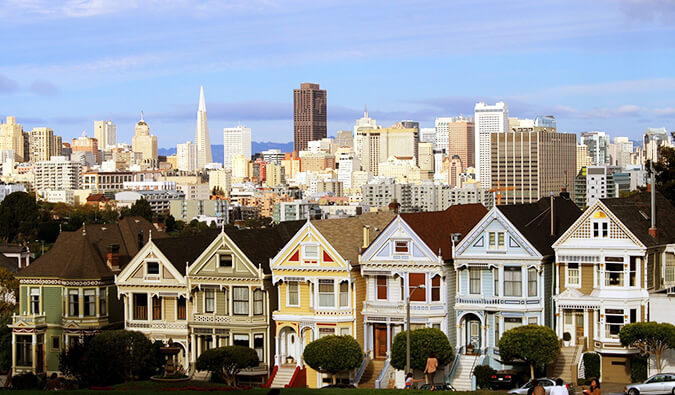
When Three Days Is Not Enough Time
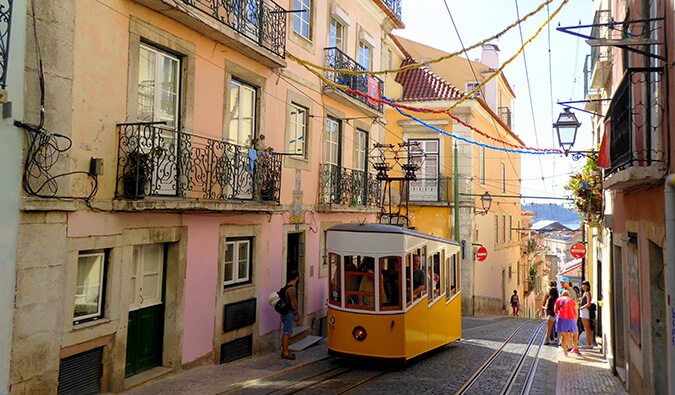
Lisbon: Even Better the Second Time
Get my best stuff sent straight to you, pin it on pinterest.
- Where To Stay
- Transportation
- Booking Resources
- Related Blogs
- Search Please fill out this field.
- Manage Your Subscription
- Give a Gift Subscription
- Newsletters
- Sweepstakes
- Travel Destinations A-Z
Lisbon Travel Guide
Lisbon is arguably Western Europe's most underrated capital city. It's also one of the continent's oldest. First founded as a trading port city in 1200 B.C., Lisbon pre-dates Rome. Most of the old city was destroyed in an earthquake in 1755. But today, the "City of Light" is thriving. In the last 50 years its population and annual visitors have more than doubled as the rest of the world discovers what this second city on seven hills has to offer.Indeed, Lisbon checks all the boxes. It's home to colonial architecture, destination museums, and even its own genre of music. Hop on an iconic yellow tram and explore a fortified castle, a bustling waterfront, or a colorful maze of cobblestone streets. There's fun food – think themed trucks and even cereal bars – and fine food – five Michelin-star restaurants. At night, retire to a funky hostel, beautiful boutique property, or a 16th Century five-star hotel.
GMT during the winter (last Sunday in October – last Sunday in March)
GMT+1 during the summer (last Sunday in March – last Sunday in October)
Best Time to Go
Lisbon is a shoulder season destination. The best time to visit is in the spring, March to May, or fall, September to November, when the weather is pleasant. During the winter months, it's often cloudy or raining, and the city can feel like a ghost town. During the summer, peak tourist season, temperatures can be uncomfortably hot, crowds are common, and it can be hard to find accommodations (plus rates are higher).
However, you'll definitely want to visit mid-June if festivals are your thing. Sunday, June 13 is St. Anthony's Day – Lisbon's most beloved holiday and an entire night filled with parades, dancing, and plenty of grilled sardines.
Things to Know
Currency: Euro
($1 USD = .83 EUR; Check the current exchange rate )
Language: Portuguese
I don't speak Portuguese: Nao falo portugues
Where is the…: Onde está
Thank you: Obrigada
Learn more Portuguese phrases
Calling Code: +351 21
Outlets: Portugal uses type F and type C plugs. The U.S. uses type A and B. So, pack an adapter or be prepared to buy one at the airport. Since the voltage in Portugal is 230V you may also need to bring a converter if you're using an appliance that isn't compatible with 230V.
How to Get Around
Trains: Lisbon's trains (CP) which connect to major cities and surrounding towns, are frequent, reliable, and affordable. Tickets can be purchased at stations, online, or on the Comboios de Portugal app. The metro (Metro Lisboa) is just as user-friendly. There are four colored lines. The red line goes all the way to the airport, and single rides cost less than €2. Don't forget to validate your tickets before boarding and hold on to them until your ride is over.
Buses: Lisbon's bus system (Carris) runs 24/7 and includes two electric trams (including the historic yellow trolleys) and a funicular. Single rides are €2.
Taxis: Lisbon's taxis are abundant and certainly affordable, unless you use them during rush hour. Fares depend on where you're going, what time of day you're going, and how much luggage you have with you. Coop Taxis tend to be the most trusted. Always have cash available as credit cards aren't always accepted. Rideshare: Uber and Cabify, a Spanish rideshare company often cheaper than Uber, are both available here. Upon arriving at the airport, follow signs for the Uber pickup location.
Best Hotels
The one palácio da anunciada.
Address: Rua das Portas de Santo Antão, 112-134, 1150-268 Av. Liberdade / Restauradores Lisbon, Portugal Phone: (351) 21-041-2300 Book Now
Lisbon's newest five-star property, The One Palácio da Anunciada, is housed in a 16th-century palace located in Lisbon's most exclusive neighborhood. After a soft opening in 2019, it's now up and running with 83 well-appointed rooms surrounded by manicured French gardens housing a spa, an outdoor pool, and even a solarium.
Tivoli Avenida Liberdade Lisboa
Address: Av. da Liberdade, 185, 1269-050, Lisbon, Portugal Phone: (351) 21-319-8950 Book Now
Highlights at this five-star hotel located on one of the most expensive avenues in the world include an outdoor pool surrounded by a tropical garden and a chic rooftop bar with city views. The property also has an award-winning seafood restaurant and a luxury spa complete with 24-hour fitness center. Deluxe rooms start at $280/night while the Diplomatic Suite, decorated with pieces that once belonged to the late Portuguese actress Beatriz Costa, starts at $1200/night.
Hotel Britania
Address: Rua Rodrigues Sampaio, 17, 1150-278, Lisbon, Portugal Phone: (351) 21-315-5016 Book Now
Billing itself as the only surviving original Art Deco hotel in Lisbon, Hotel Britania is a design-forward boutique property straight out of the 1940s. It's located just off of Avenida Liberdade on a quiet street. There are only 33 rooms but all have private marble bathrooms and powerful AC (a real luxury in Lisbon). Rates start around $100/night.
Tesouro da Baixa by Shiadu
Address: R. Dom Duarte 3, 1100-240, Lisbon, Portugal Phone: (351) 91-417-6969 Book Now
An ideal home base for exploring Barrio Alto and Chiado, the tried-and-true Tesouro da Baixa by Shiadu is just a five-minute walk from the main train station, Rossio. Like every Shiadu property in Lisbon (and there are six) accommodations are modern, yet classic, and minimalistic, yet comfortable. Guest reviews are always stellar, if not perfect, and rates start at just $80/night, including breakfast.
Dare Lisbon
Address: R. dos Sapateiros 135, 1100-422, Lisbon, Portugal Phone: (351) 21-346-1407 Book Now
Dare Lisbon specializes in rooms that feel like home, not hotels. This hospitality company prides itself on its 23 mini apartments each outfitted with a well-equipped kitchenette. Think coffee maker, fridge, microwave, electric cooktop, stick blender, and even a dishwasher. Rooms also include AC; rates start at $120/night (long term rates are available).
The Lumiares Hotel & Spa
Address: 142 Rua do Diário de Notícias 1200-146, Lisbon, Portugal Phone: (351) 21-116-0200 Book Now
This high-end hotel and spa with luxury apartment vibes is perched on a hill in Barrio Alto. The rooftop restaurant and bar have sweeping views of the city's skyline and serve seasonal, locally-sourced fare. Rooms have high ceilings and are spacious, by European standards. They include kitchenettes or full kitchens and living areas. Rates start at $195/night.
My Story Hotels
Address: Rua dos Condes de Monsanto, 2, 1100-159, Lisbon, Portugal Phone: (351) 21-886-6182 Book Now
All four My Story Hotels in Lisbon are contemporary, budget-friendly properties housed in recently renovated historic buildings. They're popular with younger crowds who want to be within walking distance of nightlife but not on top of it. Rates start at $80/night, and rooms are mostly singles and doubles.
Best Restaurants
Time out market (upscale food court).
Address: Av. 24 de Julho 49, 1200-479 Lisboa, Portugal Phone: (351) 21-395-1274 Website
Time Out Market is Lisbon's answer to New York City's Eataly. Located in a historic market hall just a stone's throw from the waterfront, it features more than two dozen popup versions of the city's best restaurants and bars. It also hosts special events including cooking classes and is home to an exciting fish, meat, and produce market featuring the freshest ingredients around.
Pasteis de Belem (Portuguese)
Address: R. de Belém 84 92, 1300-085 Lisbon, Portugal Phone: (351) 21-363-7423 Website
Since 1837 people have been lining up at this beloved Lisbon institution selling baked goods faster than they can bake them. Legend has it the secret recipe for Pasteis de Belem's best-selling sweet custard tarts came from within the Jerónimos Monastery. There's usually a massive line, and sometimes it can take a while to get a table inside. But it's always worth the wait.
Tapa Bucho (Portuguese)
Address: Rua Diário de Noticias n 122 1200-281 Lisbon, Portugal Phone: (351) 91-456-6392 Website
It's hard not to go to town at this tapas bar where there are at least four kinds of croquettes centered around proteins like oxtail and alheira (all served with amazing aolis) and pisco sours so good they deserve a cult following. Reservations are highly recommended because the terrace is small and tables go fast. Portions are quite generous, for the low prices, so keep that in mind as you order.
Barrio Do Avillez (Portuguese, Pizza)
Address: R. Nova da Trindade 18, 1200-303 Lisbon, Portugal Phone: (351) 21-583-0290 Website
The brainchild of Chef José Avillez, Barrio Do Avillez is a great way to experience food created by the first chef to bring two Michelin stars to a restaurant in Portugal. This culinary complex includes: Taberna, which serves elevated traditional Portuguese fare and the perfect lunch spot; Páteo which specializes in specialty fish and seafood; and Mini Bar, a gourmet gastro bar with bold flavors in small bites. Finally, there's Pizzaria Lisboa, which offers a family-friendly atmosphere and pizzas prepared with 00 flour, San Marzano tomatoes, and mozzarella Fior di Latte.
Augusto Lisboa (Breakfast and Brunch)
Address: Rua Santa Marinha, 26 1100491 Lisbon, Portugal Phone: (351) 21-887-2746 Website
With its bubblegum pink façade and the line out the door on the weekends, it's hard to miss Augusto Lisboa. This dreamy, details-forward restaurant may only serve breakfast and brunch but it's ranked #2 out of more than 5,000 Lisbon restaurants on TripAdvisor. The complete opposite of a greasy spoon, it serves the freshest ingredients and specializes in an avocado toast you've probably already drooled over on Instagram.
Restaurante Feitoria (International)
Address: Doca do Bom Sucesso 1400-038 Lisbon, Portugal Phone: (351) 21-040-0208 Website
Restaurante Feitoria, Chef João Rodrigues's ode to Portugal, is located in the Altis Belem Hotel & Spa. Just one look at its inventive "material-themed" menu and it's easy to see why this Michelin-star restaurant is so renowned in the industry. Courses are small (but there are at least eight), and don't expect to walk out without spending at least $150 per person, especially if you partake in the extensive wine list. Reservations are required.
Things to Do
Address: R. do Diário de Notícias 39, 1200-141 Lisbon, Portugal Phone: (351) 96-133-9696 Website
Portugal's signature style of music, fado, is where country meets the blues before colliding with opera. Songs are tragic and haunting, but they're not just played, they're performed. Since its birth in the 1830s, watching fado – which takes place in traditional bars and restaurants like Tasca Do Chico – has become the quintessential Portuguese pastime.
Try ginjinha
Address: Largo de Sao Domingos 8 Rossio, Lisbon 1150-320 Portugal Phone: (351) 21-814-5374 Website
Ginjinha is a sweet cherry liquor invented in Lisbon where today it's practically a staple, like sardines. The most popular place to get a shot is A Ginjinha bar , a walk-up hole-in-the-wall bar next to the bustling Rossio train station. There are no seats, just a small crowd of locals getting their daily dose mingling with curious tourists ready for their first taste.
Mosteiro dos Jeronimos
Gautier Houba/Travel + Leisure
Address: Praça do Império 1400-206 Lisbon, Portugal Phone: (351) 21-362-0034 Website
Recognized by UNESCO, this World Heritage site is as magnificent as monasteries come. It's hard to picture monks taking a vow of poverty in this palatial complex dating back to the 16th century. With its delicate ornate stonework, it's even harder to imagine it surviving the 1755 earthquake, but it did. Several tombs of Portugal's historical elite – from poets to explorers – are found here.
Oceanário de Lisboa
Address: Esplanada Dom Carlos I s/nº, 1990-005 Lisbna, Portugal Phone: (351) 21-891-7000 Website
Although it's not within walking distance of downtown, Lisbon's award-winning aquarium is a must for families and anyone with a remote interest in marine biology. More than 8,000 animals live in its 7 million-liter saltwater tank. Temporary exhibits, including submerged forests by Takashi Amano (the foremost "aquascaper" in the world) are just as memorable.
Best Shopping
Address: Praça do Príncipe Real, 26, 1250-184 Lisbon, Portugal Phone: (351) 96-530-9154 Website
A former 19th-century Arabian palace, EmbaiXada (meaning embassy in Portuguese) is now an elegant mall of sorts committed to selling goods designed by Portuguese artists and artisans. From children's clothing to gourmet gin and organic cosmetics, if it's quality and made with love in Portugal, it can probably be found here.
A Vida Portuguesa
Address: Rua Anchieta 11, 1200-023 Chiado, Lisbon, Portugal Phone: 351-21-346-5073 Website
Specializing in products that have "crossed generations and touched hearts" A Vida Portuguesa is where to go for timeless gifts and souvenirs. Shop for stationary, linens, perfumes, and well-curated kits all sourced in Portugal and sold in packaging so pretty it's a shame to toss it.
Livraria Bertrand
Address: R. Garrett 73 75, 1200-203 Lisbon, Portugal Phone: (351) 21-347-6122 Website
When it opened in 1732, Libraria Bertrand was just another bookstore. Today, it's the world's oldest operating bookstore according to the Guinness World Records. While there are several Bertrand branches in Lisbon, the original is open seven days a week. It's the perfect place to seek refuge from a rainstorm or to find a large selection of books in English.
Address: Rua Rodrigues Faria, 103, 1300 – 501, Lisbon, Portugal Phone: (351) 21-314-3399 Website
LX Factory is Lisbon's answer to DUMBO. Once an industrial site in the shadow of Lisbon's iconic suspension bridge, it's now a hip district home to eclectic stores, galleries, and restaurants. Think food trucks, street art, and cool concept shops selling everything from chocolate salami to funky reversible lamp shades.

Neighborhoods to Know
Alfama : Boasting some of the best views of the Tagus River, this medieval village (it survived the 1755 earthquake) is perched on Lisbon's highest hill. It's home to Saint George's castle, and is arguably one of the city's most photogenic neighborhoods. Streets are narrow, but not too narrow for the historic 28 Tram which ferries tourists who don't want to deal with cobblestones or stairs.
Bairro Alto : Dating back to the 15th century when artists and authors flocked here in high numbers, this bohemian borough is now a happening scene. But for the most part, the magic only takes place at night. Come during the day to see the Insta-worthy street art. Return after dark for the city's best nightlife, bar-hopping, and dancing.
Chiado : It's hard not to compare this sophisticated neighborhood in the center of Lisbon with one you'd find in Paris or on the Upper East Side. It's far more contemporary than its surrounding districts and home to luxury retailers, elegant theaters, and the city's finest reservation-only restaurants. It also boasts Livraria Bertrand, founded in 1732 and thought to be the oldest operating bookstore in the world.
Belem : Lisbon's most impressive buildings and stateliest parks aren't downtown; they're in Belem. This historic waterfront with an extensive riverside trail was where 15th-century explorers, including Ferdinand Magellan, departed Lisbon to discover the world. The city's most photographed structure, the Tower of Belem, rises out of the river and is only accessible by pedestrian bridge. The neighborhood is also home to beautifully landscaped green spaces, the ornate Jerónimos Monastery and several museums.
Lisbon has four seasons and with the exception of summer, a pretty mild climate. It can be compared to central California's. Temperatures rarely dip below 45°F and typically only climb up to the mid-90s°F in July or August. These months are also the driest. With an average of 13 days of precipitation, November is usually the wettest month. And don't count on seeing snow. It's not uncommon for Lisbon to go half a century or longer without receiving any.
Apps to Download
Lisboa Cool : City guides, maps, planning, scheduling tours iOs | Android
Uber : Ridesharing, food delivery iOs | Android
Google Translate : Translation, phrasebook, transcription iOs | Android
Related Articles

- September 25, 2018
The Best Travel Guides to Lisbon
The atlas team.
There are many travel guides for Lisbon, and each tends to suit a certain traveler. It’s unlikely that you’ll pick up a foodie guide to fish if you hate seafood, and equally, you won’t want an insider’s guide to architecture if buildings bore you. Luckily, there’s something for everyone, and we’ve had a look through some of the best to save you the legwork.

Previously described as a “travel-culture” magazine, and with stores sporting one-of-a-kind travel items, it is no surprise that Monocle’s guide to Lisbon is sleek, minimalist, and well designed.
The guide is based around a system of symbols to guide you through the sectors (H for Hotels, R for retail, etc.,) which are more reminiscent of New York’s subway than a city handbook. Unfortunately, the map has lost a lot of its usability in its pursuit of aesthetics, leaving a well designed double-page spread that doesn’t reveal much. Nonetheless, the book is peppered with unique photographs letting any design-minded traveler know what to expect when visiting the city of seven hills, all of which are presented beautifully.
As you flick through the expected Food & Drink, Culture, and Retail sections, the book is punctuated by a section entitled Essays. The chapter consists of 12 “Letters from Lisbon” that discuss everything from history, to kiosk culture, to the “arrow-tailed symbol of optimism” that adorns so much of the Portuguese capital. It is far from coincidence that this rather unique addition to the travel guide resides in the very center of the book. For what is at the center of travel if not the stories of the people who experience it?
A travel guide can never capture everything a city has to offer (that’s what we’re here for), but Monocle has managed to present the must-visit places in a beautiful and engaging way, along with an unexpected look at the personal stories and issues of the city.
This is a travel guide for the designers, the aesthetes, and of course anyone who reads Monocle.

A rarity for travel guides, this one is actually written by a local — an authentic Lisboeta. It is broken down into 100 different “5 Best…” sections, covering things like the 5 Best Ice Cream Shops to 5 Modern Buildings.
The title is… somewhat deceptive. Many of the places named are indeed very good, and any first-time tourist in Lisbon (who this book is aimed at) would probably do well to visit them. However, they are hardly what you would call “hidden.” In the section on pastéis de natas , the number-one spot goes to Pastéis de Belém . In the Coolest Bars section, the number-one spot goes to Pensão Amor . Neither of which are exactly “hidden.”
Additionally, some of the advice seems… optimistic, let’s say. In the 5 Small Squares section, Largo de São Paulo is described thusly: “for many decades a shabby area where you really wouldn’t feel comfortable at night, given the many illegal activities that went on there. Now, all that has changed.” Well, the square isn’t necessarily dangerous, but if you go there at night and don’t see illegal activity, we would be very surprised.
This travel guide does offer 10 minimal-yet-clear maps at the start that show the locations of every place mentioned. Additionally, the layout is one of the simplest around, and extremely easy to follow.
All said, even a longtime resident of Lisbon could find this guide useful when looking for something specific, such as good Goan food, or where to find one of the world’s leading experts in porcelain (seriously, that’s in there). However, if truly hidden spots are what you are after, you may be disappointed.
This is a travel guide for people who want to explore the city through the best of what it has to offer, rather than through the tourist hotspots.

The front page folds out into a photograph of the Lisbon skyline with arrows to some of the most famous landmarks. While not technically useful, this “city at a glance” graphic makes for a nice introduction and gives you the impression of having an overview of the city. The back page, on the other hand, folds out into a useful, detailed map. The best of both worlds.
The book is organized like an old address book (think colored tabs), allowing you to easily find your way to the right section. Moreover, the start has a well-presented guide to some of the key neighborhoods in the city. The city’s neighborhood divisions, which have been recently redrawn, can be very confusing, so a clear guide like this is invaluable.
Being such a small guide, the chapters are minimal, almost to a fault. The “Landmarks” section, for example, contains just four entries, one of which is Torres das Amoreiras. There is no Elevador de Santa Justa, nor even Castelo São Jorge.
Overall, it seems to be a highly edited (perhaps too much) guide, which is weighted more towards the design aspects of a city than the traditional tourist spots. It is certainly looking for the luxury market, but perhaps at the cost of content.
This is a guide for people who want high-end shops, restaurants, and bars as well as an ultra-compact design guide to the city.

For a book of its size, it is extremely comprehensive, with sections on everything from the expected hotels and bars to books, films, and even influencers.
The first chapter is Getting Around, and rightly takes pride of place, giving visitors an overview of the complex Lisbon public transport system. A valuable resource for any traveler in the city of seven hills.
The “What to See Chapter” hits most of the main sites, and does a good job of explaining each of them, opting for a spacious and easy-to-read layout. However, some key information is missing, such as prices. The castle isn’t cheap for a family of five, and admission to Museu Coleção Berardo isn’t free (most of the time).
The other chapters follow in a similar style, giving a clear overview of what the city has to offer. Heavy on images, and light on info, those who don’t mind a little additional research will feel at home with this book.
This is a guide for those who want to see everything the city has to offer, and don’t mind paying for it.

This probably out-of-print book, which we picked up a few years ago for a cool 5€, reads like somebody has taken 20 zines and smooshed them together between an old-timey hardback cover. And we say that not as a bad thing. It also makes sense, since it was edited by Joana Pinto Correia, longtime editor of le cool Lisbon .
It is certainly not the type of guidebook that can be carried in a pocket as you trudge about the city, but rather one to be studied from the confines of your home.
Its opening pages contain the single most comprehensive map of Lisbon neighborhoods we have ever seen. While the pop-art stylings could put some people off, the map is extremely clear, including even the blurred borders that prove so tricky to track. The book is almost worth getting for this alone.
However, the general layout can be extremely confusing and seems to have been designed with love rather than forethought for readers. A forgivable crime, and one that holds as both a positive and negative for us. Also, the guide pitched itselft as alternative, and by all accounts seems to be, but when it recommends a Segway tour one page before the “ sub versive way “, it loses some credibility.
The chapters are vast and sprawling, giving an array of choices for bars, cafes, and restaurants alongside detailed descriptions. The books seem to delve into Lisbon to pull forth many of the city’s best parts and most valuable offerings.
This is a guide for those who prefer theory to practice. The content is good, the concept is good, but the execution makes for a book near-impossible to get through (even for a seasoned zine-reader).

The guide is a stripped-down version of the more comprehensive (and oh-so-famous) Lonely Planet guidebook. It is divided very cleanly into four parts: QuickStart Guide, Explore Lisbon, the Best of Lisbon, and Survival Guide.
The QuickStart Guide breaks down the top sites and key destinations and includes a handy day-by-day planner and key information on things like hotel prices and transport. The Explore Lisbon chapter then breaks down the city by neighborhood, letting you know what to do and where.
The Best of Lisbon section is pretty self-explanatory and contains lists of things such as “Best for Kids,” “Best Churches,” and “Best Shopping.” The final section, Survival Guide, has a basic (yet surprisingly comprehensive) rundown of the basics including weather, places to stay, which plugs to use, and even a little section on language.
Additionally, there is a substantial fold-out map that will help you navigate the city. Just please don’t pull it out in public, nobody wants to look like a tourist.
Overall, this is a clear, concise, and well-designed guidebook. It is image-heavy, and the layout of the text allows you to quickly and easily find the information you need. Considering its small size, it packs a lot in and is a pleasure to use.
This is a guide for people who want clear, bright, easy-to-read information in their pocket. If you travel light, this may well be the guide for you.

Unlike the rest of the guides here, this is a book for the whole country, rather than just the city of Lisbon. This, of course, means that it isn’t as focused on the capital but, that said, the books dedicates 145 pages to Lisbon and Sintra.
This is an extremely comprehensive guide, giving specific details including prices, contact numbers, and addresses for nearly everything it recommends. However, comprehensive can mean dense, and this is a hard book to use. With little in the way of contents, it can be difficult to know where to look in the book for the information you need. Excluding the introduction, the entire book is printed in black and white, which adds to the difficulty of skimming for information.
Additionally, at over 460 pages, it isn’t exactly pocket-friendly. It may be better to read the entire section you’re interested in before you ever leave home, and then noting and marking the bits you need.
Also, somewhat surprisingly for a $20 book, there are several pages of advertisements for other Rick Steves products.
In its favor, it does do an excellent job of explaining things that may otherwise go over your head. It doesn’t simply recommend visiting the National Azulejo Museum but explains the history and importance of azulejos in Portugal as well.
This is a guide for those who want to sit in an armchair before they even book their plane to Portugal and really get to grips with the country. If you aren’t planning on carrying your own bag, go ahead and pack it, otherwise, it is more of a research tool.

This is another guide that covers the whole of Portugal rather than just Lisbon and starts as it means to go on with a very good overview of the country just inside the cover. A fold-out map color-codes the various regions so as to stop you looking a fool when you don’t know your Alentejo from your Algarve.
As with some of the other guides (I’m looking at you Rick Steves), there are several pages dedicated to online or app-connected content. However, this is free content included with the book and the app actually looks to be of some use, especially when wanting a more in-depth look at niche subjects.
The comprehensive contents page lets you easily navigate the guide and there is a surprisingly detailed look at the history of Portugal, which would give any would-be tourist a nice background for their visit.
There is the key information for must-see spots, broader information on areas of the country and towns, and an array of spectacular images. Additionally, there are more than 20 maps included, all of which can be quickly found via the contents page. We like maps, and this guide does a good job of getting you straight to the information you need.
This is a guide for those who want to see the top spots, but with a little more detail than your average tourist.

The city-specific pocket version of the guide above, this little book packs a helluva wallop.
I’m a sucker for a removable map, and Insight Guides provides one that covers the country, the city of Lisbon, a closer look at the center, and some extra bits to boot. Good work.
The guide itself opens with a visual contents page of the “Top Ten Attraction” and where to find them in the book, before giving you a pre-planned “perfect day” from 9 am to 11:30 pm. My only complaint about this is that it doesn’t set aside a specific amount of time for that on-holiday afternoon nap. Otherwise, it gives quite a nice rundown of a whistle-stop tour of the city.
Again, there is a surprisingly informative section on the history of the city. The book is divided by area, including excursions outside of Lisbon, and then by what to do. This makes for a simple, clear layout that is easy to navigate. While their “To Do” section lacks imagination, it does cover most of the things that your average tourist would be looking for.
Like its big-boy brother, this guide has full-color pictures throughout so you now exactly what you’re looking at and where to take that perfect Insta-snap.
This is a guide for those looking for a no-nonsense trip to the city, hitting all the top spots in a very short time.
[This article contains affiliate links]
You May Also Like

Flea and Artist Markets in Lisbon
Lisbon is home to more and more street markets, and each of them has something worth recommending — see our top picks, updated for 2024.

Lisbon Shop
All things Portuguese with a modern twist, perfect for better-quality souvenir shopping

Buying Local in Lisboa
There’s always a market or two going on in Lisbon throughout the year, but these can be sporadic at best — and sometimes you just want to head to a

Embaixada Shopping
Portuguese design, art and much more

Markets at a Glance
Lisbon is a market town. On the weekends, it’s common to see folding-table vendors popping up in just about every public space to hock their hand-crafted hard and soft goods

Best of Lisboa 2022
The best of the best in Lisbon, and beyond, according to people who know what is the what.

The Thirteen Best Markets In Lisboa
Not all Lisbon markets are created equal, nor are the vendors who comprise them. Here’s where to go if you’re keen for a stroll as you shop or bargaining before you buy.

What Commerce in Lisbon Looks Like Under Lockdown
Updated April 22, 2020 Last month, the Portuguese government announced a 9.2-billion-euro package to provide liquidity for companies and support workers affected by the COVID-19 outbreak. But what does that
Atlas Lisboa likes to support independent local endeavors. If you do too, consider supporting us , for as little as 5€.

Atlas Lisboa Magazine
All Rights Reserved © 2015-2024

Subscribe to the Atlas Lisboa Newsletter
Ultimate Lisbon Travel Guide for 2024

The capital and largest city of Portugal is a beautiful charming city with several characteristic Bairros de Lisboa (neighborhoods) with historical culture and unique architectural landmarks. It’s one of the oldest cities in Western Europe and in the world. Lisbon is situated at the mouth of the Tagus River and is Europe’s only capital city along the Atlantic coast. English is widely spoken so language shouldn’t be an issue if you travel to Lisbon.

This Lisbon travel blog is a complete guide with everything you need to know plus the ultimate 3-day itinerary including free walking routes along the best places to visit and the Lisbon highlights. Find some useful Lisbon travel tips about the public transport, optional things to do in Lisbon, where to eat and the best place to stay for your an incredible trip to Lisbon.
What is the best time to visit Lisbon?

This lovely city has a Mediterranean climate with one of the warmest winters and mildest nighttime temperatures among European cities. That makes Lisbon a perfect destination to visit all year round. The best time to visit Lisbon depends on your needs.
For surfers it’s best to go in wintertime (great waves), budget travelers probably like January and February (cheapest months). Beach lovers and worshipers of sun and warm weather should travel to Lisbon during July to September; these are the hottest months, but because of summer holidays also the most expensive ones.
Overall it’s best to visit Lisbon from March to June or after the summer holidays in September and October. During those months the weather is pleasant (18-25°C), Lisbon hotels are cheaper and there are fewer tourists. I visited Lisbon many times, but this travel guide for Lisbon is based on my trip in April unfortunately we had some rain and it was quiet cold for the time of the year (had to wear my winter jacket).
Stay connected when traveling to Portugal and don't waste money on high roaming charges. Check out my complete guide for the best prepaid tourist sim card for Portugal in 2024 or my list of the best e-sim cards for traveling to Portugal . You can also buy a sim card at Lisbon Airport on arrival.
How many days you need to explore Lisbon?

On a 3-day Lisbon itinerary you’re able to visit all of the main Lisbon tourist attractions and enjoy the beautiful atmosphere of the city! A three days Lisbon trip will also allow you to explore the main historic neighborhoods such as Alfama, Baixa, Rossio, Chiado, Bairro Alto and Belém. If you have some extra days I would suggest to travel to Lisbon for 4 days or 5 days. This gives you the possibility to either enjoy more time in your favorite Lisbon areas or go on a day trip to for example the picturesque Unesco-listed Sintra and the former fishing village Cascais, which is now a famous Portugal tourist destination for its beaches, marina and lively harbor.
If you like to add some relax-time at the beaches along the Atlantic coast you can easily spend a week in and around Lisbon. There is no need to book a day-trip to Sintra or excursions to Cascais or Cristo do Rei since you can easily visit all these Lisbon highlights and things to do in Lisbon by public transport. Another travel tip is to continue your trip from Lisbon to Porto and a road trip to the Algarve .
Where to stay in Lisbon?

There are many great Lisbon hotels and the best place to stay in Lisbon depends on your budget, needs and requirements. Since I prefer smaller centrally located boutique hotels instead of huge hotels away from the heart of Lisbon I chose to stay at the charming 4-star LX Boutique hotel , perfectly located in the heart of ‘historical Lisbon’ Cais do Sodré.

It’s the only hotel in downtown Lisbon that offers views over the Tagus River, Ponte 25 de Abril and Cristo do Rei. It’s also near Pink Street, around the corner of Mercado de Ribeira and only a short walking distance to Bairro Alto, Chiado and Baixa.

To reach other popular attractions, you can easily use the public transport (Lisbon travel tip: buy a Viva Viagem card to pay for your journeys). The metro station (green line) is only a 3-minute walk from the hotel, next to the ferry station to visit Cristo do Rei and the train station to go to Belém. It’s a perfect location to go anywhere in the city.
There are also some of the best Lisbon restaurants in this area and for our Sushi lovers I would like to mention that this hotel has its own trendy sushi restaurant called ‘Confraria LX’.
What is a Viva Viagem card and where can you buy it?

A Viva Viagem card is a great Lisbon travel tip and a fast and easy way to pay for the use of public transport in Lisbon. You can use it to travel on tram, metro, funicular, ferry, bus and the suburban train. For the bus, tram and funicular you can choose to use your Viva Viagem card or to buy a ticket from the driver, but these fares are more expensive. You can buy the card in for example metro and ferry stations at ticket machines or ticket offices and will cost you 0,50 euro. After that you can choose between a single ticket (1,50 euro), a 1-day ticket valid for 24-hours (between 7 and 10 euro depending on the region) or zapping (you can choose your amount). It is the best way to get to all the places to visit in Lisbon.
For my 3-day Lisbon trip I chose the zapping-option and loaded 10 euro to start with (you can easily buy new credit for the same card). You can use the card by swiping it across the card readers to open the gates. I bought mine at the airport because I chose to take the Metro from Lisbon airport to the city center. The red metro line connects the airport to the other three metro lines (yellow, green and blue) and will bring you to Lisbon city center within 30 minutes. Trust me you want to buy this card when you travel to Lisbon.
3-day Lisbon Itinerary + free walking routes
- Day 1: Cais do Sodré – Baixa – Rossio – Chiado – Avenida da Liberdade – Bairro Alto
- Day 2: Almada (Cristo Rei + Ponte 25 de Abril) – Belém – Alcântara – Cais do Sodré
- Day 3: Alfama and tram 28 (possibility to extend with Parque das Nações, Estrela or Príncipe Real)
When I was preparing my 3-day trip to Lisbon, I couldn’t find much useful free walking routes. Probably because it isn’t really necessary, but if you travel to Lisbon for only 3 days and love to have a plan to not miss out on all the things to do and places to see check out the links that will give you access to free walking routes I created for you in Google maps. Im sure it is a great addition to all the Lisbon tips out there already.
Day 1 in Lisbon
Covering: cais do sodré – baixa – rossio – chiado – avenida da liberdade – bairro alto.
On this first day in Lisbon we explored Central Lisbon on foot and walked from our hotel in Cais do Sodré to Baixa, passing through Chiado and Avenida da Liberdade to end in Bairro Alto and back to LX Boutique Hotel in Cais do Sodré.

The centrally located neighborhood Cais do Sodré is a good place to start your first day in Lisbon. We started at Praça Duque De Terceira, a nice square facing the Rio Tagus (Tagus River) and our hotel. This square is also the starting point of Ribeira das Naus, a nicely renovated riverfront promenade (walking area) that connects Cais do Sodré to the nearby Terreiro do Paço in Baixa. Walk along the river, enjoy the musicians, have a drink and admire the views!

The promenade ends at Terreiro do Paço, also known as Praça do Comércio (Commerce Square). It is positioned on the banks of the Tagus River with large yellow symmetrical buildings occupied by the government and a huge open space with a statue of King Dom José I in the center of the square. No wonder it is one of the highlights of Lisbon and one of the most important squares and a popular meeting spot. From this point you can easily walk to Praça Dom Pedro IV (Rossio Square).

Walk through the beautiful Arco da Rua Augusta (triumph arch) to Rua Augusta; a nice pedestrian street that connects these two popular squares. Rua Augusta is the main commercial street in Baixa where you will find several cafés and shops such as H&M, Mango and Zara. In a Lisbon travel guide I found out it’s also a good place to buy some souvenirs and they were right. If you like you can also take a lift to the top of the arch, followed by a staircase to get a panoramic view of Baixa and Terreiro do Paço.

At the end of Rua Augusta, you’ll reach Rossio Square; a lively iconic square with two beautiful baroque fountains in literally the center of Lisbon (Rossio neighborhood) where people sit and relax or enjoy the many cozy outdoor terraces of the restaurants and cafés. This is a Lisbon must see! Right next to this square you will find Praça da Figueira, another nice square that is home to Lisbon’s oldest patisserie (Confeitaria Nacional), hotels and cafés.
For lunch, I recommend Veganapati around the corner of the square; a lovely spot for vegans, but non-vegans will love this healthy and nicely decorated urban lunch-spot too. A great Lisbon restaurant to try out for you. Their cuisine is based on fresh natural food; low in calories with an emphasis on fresh fruits and vegetables, lean protein, low fat non-dairy products and avoidance of added artificial salts, colors and flavors.

After lunch, continue your walk to Elevador de Santa Justa (Santa Justa Lift), also known as Elevador do Carmo. An apprentice of Gustav Eiffel built the 45-meter high lift in 1902 to connect lower Bairro Alto to the upper Largo do Carmo (Carmo Square). This also explains the structure’s similarities to Paris’ Eiffel Tower.

We didn’t take the lift (very crowded and a huge line) but walked through Chiado to the upper Carmo Square instead. In the middle of the shopping-area and cafés of Chiado neighborhood you will find a nice outdoor sculpture of one of Portugal's most famous writers, Escultura de Fernando Pessoa. The statue is located outside 'A Brasileira café’. Lots of tourists take place on the empty chair next to him for a photo together with the writer and pretend listening to one of his famous poems. One of the popular things to do in Lisbon.

Continue your walk to Convento do Carmo (Carmo monastery), which is close to the top of Santa Justa Lift. The monastery is a testimony to the deadliest earthquake in Lisbon's history in 1755. This gothic style church is amazingly picturesque and should not be missed if you are interested in art, history and archaeology. Explore the area around and walk to the Santa Justa Lift to enjoy some nice views of Lisbon with in the back the iconic castle in Alfama.

After visiting the highlights of Chiado follow your way to Praça dos Restauradores, the most northern point of Baixa, to enjoy the square and the surrounding buildings like the Eden Theatre.

This square is dedicated to the restoration of the independence of Portugal from Spain in 1640 and also the beginning of Avenida da Liberdade. It’s the longest street in Lisbon (1,5 km) known as one of the most expensive shopping streets in Europe with various designer shops, expensive restaurants and trendy bars. If you like high-end shopping this is one of the places to visit in Lisbon. Since I don’t have a budget for exclusive shopping I found the walk along Avenida da Liberdade quiet boring.
The street ends at Parque Eduardo VII (Eduardo VII Park), the largest park in central Lisbon with a designed garden and impressive views over Praça Marquês do Pombal, Avenida Liberdade and Tagus River. Walk to the top of the hill, one of the great things to do in Lisbon. It takes some effort, but the view that the park offers on top of the hill definitely makes it worthwhile to go up.

I have two alternative Lisbon travel tips for you if you want to visit Eduardo Park:
1. There are several metro stations close to the park in case you want to skip the long walk along Avenida da Liberdade: Metro station Marquês de Pombal (downhill), Parque (halfway) or São Sebastião (uphill).

2. If you don’t feel like walking but you would like to add Avenida da Liberdade to end in the park, then I highly recommend taking a so-called Shared Electric Scooter. You will find one at every corner and it’s a fun and fast (25km/h) way to explore Lisbon. There are around 8 different e-scooter companies and they all require you to download an app. You pay 1 euro to start and 0,15 euro per minute of use, which is an average of 10 euro per hour.
Option 2 is an amazing thing to do in Lisbon! Pick an electric Scooter from Praça dos Restauradores and follow Avenida da Liberdade until you reach the park. You can even take the scooter to the top of the park. Enjoy the view and ride back to Praça dos Restauradores to have a drink in the Hard Rock Café and take Ascensor da Glória (Glória Funicular) up-hill to Bairro Alto to end the first day of your Lisbon itinerary.

Elevador da Glória is a funicular railway line with iconic yellow trams full of graffiti that connects downtown Baixa with the upper Bairro Alto neighborhood. It’s also possible to walk the steep way up but taking this short tram-ride is a fun experience. Something you can’t miss when you visit Lisbon.

Don’t forget to take a closer look at the beautiful graffiti street-art on your way up. The funicular stops at São Pedro de Alcântara in Bairro Alto.

Bairro Alto district is known for its nightlife and therefore a great place to end your first day exploring Lisbon. Enjoy the sunset at one of the ‘miradouro’, for example the Miradouro de Santa Catarina or visit Jardim São Pedro de Alcântara, a beautiful garden.

Have dinner in one of the high quality Lisbon restaurants in the area and go for a drink in one of the many Bairro Alto bars. Because of the perfect location of our hotel (LX Boutique Hotel) it was an easy walk back (downhill) and if you don’t feel like walking just take a metro or tram.

Day 2 in Lisbon
Covering: almada (cristo rei + ponte 25 de abril) – belém – alcântara – cais do sodré.
On day 2 we decided to have a closer look at the 110-meter high statue of Cristo Rei (Christ Statue), one of Lisbon's most iconic things to do located in the neighborhood of Almada. With his arms outstretched Cristo Rei dominates the skyline of Lisbon and the banks of the Tagus River. The statue is inspired by the famous Christ the Redeemer statue on Corcovado Mountain in Rio de Janeiro.
If you want to avoid crowds it’s best to visit in the morning, but for photos it’s better to visit in the afternoon. I visited in the morning before the crowds and managed to take some nice photos without people and a blue sky.

It’s not necessary to book a Lisbon excursion to Cristo Rei since it’s very easy to go there on your own. First take the Cacilhas ferry from Cais do Sodré (only a 3-minute walk from LX Boutique Hotel). It’s a 10-minute ferry ride to the other side of the river. On arrival to Cacilhas, take bus 101 and get out at the last stop where you will reach the statue in less than 200 meters.
If you don’t have a Viva Viagem card yet you can buy it at the station to pay for your ferry ride. In the bus you either pay with your green Viva Viagem card with zapping credit or ask the driver for a return ticket and pay in cash (more expensive).

It is free to enter the grounds of the Cristo Rei complex and so is the chapel at the entrance. If you want to take the lift to the 80-meter high platform on top of the Christ monument, expect to pay about 8 euros, but you can also enjoy the stunning views of Lisbon, Tagus River and Ponte 25 de Abril without going up.

The view of Ponte 25 de Abril (25 April Bridge) is very impressive. The same architect who drew the Golden Gate Bridge in San Francisco has designed 25 April Bridge, definitely a place to visit in Lisbon. You can see the similarities, but although you would say it’s red, the color is actually ‘International Orange’. It would have been a great thing to do in Lisbon but unfortunately it’s not possible to cross the bridge on foot. You have to go back the same way: bus and ferry.

Back in Cais Do Sodré you continue your Lisbon itinerary by taking the Electric Tram Bus (E15) to Bélem at the tram station right next to the Ferry station. Belém is one of the noble areas of Lisbon. No Lisbon trip is complete without exploring the jewels of Belém, a charming suburb located at the riverside, with many historic monuments and museums.
I recommend riding the tram until the very last stop near Torre de Belém (Belém Tower) and start your Belém sightseeing part from there. Most of the tourists walk the other way around. You can easily spend half a day in Belém it is an amazing thing to do when you visit Lisbon. If you plan to enter most monuments and museums you will probably need more than half a day as there are long queues to visit Jerónimos Monastery and Belém Tower for example.

Belém Tower is a small - UNESCO World Heritage - fort that was constructed to guard Lisbon from seafaring attackers. The tower’s unique design includes a modern and heavily armed bastion, extended over the river. In Lisbon’s Belem district, close to the tower, you can also find a remarkable war memorial known as Monumento aos Combatentes do Ultramar (Monument to the overseas combatants). It’s dedicated to soldiers of the Portuguese army who died during the Overseas War of 1961 to 1974.
The monument consists of three parts: the eternal flame, the V-shaped monument itself and the memorial wall with all the names of the fallen soldiers. The memorial is open all day and there is no entrance fee.

On your way to the monastery I highly recommend visiting the modern Centro Cultural de Belém (Belém Cultural Centre). In this Centre, also referred to as CCB, you can find collections of modern and contemporary art, a number of eateries and small shops. If you want to escape the crowds this Cultural Center is the perfect place for you to have a little rest on one of their beanbags on the grass of the roof terrace or to have lunch, a great Lisbon travel tip believe me!
We ended up in the surprising ‘Este Oeste’ restaurant. They offer a delightful mix of Italian and Japanese cuisine in a beautiful designed area with modern furniture. The staff offered us several free small dishes to taste. All dishes were delicious and I found the mix between Italian and Japanese very surprising. Therefore I recommend Este Oeste as the perfect lunch-spot in Belém. They also have a nice outside terrace overlooking the river. A lovely Lisbon restaurant and a must try on this itinerary.

CCB strongly contrasts with the opposite located UNESCO-listed Mosteiro dos Jerónimos (Jerónimos Monastery), one of the most prominent buildings in Belém and a symbol of Portugal's power and wealth during the Age of Discovery.

Did you know that the original recipe of the famous Portuguese pastries pastel da nata (custard tart) was invented by the monks of the Jerónimos Monastery to sell them at a shop next to a sugar cane factory? The secret recipe is at least 180 years old and known by only a few. Today Pastéis de Belém is widely recognized as the patisserie to sample the authentic custard tart in Lisbon and sells thousands of pastéis de nata every day.
If you have enough time and want to taste the most authentic custard tart, you need to stop at Pastéis de Belém, located only a few meters from the Jerónimos Monastery. A tasty Lisbon travel tip. Because all tourists go there, it’s always very crowded. Since I’m not a fan of huge lines I skipped that part and bought some in a different place and it tasted good as well. You should definitely try these Portuguese pastries on your Lisbon trip.

From the monastery and patisserie you’re able to walk through the beautiful Praça do Império Garden to Padrão dos Descobrimentos (Discoveries Monument); this huge monument was built in 1940 for the Portuguese World Expo and features more than 30 statues of historical figures who played a big role in Portugal’s Age of Discoveries including Henry the Navigator.

It was given permanent status in 1960 to commemorate the death of Prince Henry the Navigator, responsible for turning Portugal into the leading maritime nation in Europe in the fifteenth century. If you like you can use the lift to the top of this monument for a panoramic view across the Tagus River and Belém.

From there I recommend to take an Electric Scooter along the edge of Tagus River to get to the Museum of Art, Architecture and Technology (MAAT). The design of MAAT is great to see and a nice photography spot with views of the bridge and the river. You can easily walk to the rooftop and inside you can enjoy contemporary art exhibitions. MAAT is also a nice spot to watch the sunset when you travel to Lisbon.

After MAAT I would suggest visiting Village Underground and LX Factory. Apparently this place can’t be found in a Lisbon travel guide yet as the majority of the tourists did not yet discover it. There weren’t many people at the time we arrived. You can go there by tram or by foot (a 20-minute walk from MAAT).

Always dreamed of having a drink in a retro double-decker bus beneath the 25 April Bridge? Then definitely include Village Underground to one of your stops. It’s a co-working space and cultural hot spot, built around 14 shipping containers and two buses. The perfect place to visit in Lisbon for digital nomads and travelers. You will be amazed! I really liked the easygoing atmosphere.

LX Factory is another creative co-working hot spot. It’s an old industrial area with vintage stores, cool restaurants and a rooftop bar with amazing views on Tagus River, Cristo Rei and 25 April Bridge. On the rooftop you will find a great statue of a mosaic girl imitating the Christ statue. It’s a great spot for a sundowner and to enjoy the early or late evening.
If you are up for another long walk along Lisbon’s Tagus River, try walking back from LX Factory to Cais do Sodré (40 minutes). Because we were quiet late and it was already dark we took the tram, but it is a lovely thing to in Lisbon as it is a nice walk back along the river.

Cais do Sodré is one of the best places for nightlife and has a lot of good Lisbon restaurants. If you want to go (back) to Bairro Alto, the place where you ended on day 1, you can choose to go with Ascensor da Bica. It’s a funicular railway line that brings you to the top of the hill with beautiful views of the streets of Bairro Alto and the Tagus River. We choose to stay in Cais do Sodré to have dinner.
I have two restaurant recommendations for you in this area: SOI (for the people who love Asian food) and ESPADA (a secret seafood hotspot). Both great Lisbon travel tips for foodies. If you want to be sure of a spot I advise you to book a table ahead. Of course, there is something for everyone at the Time Out Market: a traditional food market and food court with plenty of traditional Portuguese food and more! Worth going when visiting Lisbon.
After dinner you might want to explore the nightlife in for example Pink Street. It’s the coolest barhopping spot near the river (and a former red-light district). It’s also around the corner of LX Boutique Hotel, so if you choose to stay there it will take you only 3 minutes to reach your perfect king-sized bed. To me it was the perfect place to stay for my Lisbon trip.

Some guests criticise the loud neighborhood, but I didn’t notice any noise pollution and slept like a baby. It might be unpleasant when your window is just above the busy street, so therefore I would advise you to ask for a room at the front side or a room facing the River. Our room was very quiet and loved to sit at the window watching the city life with Cristo Rei and the Bridge in the background.

Day 3 in Lisbon
Covering: alfama neighborhood and tram 28.
Alfama is the most famous historic and oldest neighborhood in Lisbon, located between São Jorge Castelo (St. Jorge’s Castle) and Tagus River. It’s a really charming neighborhood with small coble stone streets, cozy bars and graffiti. It’s also the place where Fado was created, a Portuguese traditional music genre.

We started the day at the famous Miradouro Graffiti Fado, just outside Alfama. The most famous Fado graffiti tribute in Lisbon is Fado Vadio, a wall located in the Escadinhas de São Cristóvão. From this point you can easily continue to St. Jorge’s Castle. There are two options to get to the castle: walk the steep way up or take the free elevator. From Baixa the elevator is called Elevador Castelo.

At the top, you need to cross the street and take a second elevator. It goes upwards to the Zambeze Restaurant. This rooftop restaurant with a nice terrace offers spectacular views of Lisbon city.

If you like graffiti art I have another Lisbon travel tip for you. There’s an alternative way to get to the top and Zambeze restaurant. Walk to the Graffiti Carpark, next to Fado Vadio. Inside the carpark there are lots of graffiti paintings on every floor and if you take the lift or stairs to the top of the carpark, you also reach The Zambeze Restaurant.

From the restaurant it’s a 10-minute walk (climb) to the castle. Just follow the signs. You end up at Arco do Castelo, just near the St. Jorge’s Castle. The castle is a national monument and one of the most popular Lisbon tourist attractions. Not only because of its history but also for one of the best views of Lisbon. The castle is located on the highest hill in Lisbon. That’s the reason why the castle can be seen from almost anywhere in the city. Even at night it’s part of Lisbon’s skyline.

The ruins of the castle are very impressive. The castle was destroyed during the earthquake of 1755; most of it has been renovated again and now it is one of the best places to visit in Lisbon. It still retains eleven towers. If you like archeology and nice views, it’s well worth the entrance fee of 10 euros. I would not really recommend it for disabled people, because of the climbs and stairs towards the towers (for the best views of Lisbon). The average visit of the castle takes 2 to 3 hours.

The castle area also hosts a lot of peacocks on the ground or in the trees. They are quite impressive to watch.

Searching for a lunch-spot in Alfama? Walk along the surrounding area of the castle and you will come across several small restaurants to have lunch. I highly recommend Augusto Lisboa, where we enjoyed a delicious fresh fruit juice with sweet and savory dishes. The atmosphere in the restaurant is very nice and the people are very friendly. They serve breakfast, lunch, brunch with good coffee but also different local beers. I loved their Avocado/eggs toast and their homemade banana bread! A Lisbon travel tip for hipsters for sure.

Spend some time exploring Alfama by wandering through the small cobblestone streets to enjoy the nice atmosphere. In my opinion the Alfama district is the most romantic and photogenic neighborhood of Lisbon with lovely viewpoints like Miradouro de Santa Luzia and Miradouro das Portas do Sol. Surely one of my favorite things to do in Lisbon. Also don’t forget to visit Sé Catedral de Lisboa; one of Lisbon’s oldest structures built in 1150.

If you haven’t been on the scenic tram 28 yet, this is your chance! Tram 28 will take you on a ride covering some of the most scenic corners of the city, a must do in Lisbon. It rides through the neighborhoods of Alfama, Graça, Estrela and Bairro Alto. In Alfama you can hop on tram 28 nearby Miradouro de Santa Luzia, one of the most beautiful panoramic viewpoints in Lisbon.

Keep in mind that queues for tram 28 can be long. Alternatively you can choose to use the shorter ride on tram 12 (or 12E). ‘E’ stands for Electric.

After a long day of strolling down the oldest neighborhood of Lisbon, you can treat yourself with a dinner in one of the Fado restaurants in Alfama or at your favorite Lisbon district. Or if you have enough time left, extend Alfama area with Parque das Nações, Estrela or Príncipe Real to end your Lisbon itinerary for day 3.
Start planning your Lisbon trip!
Now you know aal the cool things to do in Lisbon. I found my Lisbon trip to be very charming, a great city with friendly people and I felt safe all the time. The only issue tourists may experience is pickpocketing, but if you use common sense at all times you shouldn’t experience any safety issues. I think Lisbon is one of my favorite European capital cities so far and I would love to go back in the future.
Booking.com
If you’re still searching for a good place to stay in Lisbon, LX Boutique Hotel might be your winner! Go check out their rates! The location is perfect, rooms are beautifully designed, clean and spacious and the breakfast buffet was good with enough choice, including mini ‘pastel da nata’ (yum).

I hope you’ve enjoyed reading this Lisbon travel blog and that it has been useful to you. Don’t hesitate to contact me if you need more information about anything. Enjoy your trip to Lisbon and don’t forget to check out my free walking tours around the best spots and highlights of the city.

This amazing Lisbon travel guide is written by the professional travel photographer Kim Paffen for Traveltomtom. Check out her Instagram account: ourplanetinmylens .
For more of my blogs about Portugal click on the link or head straight to my Portugal road trip blog . Don't forget to buy a sim card for Portugal , it will save you from high roaming charges.
Enjoy your trip to Lisbon!

The Best Things to Do in Lisbon
A beautiful, historic city, lisbon is ripe for exploration. go back in time at landmarks like the jerónimos monastery, or simply stroll the steep, narrow streets of old neighborhoods, following the sounds of fado down cobblestoned alleyways..
- Copy Link copied


- Top 10 Attractions
- Sightseeing
- LGBT Lisbon
- Public Transportation
- Stations and Hubs
- Airport Transportation
- Car Rentals
- Restaurants
LISBON TOURISM GUIDE
Discovering the city of the sea; the city of the explorers.

EUROPE STARTS HERE - Welcome to Europe's West Coast!
Lisbon is Europe's second-oldest capital (after Athens), once home to the world's greatest explorers, like Vasco da Gama, Magellan and Prince Henry the Navigator, becoming the first true world city, the capital of an empire spreading over all continents -- from South America (Brazil) to Asia (Macao, China; Goa, India). The former launch pad for many of the world's greatest voyages is now where modern travelers discover... : ...one of Europe's most soulful , captivating and picturesque capitals, built on a series of hills with scenic vistas from every angle. ...the city of the oceans, the only European capital with sunsets on the sea , so close to sandy beaches and with one of the world's largest state-of-the-art aquariums . ...one of the world's greatest natural harbors which attracted different civilizations, now reflected in its architecture and culture recalling Phoenicians, Celts, Romans, Visigoths and Moors. ...a charming visual time-warp with vintage trams and medieval village-like neighborhoods . ...a lively but serene and melancholic place with an insatiable appetite for long dinners, coffee breaks and nightlife . ... World Heritage monuments and singular museum treasures, from international design and contemporary art, to treasures from when the East met West, to the ancient art of tile painting and gilding. ...a reminiscence of the romantic decay of Venice, the exoticism of Naples or Istanbul, the laid-backness of Rome, echos of San Francisco, and Iberian spirit. ...one of Europe's capitals of Romanticism, a real fairytale just minutes from the city center ( Sintra ). ...the safe haven of WWII that remains a peaceful city in a tumultuous world.

10 Reasons Why You Should Go to Lisbon
- CULTURE : It's one of the world's great historic cities, with characteristic and surprising sights, cultural treasures, and a beautiful setting that make it a paradise for walkers and photographers.
- VALUE : It's one of Europe's best values -- officially Western Europe's least expensive capital.
- LOCATION : It's the closest European capital to the United States and just around a 2-hour flight from the major European cities.
- CLIMATE : Its mild climate makes it an ideal year-round destination. Even in winter, when most other European cities are freezing, in Lisbon high temperatures rarely go below 10C (50F).
- RESORT : It's a European capital but located close to sandy beaches, enabling visitors to combine culture with fun by the sea.
- SIZE : It's a compact and intimate city, ideal for a short city break or a longer romantic stay, with a lively café culture and a nightlife that is one of the most vibrant in Europe.
- VARIETY : Its surroundings offer an incredible variety of tourist attractions, from fairytale palaces in one of Europe's most romantic towns ( Sintra ), to world-class golf and fun in Europe's largest casino in Estoril , to surfing in Cascais or escaping to a natural park in Arrábida , to dolphin-watching in Setúbal .
- GATEWAY : It makes a perfect base to explore many of Portugal 's most outstanding towns and villages, from Evora to Obidos .
- SAFETY : It's one of the safest European capitals. Tourists are always automatic targets in all big cities and visitors should beware of pickpocketing in Lisbon, but serious random violent crime is practically unheard of in this city.
- WELCOMING : It's a friendly city with a cosmopolitan population, welcoming to all visitors and families with children, and open to minorities and alternative lifestyles.
Lisbon Travel Planner:
Book your room for free (no booking fees) and pay later at the hotel:
Central, stylishly furnished, and cheaper than many hotels:
Stylish, award-winning budget accommodation in the city center:
AIRPORT TRANSFERS
Skip the long lines for taxis or the hassle of navigating public transportation when you arrive at the airport, and go straight to your hotel:
TOURS & TICKETS
Go on a day trip or on an organized tour around Lisbon:
Planning to travel around Portugal? Save time and look for the best deals here:
FREE Lisbon

Save time and money: Get FREE or reduced admission to most of Lisbon's attractions and ride the city's metro, buses, and trams for free with the Lisboa Card:
Join GoLisbon on Facebook for regular updates on what's happening in the city:
Where to Stay
Where to eat, tours & day trips, complete lisbon travel guide:, neighborhoods.
- Bairro Alto & Chiado
- Parque das Nações
Main Streets and Squares
- Comercio Square
- Rossio Square
- Rua Augusta
- Municipal Square
- Camões Square
- Figueira Square
- Rua das Portas de Santo Antão
- Restauradores Square
- Avenida da Liberdade
- Marquês de Pombal Square
Castles and Palaces
- St. George's Castle
- Belém Tower
- Ajuda Palace
- Belém Palace
- Fronteira Palace
- São Bento Palace
- Jeronimos Monastery
- Carmo Convent
- São Roque Church
- Estrela Basilica
- Lisbon Cathedral
- São Vicente de Fora Monastery
- National Pantheon
- St. Anthony Church
- Graça Church
- Conceição Velha Church
- São Domingos Church
- Memória Church
- Discoveries Monument
- Santa Justa Elevator
- Rossio Station
- Casa dos Bicos
- 25th of April Bridge
- Monument to Christ
- São Carlos Theater
- Lisbon Aqueduct
- Campo Pequeno Arena
- Roman Theater
- Calouste Gulbenkian Museum
- Ancient Art Museum
- Berardo Collection Museum
- MAAT Museum of Art, Architecture and Technology
- MuDe Design and Fashion Museum
- Tile Museum
- Coaches Museum
- Maritime Museum
- National Archaeology Museum
- Chiado Contemporary Art Museum
- Lisbon Museum
- Orient Museum
- Decorative Arts Museum
- Anastácio Gonçalves Museum
- Medeiros e Almeida Museum
- Arpad Szenes-Vieira da Silva Museum
- Money Museum
- Intercative Science Museum
- Fado Museum
- Military Museum
- Marionette Museum
Modern Architecture and Landmarks
- Vasco da Gama Tower
- Vasco da Gama Bridge
- Oriente Station
- Portugal Pavilion
- Altice Arena
- CCB - Belém Cultural Center
- Lisbon Casino
Parks and Gardens
- Edward VII Park
- Tropical Garden
- Botanical Garden
- Estrela Garden
- Ajuda Botanical Garden
- Príncipe Real Garden
- Docas de Santo Amaro
Useful Tips
- Itineraries
- Family Attractions
- Transportation
Eating & Drinking
Accommodation.
- International edition
- Australia edition
- Europe edition

A local’s guide to Lisbon: 10 top tips
The Serbian-born writer picks the best places in his ‘beautiful, luminous’ adopted city for eating, shopping, walking or just hanging out and soaking up the views
B efore I moved to Lisbon , almost a quarter of a century ago, someone told me: “From afar, it looks like a queen. But from closer you see that the old empress’s make-up is smudged and flaking, and that the ornaments fluttering in the wind are not lace, but someone’s laundry drying at the windows. But she’s still is a real beauty.”
I fell in love with Lisbon from the off. The city has since been seriously spruced up and redeveloped, but it hasn’t lost its shabby-chic glamour. It’s a very user-friendly city: not too big, not too small, safe, and not too expensive. Even today, 20 years later, it still manages to surprise me with its beauty and luminosity.
Terreiro do Paço

Praça do Comércio is a large square flanked by elegant buildings, with one side open to the river Tagus, or Tejo in Portuguese. Lisboans still call it by its old name, Terreiro do Paço, or Palace Courtyard. It was the emblematic centre of the Portuguese empire, where kings lived, and precious spices and colonial goods were traded for gold. In 1755, Lisbon was hit by a huge earthquake, followed by a fire and a tsunami, which almost destroyed it in a day. The square in its present incarnation rose from the rubble of that disaster. It was also here that, in 1974, a military coup turned into a popular democracy movement, with red carnations in the barrels of the soldiers’ rifles. It is a good starting point for exploring Lisbon on hop-on-hop-off double-decker buses.
Bistro 100 Maneiras

This is a story of unforeseen success. The owner, Ljubomir Stanisic, born in Sarajevo, fled the war to Portugal as a boy. Now he is a celebrity chef, with books, his own TV programme, and restaurants that are the height of fashion. Bistro 100 Maneiras, a two-floor restaurant in an art deco mansion in the busy Bairro Alto district, is perfect for high-end dining: squid, octopus, rack of lamb. The space is elegant yet informal, there’s a refined selection of cocktails and the best Portuguese wines, and each dish is a wonderful surprise. You can dine here for €40 a head. Largo da Trindade 9, 100maneiras.com , open Sun–Sat 7pm–2am
Miradouro da Graça

Lisbon’s climate means that, with a bit of luck, we can be outdoors all year round. The city’s miradouros , or viewpoints, are perfect spots to hang out. Miradouro da Graça is my favourite. On a terrace high above Lisbon’s patchwork of tiled roofs, in the shadow of pine trees, you can enjoy the breeze while sipping a coffee or cold beer. Downtown, the medieval castle, the red suspension bridge, the river, and the statue of Christ, arms wide open overlooking the estuary, all fit into a single fascinating picture, and it’s especially photogenic at sunset.
The city on seven hills also offers many other panoramic views. Santa Catarina, Senhora do Monte, Monte Agudo … Any place called a miradouro is an excellent place to chill. And pay attention to the sky: here it is two tones closer to indigo than the regular sky blue. You will be surprised by the whiteness of clouds against that blue. Calçada da Graça
Casa Independente

Intendente is the most diverse and multicultural area in Portugal. Once a druggy red light district, it has been taken over by hipsters, immigrants and artists. Intendente square proper is encircled by historic buildings – some restored, some not – and small bars serving petiscos (similar to tapas) at pavement tables. It is a lovely, friendly place to linger from morning till late at night, over a small draft beer (€2).
Inside the 17th-century palace that dominates the square is Casa Independente Cultural Association , founded five years ago. It’s a wonderful alternative space, with high-ceilinged lounges, scruffy back garden and enormous ballroom. I like its relaxed atmosphere, petiscos, and eclectic cultural and musical programme. casaindependente.com , Largo do Intendente 45
Take the tram to the Thieves’ M arket
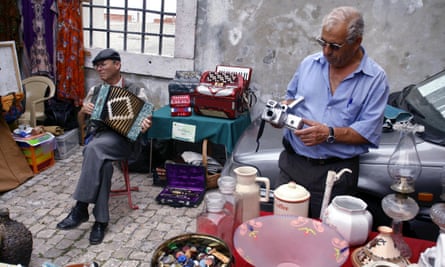
Do a classic Lisbon city-safari by taking the number 28 tram, which passes through the popular districts of Graça, Alfama, Baixa and Estrela. The trams are small, like wardrobes on wheels, to pass through the narrow streets of the oldest quarters. For many years, on Saturday mornings, I have been taking the 28 through the labyrinth of Alfama to Feira da Ladra, or Thieves’ Market. It is an open-air flea market overlooking the river: picturesque, colourful, swarming with people, yet surprisingly calm, where you can stroll, buy trinkets (cash only), and have lunch. It’s full of amazing things, from authentic antiques to authentic trash. Campo de Santa Clara, Tue & Sat, 9am–2pm
‘Typical’ restaurants

Portuguese cuisine is simple and honest. The fish is fresh from the ocean, the steaks juicy, the wine full-bodied. Lisbon’s old-school restaurantes tipicos , are easy to recognise, with meat and fish on ice, and paper tablecloths. My three favourites have become so popular I have to book, or even queue. They’re all in the same neighbourhood, so if I don’t get a table in one, I try another.
For the most exquisite grilled cod or octopus in green olive oil, go to Cova Funda , just off Intendente square; for the freshest shellfish, there’s Marisqueira Lis , just across the avenue; and for a charcoal grill, the Carvoaria Jacto steakhouse , two blocks away (the owner is a butcher, so he knows his meat). Whichever you choose, you’ll wine and dine well for under €20.
Take a walking tour

For several years now, a group of young people calling themselves the Lisbon Walkers have been taking locals and tourists on guided walking tour. It’s a lovely way to experience Lisbon. For beginners, there is a general tour, but things get more exciting when you choose to see Lisbon district by district. There are also special interest tours: medieval, African, Jewish, freemason, literary or underground Lisbon. My favourite tour is on legends and mysteries: two hours learning about Ulysses as the founder of Lisbon, the young martyrs of Lisbon and St Vincent and the ravens, for €15. Daily tours in English start from the meeting point in Terreiro do Paço, lisbonwalker.com
National Coach Museum

The collection of royal vehicles at the Museu Nacional dos Coches in Belem transports you back in time. The oldest vehicle , from 1619, brought Philip III of Spain to Lisbon to take over the throne; the last to be used drove a young Queen Elizabeth II to visit the Portuguese dictator Antonio Salazar in 1957. A trio of opulent coaches were made in 1716 and sent to Rome by the richest of all the kings of Portugal, João V “the Pious”, to show to the Pope how devout he was and how prosperous his empire. For a taste of Lisbon at the height of the inquisition, I recommend the novel Baltasar and Blimunda, by the Portuguese Nobel prize laureate José Saramago . It’s a story of love, miracles and flying machines. Avenida da Índia 136, €8, closed Monday
Lisbon Oceanarium

Oceanário de Lisboa is perfect for a rainy day. It’s home to water creatures of all kinds, shapes and sizes: colourful anemones and corals, sea-stars, fluorescent jellyfish, dragonfish, exotic frogs, penguins and playful sea otters. In the massive circular central glass tank swim large fish, such as sunfish, manta rays and sharks. It is in the hyper-modern Parque das Nações, the suburb built from scratch on the waterfront for Expo 1998, by the futuristic Gare do Oriente station. Open 10am–7pm, adult 16,20, child €10.80, buy tickets online to avoid queueing

Thirty minutes west of the city, the seaside resort of Estoril, with its Grand Casino , was founded in 1935 – for the amusement of Lisbon’s rich. At the beginning of the second world war, Lisbon was an important escape route from Europe, and nearby Estoril unexpectedly became an international destination for refugees. Its Hotel Palácio sheltered the likes of Salvador Dalí, Antoine du Saint-Exupéry , Ian Fleming, and the Duke and of Windsor and Wallis Simpson. As well as a lot of spies.
After the war the resort became a haven for exiled monarchs and dictators, who used to meet in the Palácio for Sunday lunch. Later, it became popular among celebrities, including Orson Welles, Gina Lollobrigida, Sophia Loren, Luchino Visconti and Zsa Zsa Gabor. Rooms in the Palácio, which is as elegant and pompous as ever, still carry their names. Some years ago, it was reported that restoration work in the hotel had uncovered kilometres of wiring left over from war espionage.
Today, Estoril is a quiet, wealthy seaside town with subtropical vegetation, golf courses and sandy beaches. It’s ideal for a day trip. Trains from Lisbon’s Cais do Sodré station depart every 30 minutes, €2.25 one way
Dejan Tiago-Stanković’s debut novel, Estoril is published by Head of Zeus, £12.99. To buy a copy for £11.04 with free UK p&p, go to guardianbookshop.com
Flights Easyjet and Ryanair fly to Lisbon from several UK cities from £82 return.
Where to stay In a classic early 20th-century building with tiled facade and wrought iron balcony, B&B Casa Amora (doubles from €115) is named after a Portuguese artist and has a sunny patio for breakfast or afternoon drinks.
Best time to go April-May and September-October: prices are lower but weather can still be beach-friendly.
Exchange rate £1 = €1.15 A small beer in a neighbourhood bar costs from €1.80, a coffee about €1.
- Lisbon holidays
- A local's guide
- Portugal holidays
- Europe holidays
- Restaurants
- Cultural trips
Comments (…)
Most viewed.
- Surfing in Lisbon: Best Surf Spots
- Surfing in Portugal: The Complete Guide
- Where to Watch the Sunset in Lisbon
- Best Botanical Gardens of Lisbon
- Tile Museum
- Gulbenkian Museum
- Mude: Design and Fashion Museum
- Ancient Art Museum
- MAAT Museum of Art, Architecture and Technology
- The Best Shops in Lisbon
- Lisbon: A Paradise of Souvenirs
- Feira da Ladra
- Most Magical Wineries Near Lisbon
- Food in Lisbon: Eat Like a Local
- Time Out Market Lisbon: A Food Lover’s Paradise
- 11 Delicious Portuguese Breads
- Best Restaurants in Lisbon
- One Day in Lisbon: A Complete Itinerary
- Two Days in Lisbon: A Complete Itinerary
- Three Days in Lisbon: A Complete Itinerary
- 1 Week in Lisbon: A Complete Itinerary
- Lisboa Card: All You Need To Know
- Tagus River Lisbon
- Lisbon Belem District: Travel Guide
- Lisbon Alfama District: Travel Guide
- Lisbon Baixa District Travel Guide
- Parque das Nações
- Lisbon Cais do Sodre District
- Lisbon Principal Real District
- The Best Family Hotels in Lisbon
- Hotels in Lisbon with A Rooftop Terrace
- Glamping in Portugal: The Ultimate Guide
- Best Hotels in Lisbon
- Cheap Hotels in Lisbon
- Boutique Hotels in Lisbon
- Luxury Hotels in Lisbon
- Best Lisbon Hotels with Swimming Pools
- Living in Lisbon: All You Need to Know
- What Language is Spoken in Portugal?
- Is Lisbon Safe?
- Transportation
- Buying Property in Portugal
- Portugal Golden Visa

The Ultimate Lisbon City Guide for 2024
Lisbon is the capital city of Portugal. With its population of over 505 thousand people, it is the 11 th most crowded city amongst European Union cities. Lisbon’s population constitutes over a quarter of the total population in Portugal. The city is one of the most popular tourist destinations in the world. As a result, Lisbon’s Humberto Delgado Airport welcomes more than 20 million visitors per year.
Historically, Lisbon is one of the oldest cities in Europe. Under the Phoenicians’ reign, Lisbon was used as a trade port with its strategic location during 1200s BC. The city that spent several centuries under Rome’s reign and then several centuries under Muslims’ reign offers many antique beauties to its guests.
Apart from its historical attractions, Lisbon also offers a vibrant, modern city life with attractions for both who seek peace and adventure. The city’s nightlife is among the bests of Europe.
Why Lisbon?
Lisbon is a city that combines its cultural and historical heritage with its modern city life very well. Packed with significant traces of Phoenician, Roman and Moorish influences, the capital has no shortage of historical and cultural context that may lure visitors from everywhere and all ages. Also, Lisbon has a vibrant nightlife which caters to the younger visitors. For people who seek fun and adventure in their journeys, Lisbon has something to offer any moment of the day. Portuguese cuisine is not one of the most famous cuisines in the world; however, -especially in terms of seafood- Lisbon has many delicacies to offer. The city even has great beaches to spend time under the sun in the beautiful Mediterranean climate.
Thus, Lisbon is a destination where everyone can enjoy their time. Involving cultural, historical, and artistic attractions together with the modern activities and paradisal beaches, the Portuguese capital offers a whole package to its visitors.
Where to Visit in Lisbon?
Lisbon has several districts that are especially popular among tourists. These are the historical and cultural centers of the city. Namely Belem, Bairro Alto, Alfama, Estrela, Chiado, Sao Bento, and Baixa are the places where tourists spend most of their time. City’s important artifacts, buildings, museums, and attractions are mostly concentrated in these neighborhoods.
In Baixa, there is everything including top-quality restaurants, great shops, and clubs. Chiado is the next-door neighbor of Baixa where art galleries and design workshops dot the area. Bairro Alto is the place where the city’s vibrant nightlife is focused. There are also many bars with live music and street art pieces in the district. Alfama is the picture-perfect neighborhood of Lisbon that often shows off in postcards. With its narrow streets, Azulejos buildings, and tram numbered 28; Alfama takes its visitors back in time. Belem is a bit far from the city center but a traveler needs to stop by here. Famous Belem Tower, Jeronimos Monastery, and Padrao Dos Descobrimentos are located here.
When to visit Lisbon?
Lisbon, typically, is under the influence of the Mediterranean climate with mild winters and hot summers. Lisbon having an ocean coast makes the capital a little milder which results in longer summers. In June, July, August, and September, air temperature is usually around 35 C degrees. During summers, Lisbon is full of robust festivals, activities, and concerts. To experience the city’s essence fully, summer would be the best time to visit Lisbon. April and May are also good times to visit since there are festivities during these months, too. Also, the weather is quite nice during spring in Lisbon. However, these attractions cause the city to get crowded with tourists. Visitors from all around the world rush to the beautiful capital. Hence, visiting Lisbon in winter might mean missing the outdoors activities of the summer, but it also means that the city will be much less crowded and open to be explored.
When to go in Lisbon Winter in Lisbon Rainy Day in Lisbon
How Long to Spend in Lisbon?
Lisbon, as said, offers so much to its visitors that it is hard to put a timeline as to how long would be the ideal trip to this beautiful city. If the aim is to merely see everything in Lisbon, a few days might be enough. Yet, if the visitors want to experience the city to the fullest, every activity needs its own time.
In 24 hours, tourists might arrange a program involving Bairro Alto, Alfama, and the Lisbon Castle with plenty of time to spend in each. If there is an extra day, Baixa and Chiado districts may be added to the program with a small trip to Belem. If the journey is for three days, visitors might enjoy a night out at Bairro Alto and spend some more time in Belem with a few additional visits. One week is probably the ideal period for a fulfilling Lisbon trip. During this period, visitors may feel the atmosphere of Lisbon wholly while being able to spare enough time to each destination in the city.
A Budget-Friendly Guide for Lisbon
Transportation in Lisbon
Lisbon has a good transportation network that connects every part of the city with reasonable fees. A rental car might of course be needed when traveling into regions in-depth with inefficient public transportation, but in general, public transportation of Lisbon should be enough to take tourists everywhere.
Lisbon’s famous yellow streetcars are the most popular transportation option within the city. These vintage cars connect the city’s narrow and acclivitous streets. These cars have been working for the city’s transportation for almost 150 years now. One trip tickets for these cars cost 2.90 euros. So, it would be more logical to buy daily tickets which cost around 6 euros. Lisbon’s subway network is not highly developed, but it is efficient. However, to be able to travel through the city’s unique atmosphere, the subway is not the ideal choice. City’s more developed bus network might be a better idea when it comes to observing the city during trips. One trip tickets for the metro costs 1.40 euros and costs 1.80 euros for the buses.
Lisbon’s Trams Lisbon Metro Guide
Aerobus in Lisbon Lisbon Ferry Guide
Beaches of Lisbon
When it comes to capitals, it is often very hard to find clean, untainted, and quiet beaches around. However, Lisbon, with its long coastline, does not lack superb beaches either. Especially on the west coast of the city, there are many beaches. The climate of the city allows the weather to be nice and warm throughout the summer. Therefore, the city’s atmosphere is quite fitting for summer getaways. The city has many beautiful beaches which are easy to be reached from the city center. Most of these beaches do not need more than one hour from anywhere in Lisbon. In these beaches, tourists can have a drink, eat delicious meals, read their books, walk, swim, surf and enjoy the good weather. Some of the most famous beaches of Lisbon are Cascais, Praia do Guincho, Praia do Cresmina, and Costa Caparica.
Lisbon’s Beaches Beaches in Cascais
Silver Coast Portugal Surfing in Portugal
What to Eat in Lisbon?
While not a very famous one, Portuguese cuisine is delicious. Neighboring French and Spanish cuisines are far more famous than the Portuguese. However, it does not mean that Portuguese cuisine is not existent. Most of this cuisine consists of rice and potato-based meals. Usually, casseroles, grilled meat, and some fish accompany rice and potatoes. Barbecued sardine and pork stew are some of the essentials of Portuguese cuisine. Bacalhau, Francesinha, Cozido a Portuguesa, Pastel de Nata and Bola de Berlim are some of the most famous dishes of Portuguese cuisine. Portugal also has its coffee named Galao, which must be tried without leaving Lisbon
Where to Eat Best Restaurants in Lisbon
Quality of Life
The capital of Portugal is a shining star on the west coast of the Continent. People from all over the world fly to this beautiful city, sometimes as new residents, sometimes as tourists. One thing is certain though, Lisbon never ceases to amaze. Compared to a lot of the other popular capitals of the world, Lisbon’s quality of life is exemplary. The city offers minimal traffic, amazing and efficient transportation options, plenty of beautiful parks and playgrounds for children. For families, Lisbon is a great option to consider both for living and vacation.
How Safe & Sound is Lisbon?
Neighborhoods of Lisbon are planned efficiently also. Each one carries the qualities of a small city. It is very likely to have everything within walking distance. Also, most of the locals speak very good English. So, the language and communication will not be a big problem for visitors. Many other small perks make day to day life much easier. How long it takes to travel to work or school, where to find quality food, where to entertain the kids are all problems that are more than usual in popular capitals. Yet Lisbon outclasses other capitals in each of these characteristics.
Cost of Living in Lisbon
Portugal is a member of the European Union, and is in the Eurozone, which means that the country’s official currency is Euro. This is always a disadvantage for countries that use other currencies. However, Lisbon is one of the most reasonably priced capitals tourists may ever go to, especially in Europe. It is possible in Portugal to drink a cup of coffee for around 1,5 to 3 euros. A meal in a medium quality restaurant would cost around 8 to 15 euros and a beer usually costs around 2 euros. For museum entrances and transportation fees, tourists can obtain a Lisboa Card which has different versions for 1 day, 2 days, or 3 days. These cost differently, but definitely worth the money. Lisboa Card can be obtained at the airport.
Day Trips from Lisbon
Lisbon is surrounded by natural wonders, ancient ruins, historical monuments, and magical castles. Many beauties around the Portuguese capital wait to be explored by the tourists. These destinations are within a very close range of Lisbon by any means of transportation. Some of the city’s best beaches are among these destinations together with charming villages that take visitors back in time. Also, these places usually are stripped from the capital’s crowd. In peace, many spots around Lisbon are day trip options. Some of them are Sintra, Palacio Nacional de Queluz, Cascais, Evora, Batalha, Fatima, Costa de Caparica, Serra de Arrabida, and Sesimbra.
One Day in Lisbon Two Days in Lisbon
Three Days in Lisbon 1 Week in Lisbon
What to Pack for Lisbon
What to pack for Lisbon, of course, differs according to the season. Considering that the most popular tourism period of the capital is summer, the essentials of the backpack are light items. Several t-shirts, shorts, skirts and swimsuits are musts of the list. Ocean winds of the capital might make the weather cool at nights even in summers. So, it would be a good idea to pack one or two jackets just in case. Considering the amount of sunny days, a hat and a powerful sunscreen are not to be forgotten before the trip. Finally, a smaller pack for daily use would be ideal since traveling around with a huge backpack might take the joy out of the trip.
Enjoying Lisbon
Lisbon is a city that knows how to have fun. Therefore, just getting along would probably result in an awesome vacation. Lisbon has lively activities at night as much as it has in the daylight. Portuguese people –as many people around the Mediterranean- love to eat, drink and have fun. It means that if the tourists can get a glimpse of the colorful population of the locals, they need not bother looking for eccentric activities around.
What to do in Lisbon: 40 Essential Activities
To enjoy Lisbon to the fullest, it is essential to breathe the air of the city which is full of history, art, literature, and music. No Lisbon trip is ever finished without a trip to beaches, to Gulbenkian Museum, to a restaurant with the company of Fado, to a coast diner, and to narrow cobblestone districts of the city with its picturesque yellow streetcars.
Moving to Lisbon
Lisbon is a popular destination for people from all around the world to move to these days. The relocation reasons may vary from career moves to education or retirement, among many others. Though, what is stable is the hospitality of the Portuguese people against those who decide to move to Portugal. There are many ways to arrange for a residence permit in Portugal. In case you are an EU citizen, you automatically get the right to reside in Portugal. If not, Portugal’s residence by investment program has been on the rise in recent years; you can read more about the Portugal Golden Visa. Some other options for non-EU citizens include the D7 Visa or your company or your Portuguese spouse to sponsor you.
Jobs in Portugal for Foreigners Buying Property in Portugal

Palaces and Castles in Lisbon

Portugal Golden Visa Ending: Not Exactly

Online Shopping in Portugal

Portugal Festivals

Portuguese Culture and Traditions: A Journey Through the Wonders

Hotel Mundial in Lisbon

Bairro Alto Hotel in Lisbon

Hotel Tivoli Avenida Liberdade Lisboa

Lisbon Events in 2023

Lisbon Guide For LGBTQ+ People
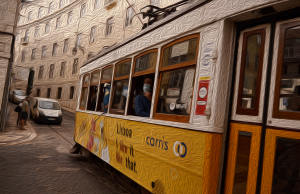
Portuguese Food: All You Need To Know
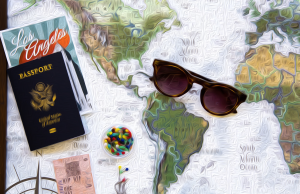
Portugal Digital Nomad Visa
Most Popular Lisbon Articles
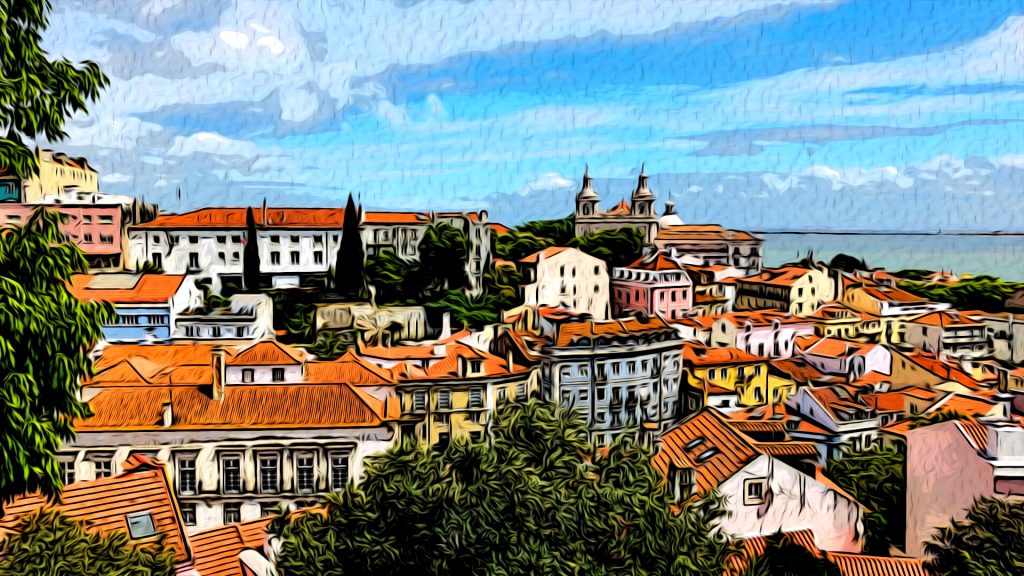
Portugal Citizenship by Investment: All You Need to Know
A Brief Introduction of Portugal Portugal is a country in Southwestern Europe, right by the Atlantic. This majestic country has attracted tourists and expats for decades. The Algarve region, also known as the “Golden Coast,” has long earned a well-deserved spot on any “Best Places to Visit” guide. Its pristine beaches, year-round warm weather, luxurious […]

The Best Boutique Hotels in Lisbon
Boutique hotels can be the best places to feel at home while still enjoying the local texture of Lisbon and luxury. Below you can find out top picks of boutique hotels in Lisbon for your upcoming travel. Esqina Cosmopolitan Lodge In “Esqina Cosmopolitan Lodge”, you will not only have a great boutique hotel experience, but […]
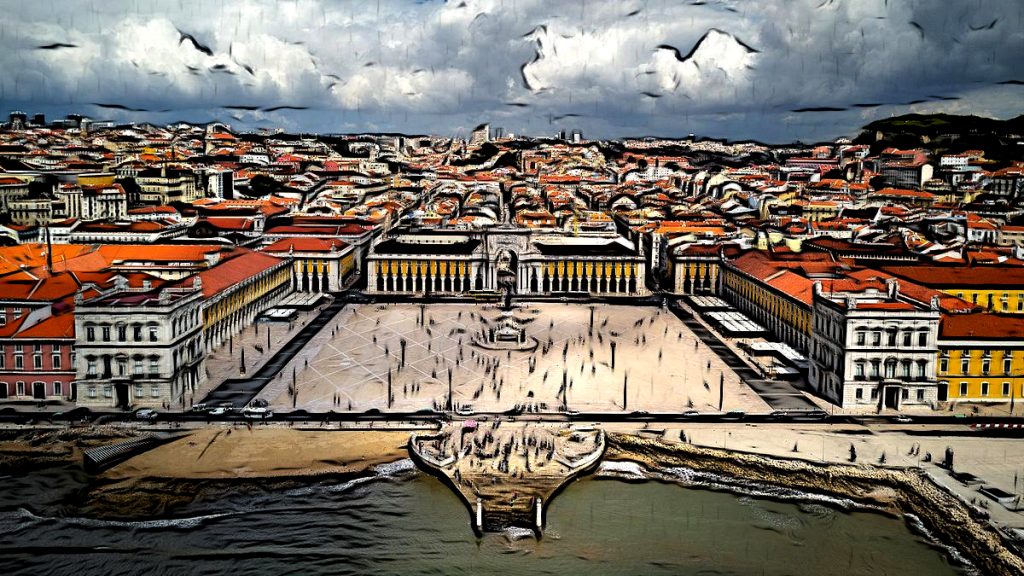
Praça do Comércio Facts
Praça do Comércio means “Trading Square” and as you might expect from the name, it is the host of many historical trading centers. Praça do Comércio’s Historical Background Manuel I, the ruler of Portugal, built a residence here to be away from the city walls. In time, buildings related to trade were added to this […]
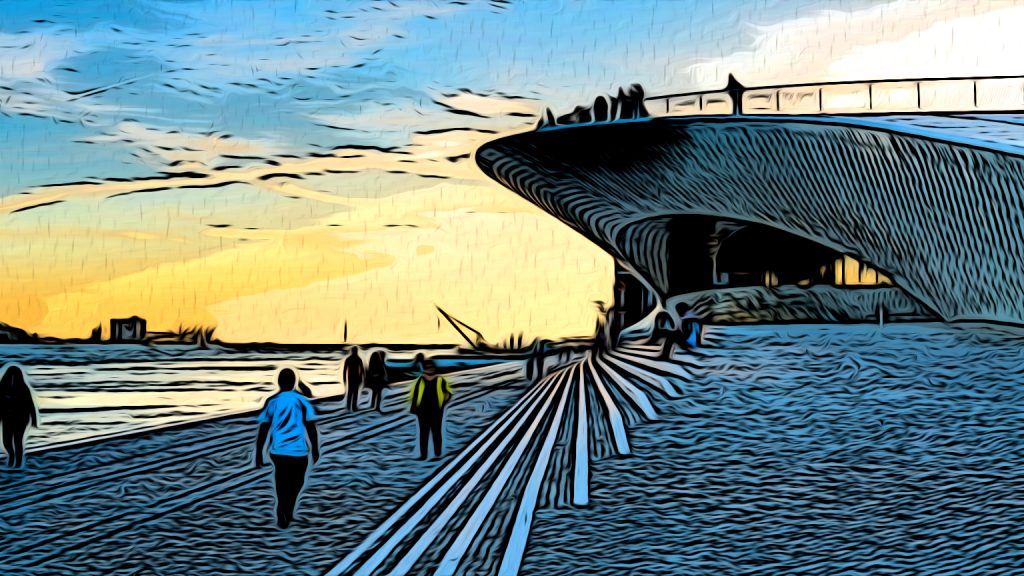
Museum of Art Lisbon: MAAT
If you’re searching for an awe-inspiring museum on the shore of Lisbon, look no further than the Museum of Art, Architecture, and Technology (MAAT). Designed by the renowned British architect Amanda Levete, MAAT opened its doors in 2016 and has been a must-visit destination for art and architecture enthusiasts ever since. Built next to a […]
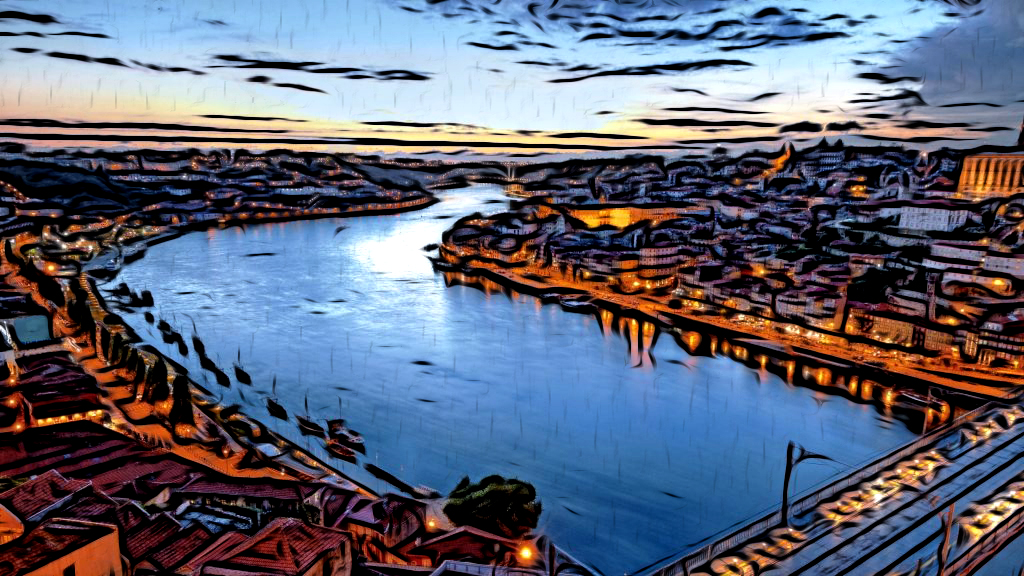
Best River Sights in Lisbon
Lisbon, among many other features, hosts a part of the Tagus River that rises from Spain and flows into the Atlantic Ocean from Portugal. Tagus River is the longest river of the Iberian Peninsula with a length of 1038 kilometers. Around the quarter of the total length of the river is inside Portuguese territory, and […]
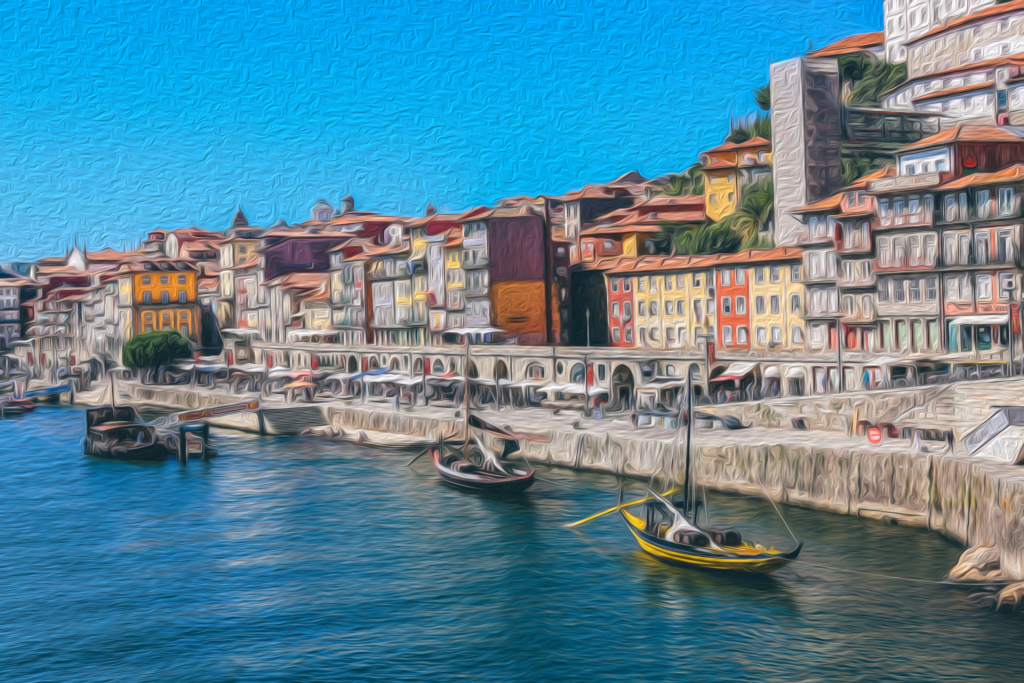
Portugal Visa Types
Portugal provides several visa types for individuals planning to live in the country. Portugal visas include a qualified worker visa, startup visa, or even a student visa. The country also offers a Golden Visa that provides a second residency through investment. You’ll find more about the residency permit types as well as Portugal immigration visas […]
Latest Articles
- Eat & Drink
- Living in Portugal
- Neighborhoods
- See & Do
Driving in Lisbon & Portugal: The Complete Guide
Where to stay in lisbon – best hotels and neighbourhoods, 10 of the most romantic hotels in lisbon, michelin-starred restaurants in portugal for 2024, packing list for portugal – don’t forget a few essentials, 5 of the best fado restaurants in alfama, a view from vasco da gama tower, lisbon’s tallest building, lisbon shopping: the complete guide.

If you are planning to drive in Lisbon, you should get familiar with the driving requirements in Portugal, as well as the basics of rules of the road, hiring a car and finding parking in the city centre.

Discover Lisbon’s neighbourhoods and some of the best hotels to stay in Lisbon. Use this guide to decide where to stay based on three top criteria: price, quality and location.

There are plenty of Lisbon hotels to dazzle that special someone whatever the occasion. For a romantic weekend or Valentine’s Day, here’s a selection of ten of the best romantic hotels in Lisbon, Sintra and Cascais.

The list of starred restaurants in Portugal has just been updated. There are currently eight Portuguese restaurants boasting two Michelin star status, and 31 restaurants have been awarded one star in the 2024 edition.

Are you packing your suitcase for Portugal? Whether you go to Lisbon, Porto, the Douro valley, or the Algarve, use this helpful checklist to make sure you don’t leave home without those needed items.

Reserve an evening to sample the Portuguese fado and traditional cuisine. From amateur fado to well-known fado singers, Alfama is the best area to soak up Lisbon’s aesthetic melancholy.

Lisbon is a gorgeous city with a glittering waterside location that is worth seeing from Vasco da Gama Tower, Lisbon’s tallest building.

Lisbon is a great place to go shopping and discover big brands, historic stores and flea markets. Find fashion, antiques, or a bargain with our guide to the best shopping centres and neighbourhoods in the Portuguese capital.

Looking for a Central but Quiet Hotel in Lisbon? Look No Further
If you’re looking for a quiet place to recharge batteries while visiting Lisbon, see our recommendations for peaceful but centrally located hotels around the busy Marquês de Pombal roundabout, just outside the old town.

Michelin-Starred Restaurants in Portugal for 2023
Michelin announced its 2023 stars for Portugal – this year there are five more awarded restaurants, which is quite an accomplishment, but unfortunately still no three-star restaurants.

Surfing and Kitesurfing around Lisbon: The Best Places to Go and Get Lessons
Explore the best beaches around Lisbon to catch some awesome waves, including schools where you can learn to surf and kitesurf, or get to the next level. You’ll find spectacular stretches of Atlantic coast not far from the capital.

Lisbon Jazz in August: A Festival Not to be Missed
Jazz in August at the Gulbenkian is Lisbon’s biggest music festival devoted to the jazz genre. This year the festival brings the best and freshest music to the Portuguese capital.

Encanto, a New Vegetarian Restaurant in Lisbon
Opened by celebrated Portuguese chef José Avillez, Encanto is based on the beauty and flavours of vegetables. The vegetarian tasting menu includes 12 moments, offering a unique dining experience.

Michelin-Starred Restaurants in Portugal for 2022
The Michelin awards ceremony for Portugal has revealed five new additions with single stars, dotted across the country. All the awarded restaurants from the previous edition have retained their stars.

Lisbon in July: A Guide to the Gorgeous Sun-Kissed Coast
T hinking about heading to lisbon in july in my opinion, lisbon is perfect any time of year but there’s something about summer in portugal that is just perfect. let’s get into everything you need to know.
This article may contain affiliate links . If you purchase through these links, I may earn a small commission at no cost to you. Thank you for your support!
Welcome to Lisbon in July
I have visited Lisbon several times, drawn by the beautiful architecture and amazing food. During the summer, the city unfolds like a vibrant canvas, brushed with the hues of cultural heritage and summer festivities. For anyone seeking the perfect time to explore the Atlantic coast, July stands out as a great choice.
The city center is alive, with the sounds of live music from Bairro Alto and beyond. This period offers the best beaches along the Lisbon coast, from Praia de Carcavelos to the sandy stretches of Costa da Caparica. In my experience, the blend of high temperatures and balmy evenings provides the ideal backdrop for both outdoor activities and leisurely explorations. Embarking on day trips to locales like Cabo da Roca reveals the sheer beauty of Lisbon’s coastal areas, making every visit an unforgettable adventure.
Key Takeaways:
- Lisbon in July is vibrant , showcasing a mix of cultural festivities and natural splendor.
- Outdoor activities and beach visits are perfect under the July sun, with numerous options available.
- Day trips around Lisbon offer a glimpse into the breathtaking Atlantic coast and its surroundings.
Why July is the Best Time to Visit Lisbon
July is a prime time for visiting Lisbon. High temperatures beckon travelers to the sandy beaches of the Lisbon coast, where the sea temperature invites long, refreshing swims. Praia de Carcavelos and Costa da Caparica become vibrant havens of outdoor activity, their shores packed by both locals and visitors seeking respite from the city’s buzz.
The average high teeters around the perfect mark for exploring, not too scorching to hinder day trips or sightseeing ventures. Lisbon during July is less about battling the heat and more about embracing the plethora of opportunities it presents.
From early morning walks along the Tagus River to late nights filled with live music in Bairro Alto, the city pulses with energy, its atmosphere imbued with a sense of adventure and discovery encouraged by the mild weather. This month turns the capital city of Portugal into a canvas of unique experiences and more hours of sunshine than any other time of the year.
Exploring the Atlantic Coast
The Lisbon coast is especially appealing in July. The beaches, with their soft sands and proximity to the Atlantic Ocean, are ideal for a variety of activities. Costa da Caparica, a notable stretch along the Atlantic, provides an excellent setting for beach outings, enjoying the mild ocean breeze.
Beyond beach relaxation, the area offers attractions including scenic sunsets and water parks, catering to both tranquil and active pursuits.
Day Trips from Lisbon
Lisbon’s July weather is ideal for visiting the nearby coastal regions. Cabo da Roca, Europe’s westernmost point, is a notable day trip destination. The cliffs offer dramatic views as they drop into the Atlantic Ocean, providing a memorable experience enhanced by the fresh sea air.
Another destination to consider is the Serra da Arrábida. Known for its pristine beaches, this area is surrounded by hills lush with greenery, creating a tranquil retreat. July’s warm temperatures are perfect for outdoor activities, such as scuba diving, hiking the scenic trails or relaxing on the secluded beaches, making it a pleasant escape from Lisbon’s urban pace.
Taking a day trip to Porto from Lisbon in another option and offers a splendid opportunity to explore Portugal’s northern charm. Just a three-hour train ride away , Porto greets visitors with its majestic Douro River, iconic tiled facades, and the famous Port wine cellars.
Spend your day wandering through the picturesque Ribeira District, tasting authentic Portuguese cuisine, and exploring the historic São Bento railway station with its stunning azulejo murals. A day trip to Porto is a perfect way to experience the diversity of Portuguese culture and scenery in a short span of time.
Unmissable Outdoor Activities
In July, Lisbon transforms under the intense summer sun, offering a paradise for lovers of the outdoors. Beaches along the Lisbon coast, such as Praia de Carcavelos and Costa da Caparica, beckon with golden sands and inviting sea temperatures. Surfing here catches the right waves, making it an essential activity for thrill-seekers. Hiking trails wind through the Serra da Arrábida, unveiling panoramic views of the Atlantic Ocean that remain etched in memory long after.
- Surfing at Praia de Carcavelos offers the chance to ride the Atlantic’s powerful swells.
- Hiking in Serra da Arrábida reveals breathtaking landscapes and a closer look at Lisbon’s natural beauty.
- Exploring coastal towns like Cascais presents an opportunity to immerse in Portuguese culture and savor fresh, local cuisine.
The warmth of Lisbon in July sets the stage for days filled with adventure and nights echoing with the sounds of Fado music from the heart of Bairro Alto, making every moment unforgettable.
Lisbon’s Nightlife: Bairro Alto and Beyond
Bairro Alto is at the center of Lisbon’s nightlife, known for its lively atmosphere and diverse entertainment options. The area is filled with live music, ranging from traditional Portuguese fado in intimate venues to contemporary hits played by DJs in vibrant bars. This variety ensures that there’s something for every taste.
Venturing outside of Bairro Alto, Lisbon’s nightlife continues to impress with its array of venues hosting international artists. These outdoor concerts and cultural events offer a chance to experience the city’s diverse cultural scene under the summer stars. For visitors, immersing in this vibrant nightlife scene is a crucial part of experiencing Lisbon in July.
Culinary Delights: What to Eat
July’s warmth invites an exploration of vibrant flavors. Among the dishes, bacalhau, a salted cod specialty, stands out. I found it served in numerous variations, each more enticing. Another must-try is the flavorful sardines, especially grilled ones that bring a hint of the Atlantic into every bite.
For those with a sweet tooth, pastéis de nata, creamy custard tarts, had been a revelation. These delights make a perfect treat on a balmy Lisbon evening.
Cultural Festivals and Events
In July, Lisbon comes alive with vibrant cultural festivals and music events that are a magnet for both locals and tourists. The city’s rich cultural tapestry unfolds in an array of colors, sounds, and flavors, making it an unforgettable time of the year to visit.
- Super Bock Super Rock : This legendary music festival gathers international and local acts. Think of it as a rite of passage for music lovers. Here, the intense summer sun meets the cool nights filled with electrifying performances.
- Meo Marés Vivas: Showcasing a mix of genres, from pop to rock, it’s one of the biggest music festivals in Portugal.
- Folk Music on the Atlantic Coast: Various locations along the Lisbon coast came to life with folk music, celebrating Portugal’s rich heritage. Coastal areas become stages for heartfelt performances, echoing traditional sounds against the backdrop of the Atlantic Ocean.
These events, each in their unique way, contribute to the lively atmosphere that defines Lisbon in July. They invite you to dive into the culture, enjoy the balmy evenings, and experience the city’s spirit in full swing.
Tips for Travelers: Weather, Packing, and More
Dressing appropriately for Lisbon’s sunny July weather is crucial. High temperatures and intense summer sun demand lightweight, breathable clothing to keep you comfortable while exploring. Wear sunblock generously during the day. This will fend off sunburns, particularly during long walks on the beach or tours around the city center. For the cooler, balmy evenings, carrying warm clothes can prove beneficial.
Staying hydrated is another key concern. The high temperatures and long days under the sun mean that dehydration can quickly become a risk. Always pack a reusable water bottle to refill throughout your adventure. This simple step ensures you remain energized and hydrated, making every moment of your holiday count.
To maximize your experience despite the high temperatures, start outdoor activities in the early morning. This takes advantage of lower temperatures and fewer crowds at major attractions and beaches like Praia de Carcavelos and Costa da Caparica. Planning day trips around these cooler hours also allow for a more pleasant exploration of the Lisbon coast and its scenic beauty.
Finding Accommodation: Where to Stay
Lisbon, in the heart of July, transforms into a bustling hub for tourists drawn by its golden beaches and vibrant nightlife. Accommodation prices reflect this peak season, yet the value provided makes every Euro spent entirely worthwhile.
Options range broadly to cater to diverse tastes and financial plans. You will find luxury hotels with panoramic views of the Atlantic Ocean, offering an unparalleled experience of comfort and elegance. These typically situate you near major attractions, reducing the need for extensive travel.
For those watching their budget more closely, Lisbon’s hostels present a cost-effective alternative. They are not only affordable but also offer a chance to meet fellow travelers. Some even boast locations that rival their pricier counterparts, placing you steps away from sandy beaches and lively city squares.
Holiday homes and apartments serve as the middle ground, combining the privacy and amenities of a personal residence with the excitement of being on the Lisbon coast. Booking online could secure you a deal, even during these busy weeks.
Personally, I always stay in the Baixa or Rossio neighborhoods when I’m in Lisbon. They have the best-priced hotels and awesome restaurants. You’re also centrally located with the metro and trams nearby.
Frequently Asked Questions about Lisbon in July
Is july a good month to visit lisbon.
Yes, July is a great month to visit Lisbon. The weather is warm and sunny, perfect for exploring the city and its surrounding coastal areas.
Is it too hot to visit Portugal in July?
While July is one of the hottest months in Portugal, the coastal breezes in places like Lisbon help to moderate the temperatures, making it quite pleasant. However, it can be quite hot inland, so it’s advisable to prepare for high temperatures if traveling away from the coast.
Is Lisbon expensive in July?
July is peak tourist season in Lisbon, which can mean higher prices for accommodations and some services compared to off-peak times. However, by booking in advance and looking for deals, you can manage expenses effectively.
What’s happening in Lisbon in July?
July is a vibrant month in Lisbon, filled with activities and events. From outdoor music festivals and concerts to local feasts and markets, there is plenty to do and see, showcasing the city’s lively cultural scene.
What to wear in Portugal in July?
Lightweight, breathable clothing is recommended for Portugal in July due to the warm weather. Bring items like shorts, t-shirts, a hat, sunglasses, and sunscreen for daytime, and a light jacket or sweater for cooler evenings.
What time is sunset in Lisbon in July?
In Lisbon, sunset times in July are typically around 9:00 PM, giving you long, sunny days to enjoy the city.
Embracing the Warmth of Lisbon in July
In conclusion, experiencing Lisbon in July is a captivating adventure that showcases the vibrant spirit of this coastal city at its peak. From the bustling nightlife and picturesque beaches to the serene sunsets and festive events, there’s no shortage of ways to immerse yourself in the local culture.
Whether you’re exploring historic sites, enjoying the culinary delights, or simply soaking in the lively atmosphere, Lisbon in July offers a unique blend of activities and experiences that make it a must-visit destination for any summer traveler.


IMAGES
VIDEO
COMMENTS
Lisbon oozes with history, but it's also been home to a meaningful renaissance as of late. Discover the best local spots in this Lisbon travel guide. Lisbon Travel Guide - Everything You Need To Know | Goop
Lisbon oozes with history, but it's also been home to a meaningful renaissance as of late. Discover the best local spots in this Lisbon travel guide. The Lisbon Guide - Stay | goop
One of the world's most deadly earthquakes occurred on 1st of November, 1755. Unfortunately, because of this, there were fires and, consequently, a tsunami. Some of the city recovered, and some of it did not. From 1932-1974, Portugal was overrun by a dictator, António de Oliveira Salazar.
Planning Your Trip. Best time to visit: Lisbon boasts 290 days of sunshine. . , but the best times to visit are spring and fall. The weather is warm and stable, lines at attractions are shorter, and accommodation prices are at their lowest. Language: The official language is Portuguese. .
Top 5 Things to See and Do in Lisbon. 1. Walk around the Old Town. Alfama, the historic area of Lisbon, is filled with narrow, winding streets lined with shops, cafes, and restaurants. The name, meaning "hot springs," comes from the Moors who conquered here in the 8th century.
Wandering through the winding cobblestone streets of Portugal's colorful capital, it's easy to fall in love with Lisbon. While you're lounging in a leafy plaza and sipping the world-class local wine as you overlook the Atlantic, you'll decide that you never want to leave. With a rich history and fascinating culture, you could spend a ...
Guide Editor. Kevin Raub is a Lisbon-based travel and entertainment journalist. Rita Alves was born in Lisbon and deeply loves the city. Read Before You Go. Cities We Love. 11 Things to Do and See in Lisbon, Portugal's Capital City. From visiting old castles to eating egg custards, here are the 11 best things to do in Lisbon.
The best things to do in Lisbon, moreover, may surprise and delight even the most seasoned travelers. Lisbon, Portugal is a city with a lot of grit, history, and finesse. Accordingly, our Lisbon Travel Guide touches on all the senses. Below, we spotlight the best things to do, see, eat, smell, witness, and explore in Lisbon, Portugal.
Phone: (351) 21-887-2746. Website. With its bubblegum pink façade and the line out the door on the weekends, it's hard to miss Augusto Lisboa. This dreamy, details-forward restaurant may only ...
The MONOCLE Travel Guide Series: Lisbon. Previously described as a "travel-culture" magazine, and with stores sporting one-of-a-kind travel items, it is no surprise that Monocle's guide to Lisbon is sleek, minimalist, and well designed. The guide is based around a system of symbols to guide you through the sectors (H for Hotels, R for ...
Skip to main content
This Lisbon travel blog is a complete guide with everything you need to know plus the ultimate 3-day itinerary including free walking routes along the best places to visit and the Lisbon highlights. Find some useful Lisbon travel tips about the public transport, optional things to do in Lisbon, where to eat and the best place to stay for your ...
Martim Moniz. Lisboa 1100-341, 1100-393 Buenos Aires. This is the place to visit if you are looking for a multicultural neighborhood that is getting better and safer every day that passes. Near Mouraria, once a degraded neighborhood, you will find Martim Moniz's Square—full of life, with many kiosks with esplanades, serving food and drinks ...
You can get a combined entry ticket for MAAT and Tejo. If you have a Lisbon Card, you can get a 15% discount. 24. Discover the southern riverbank. map location - Cais do Sodré station (take the ferry here) Almada [ map location] is just across the river from central Lisbon, but don't worry, it's very easy to get to.
10 Reasons Why You Should Go to Lisbon. CULTURE: It's one of the world's great historic cities, with characteristic and surprising sights, cultural treasures, and a beautiful setting that make it a paradise for walkers and photographers. VALUE: It's one of Europe's best values -- officially Western Europe's least expensive capital.
A ssemble a city-break destination from a wishlist of components and you get Lisbon: a wide glittering river, limpid skies, steep cobbled streets, palaces, churches (and a castle, of course ...
Trains from Lisbon's Cais do Sodré station depart every 30 minutes, €2.25 one way Dejan Tiago-Stanković's debut novel, Estoril is published by Head of Zeus, £12.99.
The Ultimate Lisbon City Guide for 2024. Lisbon is the capital city of Portugal. With its population of over 505 thousand people, it is the 11 th most crowded city amongst European Union cities. Lisbon's population constitutes over a quarter of the total population in Portugal. The city is one of the most popular tourist destinations in the ...
Lisbon Shopping: The Complete Guide. Lisbon is a great place to go shopping and discover big brands, historic stores and flea markets. Find fashion, antiques, or a bargain with our guide to the best shopping centres and neighbourhoods in the Portuguese capital. Looking for a Central but Quiet Hotel in Lisbon?
Planning Lisbon first time travel? This Lisbon Travel Guide has all you need with the 15 Know Before You Go Lisbon travel tips, including tips on getting to ...
We travel to local and international cities looking for bucket-list meals, hotels, and experiences so that you can make the most of your travel (and PTO). Travel: City Guides, Itineraries, & Travel Tips & Recommendations | Goop
Taking a day trip to Porto from Lisbon in another option and offers a splendid opportunity to explore Portugal's northern charm. Just a three-hour train ride away, Porto greets visitors with its ...
Published on: May 2, 2024. The greatest secret of Carmel-by-the-Sea isn't its storybook charm or its delightfully misty weather, although both of those are good reasons to visit. It's how stealthily cool this town has become. What was good before—the beach, the cottages, the slow pace—is all still good. But new players make Carmel even ...